DeLaval feed pushing robot OptiDuo
DeLaval milking robot VMS

• DeLaval manure robot series




Dairy Matters
‘Road to nowhere on a bike with no chain’




Pages 14 -15
GRASSLAND
The latest growing and management advice

Pages 36-50
ANIMAL HEALTH

A look at summer welfare and disease protection
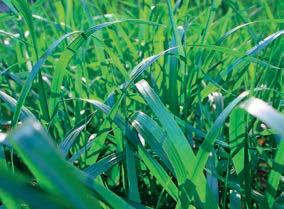

Pages 51-63

ON FARM FEATURE
So

Pages 10-12
MILK PRICES
Pages 68-70

Dairy herd plays a pivotal role in expanding business TIP



you can spend your time on what really matters. MAKE YOUR TEAM COMPLETE Find out more
–
OF THE MONTH: Water issues
monitor quality and quantity – p54
DAIRY FARMER
May 2023 Volume 70 Issue 5
TRUSTED INSURANCE FROM THE UK’S LEADING RURAL INSURER
With over 110 years’ farming experience and expertise, we’re here to put your mind at ease. Whatever cover you choose from us, you can be sure of a high level of protection.
To see how our policies and services can benefit your farming business, search ‘NFU Mutual Farming’ or contact your local agency office.

The National Farmers Union Mutual Insurance Society Limited (No. 111982). Registered in England. Registered Office: Tiddington Road, Stratford-upon-Avon, Warwickshire CV37 7BJ. Authorised by the Prudential Regulation Authority and regulated by the Financial Conduct Authority and the Prudential Regulation Authority. A member of the Association of British Insurers.
Contacts
Editor Katie Jones 07786 856 439 katie.jones@agriconnect.com

Content Editor/Designer
Mike Begley 01772 799 405 mike.begley@agriconnect.com

Picture Editor
Marcello Garbagnoli 01772 799 445 marcello.garbagnoli@agriconnect.com
Head of Commercial Solutions
Mike Hartley 01772 799 532 mike.hartley@agriconnect.com
Account Manager
Mark Jackson 01322 449 624, mark.jackson@agriconnect.com
Classified Advertisements 01772 799 400 fgclassified@agriconnect.com
Advertising Production
Justine Sumner 01772 799 437 Fax: 01772 796 747 justine.sumner@agriconnect.com
Circulation and subscriptions 0330 333 0056 help@subscribe.farmers-guardian.com
Subscription rates: UK £65 a year
Europe: £85 World: £95
ISSN 1475-6994
© Farmers Guardian 2023
All rights reserved. No part of this publication may be reproduced or transmitted in any form or by any means, electronic or mechanical including photocopying, recording, or any information storage or retrieval system without the express prior written consent of the publisher. The contents of Dairy Farmer are subject to reproduction in information storage and retrieval systems.
Dairy Farmer, Unit 4, Fulwood Business Park, Caxton Road, Preston, Lancashire PR2 9NZ

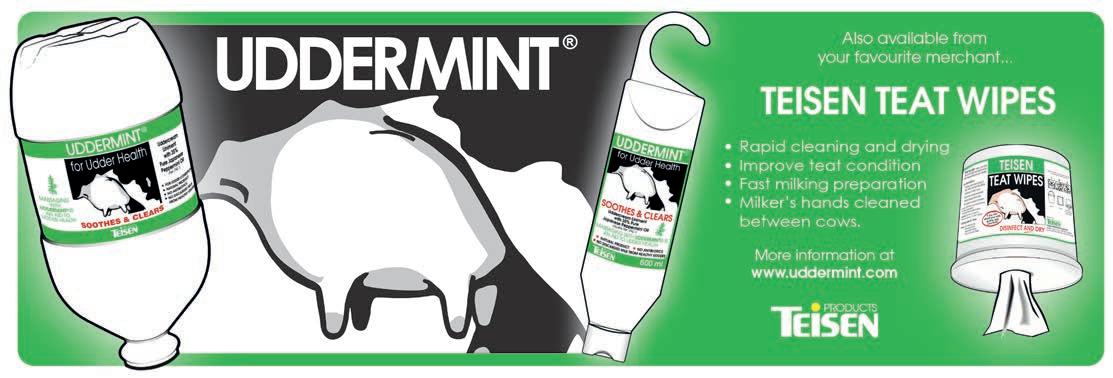
Origination by Farmers Guardian, Unit 4, Fulwood Business Park, Caxton Road, Preston, Lancashire PR2 9NZ. Printed by Precision Colour Printing, Halesfield 1, Stirchley, Telford TF7 4QQ. No responsibility can be accepted by Dairy Farmer for the opinions expressed by contributors.
a word from the editor
Recently I listened to the International Dairy Federation’s (IDF) webinar on global marketing trends. Some time was spent discussing the impact of the Covid-19 pandemic and how many of the consumer trends seen during this period had continued into the ‘post-Covid-19’ era.
In particular, the consumer trends highlighted by IDF were concerns about climate change, animal welfare and the demand for local produce. e issues of in ation, the situation in Ukraine and the labour shortage were also highlighted as potential challenges in the future. However, despite all of this, the webinar speakers were also at great pains to point out their optimism for the longer term prospects for the dairy sector.
is, they said, was mainly due to the growth
in global population and the growth in per capita consumption of dairy products.
I always like to look on the more optimistic side of things, but this long-term view can be di cult to digest when on a domestic level the short-term situation is dominated by on-farm milk price cuts, and now price cuts for milk on the supermarket shelves. e on-farm milk price reductions are being blamed on a lack of demand for dairy products coupled with a plentiful supply.
So could all of this be reversed by these price reductions on-farm and in the supermarkets? e market analysts tell us this is unlikely to be the case as we enter the spring ush period.
However, what is more certain is the need to weather the short-term challenges in order to bene t from the longer term optimism.
3 MAY 2023
What’s
Paying for will save th
The plunge in milk prices could pose an existential threat to a dairy market which has a strong mediumto long-term future, farmers, processors and retailers have been warned.

John Allen, of Kite Consulting, said: “A spot commodity price as low as 30ppl cannot be borne for very long when the cost of production is higher than 40ppl.
“Producers which sell on more secure contracts have seen prices fall, but they are shielded from the worst of the drop in values.”
Mr Allen highlighted the longer term threats to milk supply at a recent conference of dairy supply chain executives, organised by the Eucolait European dairy organisation.
ere, he presented projections that by 2030 there could be 30 million tonnes of dairy trade which
Selling milk through commodity markets is incompatible with

sustainability agenda
cannot be satis ed because of a lack of supply.
He said: “ e value of dairy trade by the world’s major exporters –the US, New Zealand, EU, UK, Australia and Argentina – increased by an average of 8.4% a year between 2010 and 2022. Maintaining that level will take extra supply.”
e pressure on supply is set to
Preventing bTB spread
JFarmers bringing ca le into Scotland are to be subject to tighter controls to reduce the risk of spreading bovine TB (bTB).
From May 18, changes to legislation will require stricter pre-movement testing of ca le, adding extra precautions for animals coming from areas of higher infection risk.
In addition, compensation will be reduced for any unclean ca le slaughtered for bTB control purposes.
is is intended to incentivise farmers to keep their animals clean and promote be er animal health and welfare.
A new de nition for isolation
will also be introduced and compensation will be reduced for ca le which are not properly isolated. is will strengthen the protection of the main herd against onward spread of infection from any reactors or suspected reactors.
Rural A airs Secretary Mairi Gougeon said: “We are commi ed to maintaining Scotland’s low bTB infection rates and O cially bTB-Free status, which is crucial to the success of our ca le industry.”
She added the changes were part of a ‘comprehensive, practical and proportionate programme of measures’ to reduce the risk of disease spread as far as possible.
NEWS 4 MAY 2023
the
JOHN ALLEN
MAY 2023 VOLUME 70 ISSUE 5 8 DAIRY TALK Claire Eastham and Matthew Winter 10 ON FARM Dairy herd plays a pivotal role in family’s expanding business 14 DAIRY MATTERS ‘Road to nowhere on a bike with no chain’ 16 VET’S VIEW Maximising the returns from your heifers 18 YOUNGSTOCK Tips on making disbudding a simple task 20 WORLD DAIRYING Robotic rotary up and running in Australia 22 BREEDING Including the latest bull proofs run 30 HOUSING 32 HEAT STRESS 34 CONFERENCE 36 GRASSLAND Features and advice on managing establishment 51 ANIMAL HEALTH A look at summer welfare and disease protection 64 MACHINERY Combination mixer wagon reduces costs 68 MILK PRICES 72 MILK ANALYSIS 74 NEW PRODUCTS Products hitting the market 78 GOOD EVANS ‘Beware: Wolves come in many disguises’ 80 BUSINESS CLINIC Reduced BPS aid starts to take effect 82 RESEARCH Milk restriction affects calves’ ability to learn 20-21 World Dairying 62-65 Machinery
inside?
sustainability e dairy market
Contractor prices to rise

JContracting price rises are ‘inevitable’ this spring as inflation continues to impact costs for contractors.



Releasing its latest survey of contracting prices, the National Association of Agricultural Contractors (NAAC) highlighted the UK inflation rate was currently more than 10%, but there were more modest increases in contracting rates, with significant price rises in some services, while others have seen barely any movement.
AHDB meets costcutting targets

JAHDB has confirmed it has met its £7.8 million, two-year target for reducing operational costs by the end of the 2022/23 financial year.




increase as sustainability demands, including reducing carbon and lowering nitrate levels, increase.







“We are now in the position that there will never be a new New Zealand dairy farm as the country introduces permits to produce,” said Mr Allen a er the conference.
“Meanwhile, the government in the Netherlands has proposed the buying up of dairy farms to take them out of production to reduce nitrate levels.”
He argued that a reduction in the size of the UK’s dairy herd over the last 30 years means there is not the same pressure to reduce cow numbers as elsewhere, although the country is not immune from future restrictions.
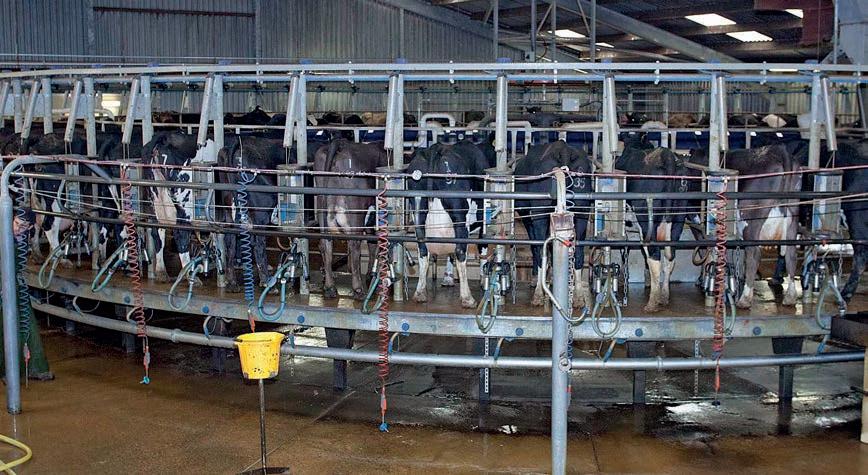
Establishment
e establishment of a market for environmental goods and services such as carbon o setting, tree planting and even











renting out land to other dairy farmers could tempt some producers to give up.
Mr Allen said: “ e cost of meeting sustainability demands will have to be accommodated in the price of milk or traders and processors will lose milk production.
“Selling milk through commodity markets is incompatible with the sustainability agenda, so we will see more milk sold through secure contracts.”
As part of its commitments set out in the Change Programme for 2021-2026, a total saving of £8.5m has been made.
The levy body said the reduction included a nonpay-related savings target of £300,000, through the reduction in governance costs related to the Horticulture and Potatoes sectors, as well as the closure of a satellite office.
Our Mattress Systems, Rubber Flooring & NEW CCTV System are all eligible for ROUND 2 FETF ANIMAL HEALTH & WELFARE GRANT info@coz ycow.co.uk 01296 738 122 | 07713 097 184 for more info: APPLICATION PROCESS EXPECTED MID MARCH GREAT NEWS !!!
NEWS 5 MAY 2023
The pressure on supply around the world is set to increase at the same time as an increase in sustainability demands, including reducing carbon and nitrate levels.
Size of spring flush key for milk markets
The size of the spring ush will be the key factor for milk prices in the UK later this year, with global dairy markets also under pressure.
According to dairy market watcher Chris Walkland, any increase in farmgate prices may take some time to work its way through, with prices expected to fall further before any rise.
He said: “It is too early to say whether we have turned a corner, with the full size of the spring ush unknown for the next few weeks. It may have been a cold and wet March, but there is still time for grass to grow and production increase.
“ e global market is also under pressure, with the last Global Dairy Trade auction showing a 2.6% drop and fears over the upcoming sale. ere are some signs of output levelling o in Germany, but that is yet to translate into price support. Meanwhile, environmental legislation may limit production in the Netherlands and New Zealand in the longer term, but that is in the future.”
Pa y Clayton, lead dairy analyst at AHDB, said: “ ere is a feeling that producers may be able to sustain prices as low as 37ppl to 38ppl for a li le while, but if they fall below that level while input costs remain high, then producers may cut back on output later this year.
“ e size of the spring ush will be key. So far it has been a late start to spring and stocks of silage are low.
“With feed prices remaining at historically high levels, a lack of forage may lead to some destocking
this summer – especially if cull cow prices remain strong.”
She added that the global market continues to be in uenced by weak demand in China, which normally accounts for just under half of world dairy imports.
She said: “Demand in nonChinese markets has improved as wholesale prices have become more a ordable. If it does return in China too, then there is the potential for a strengthening in global milk prices.”
NFU dairy board chair Michael
Oakes raised concerns for the sustainability of farm businesses. Mr Oakes said the high prices towards the end of last year were insu cient to deal with the sustained period of high input costs.
Concerns
“With cost of production lying around the mid-40ppl mark, I have concerns about the future of many farm businesses, as market signals indicate a challenging springtime for farmgate milk prices.”
Breeding for feed-efficient dairy cows
JA new research project, set to be largest UK study of its kind, is being carried out at Scotland’s Rural College (SRUC), with researchers aiming to provide information on how to enhance breeding for feed-efficient dairy cows.
The study will use newly generated data, along with the 50-year longitudinal database at SRUC’s Dairy Research Centre.
Dr Bingkie Li, SRUC challenge
research fellow, says the study will use innovative methods to provide novel and comprehensive knowledge of genomic and regulatory variants underlying feed efficiency, which could help inform large-scale genetic improvement of dairy cattle.
Dr Li adds that if feed efficiency can be improved, without sacrificing milk production or animal health, if could help the industry save millions of pounds
a year and could have a positive impact on the environmental impact of the industry.
Largest study
She says: “This is the largest population-level study of its kind in the UK on dairy feed efficiency and will empower sustainable dairy breeding for feed-efficient and environmentally friendly animals.
“The dairy industry is worth about £703 billion globally and
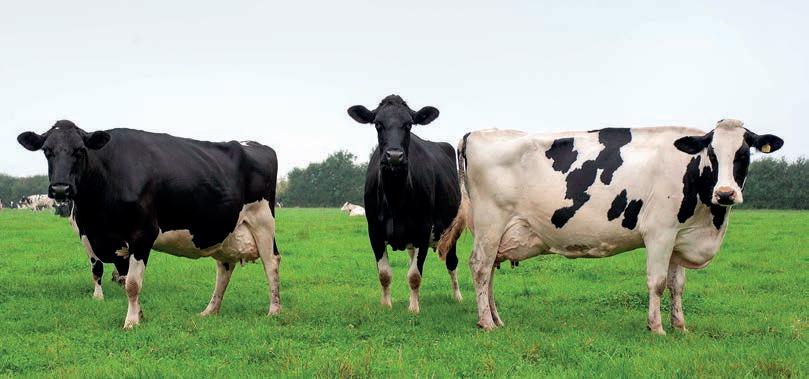
£9.2bn in the UK. Research outcome from this project has the potential to deliver at least 1% extra genetic progress for UK dairy industry, worth millions of pounds per year for the UK dairy industry and notifying dairy breeding worldwide.”
The three-year project is funded by the Biotechnology and Biological Sciences Research Council Responsive Mode –New Investigator Award.
NEWS 6 MAY 2023
All eyes will be on the size of the spring flush in the coming weeks, with it set to have an impact on future milk prices.
Always Robot Ready with ForFarmers
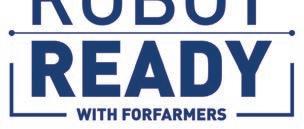
At ForFarmers we understand what needs to be undertaken in the transition from conventional milking systems to a robotic one. Not only does it involve a different milking method, but also an entirely new way of managing and feeding cows.

Our national team of Robotic Milking Specialists is here to help with feed planning, diet advice, costings and assistance so you can achieve the best results with the optimum settings.

ForFarmers is proud to offer total robot milking feed support.
For more information speak to your local ForFarmers Robotic Specialist or visit >
0330 678 0982
info.uk@forfarmers.eu
www.forfarmers.co.uk
@ForFarmersUK
DAIRYTalk
Claire Eastham
Claire Eastham farms with her husband Martyn in Dorset, where they milk 120-spring calving cows. After gaining knowledge and experience working for other businesses, the couple started their own dairy farming journey in 2015 by taking on a share farming agreement before progressing to their current county council farm.

Well, the sun is nally shining (for now at least) and it couldn’t be more welcome.
So far we have always faced each calving with a zest and we are able to rise to the challenge, but this year has just seemed tough.
We’ve been faced with all the problems we haven’t really faced before and, seemingly, it’s been one thing a er another.
With several di cult calvings this year and cows that are lighter than we would like, we were a bit perplexed.
Rain deluges throughout March a er the cows had been out as soon as they calved in February, the purchase of another 120 tonnes of silage to see us through, being shut down with TB — so calves a plenty to rear, have all been tests of mental resilience and I have to admit, we haven’t always risen to the challenge. is spring has felt a bit of a slog.
It feels like a failure to admit all this, and this shouldn’t be the case; we should be able to openly discuss our issues, though I think a few people have been taken aback when they ask how calving is going and I say ‘not great’.
It’s the same when someone asks ‘are you okay?’ Most expect the reply ‘ ne thanks, and you?’ when in reality the respondent might have more to say. ere needs to be a change where problems are openly shared and people are willing to listen. e old adage goes ‘a problem shared is a problem halved’.
Positives
Here, to get out of this rut, we are looking at the positives.
All the calves look good and haven’t had any setbacks, with no mortality. e sun is out (hip, hip hooray), the cows shouldn’t be far behind and, with that, we can look to get back on track.
We will also get some reseeding done, with more herbal leys going in.
We calved 68% of the herd in three weeks and 81% in six weeks, with some still remaining.
We have to test two IRs for TB later in the month and, if they are clear, so are we and the calves, which will be mostly weaned, will head to market.
e heifers are gradually being weaned now a er
meeting their 100kg pre-weaning target. We also need to sit and write down some goals.
It’s hard not to feel that we’ve stagnated, in terms of growth, but we can still push on with key performance indicators and think about where we want to be as people and what success looks like for us.
Pre-covid we were sticking to achieving a week’s family holiday per year and we really need to get back to that to be able to see the bigger picture.
O farm, I have been busy undertaking Farming Equipment and Technology Fund grants with bigger uptake than I’ve seen before.
Items such as heat recovery units and variable speed drives have been as popular as ever – maybe due to increased electric costs, or increased focus on carbon footprints.
Countryside stewardship also looks set to have a bigger uptake this year as capital limits are removed, and BPS starts to bite with 35% plus reductions this year on the sliding scale and people looking for alternative avenues for that income.
Many still believe it’s going to just ‘arrive’ through the forms of various schemes and ‘we’ll get our money back’, but this simply isn’t the case and you need to look at options now that will t your business and make it t for the future.
Yes we need to produce food, but yes we need to do that sustainably. It can be done.
8 MAY 2023
“ There needs to be a change where problems are openly shared and people are willing to listen
Matthew Winter
Matthew Winter returned to the family farm in 2011 and is one of four partners in the mixed dairy/arable family farm in Lincolnshire, where 210 Holsteins are milked under the Corringham prefix. He sits on the Holstein UK board of trustees and started his career at Holstein UK as an animal breeding analyst before training to be a chartered accountant.

The long dry summer of 2022 is now a distant memory and I’d guess most would say we’ve probably had enough rain for the time being.
Although we are in one of the driest parts of the country with li le more than 20 inches of rain annually, it doesn’t tend to be equally spaced.
On our at, heavy land we can quickly go from very dry to waterlogged.
As I write this in early April, we’ve still got no animals out at all, and the grass is certainly springing into action.
As everyone knows, it is always a huge relief to have had a clear TB test, and we were fortunate enough to be clear on our four-yearly test at the start of the month.
A huge relief for us, although I have a sneaking suspicion our extremely enthusiastic vet student, who had been helping for a few weeks, seemed somewhat disappointed not to see a reactor.
She has actually been one of the best vet students we have had for a number of years, but she is also very keen to experience all the misfortunes which may and do befall us.
We usually have one or two vet students a year and it must now be 20 years since we had a male vet student.
Vet
As well as our youngstock shed extension, which is nally almost complete six months later than planned, the other area we’ve been trying to focus on over the past few months has been the installation of a slurry separator to improve our slurry management system.
To say we have had teething issues with the new separator pump would be an understatement, but now the suppliers have changed the pump, to the type we actually ordered in the rst place, we seem to be making some progress.
Neil, my cousin, reciprocated their nal invoice with an equivalent invoice for his time over the past four months unblocking a pump that wasn’t up to the job, repeatedly emptying
the reception pit and trouble-shooting. is is ‘to be continued’.
As Arla members, we have seen the milk price drop by more than 12ppl over the past four months and the continued uncertainty is making budgeting this year di cult.
At least there is some accompanying downward movement in fertiliser and feed prices. e fall in milk price will certainly focus the mind on doing as much as possible to get the maximum from the Sustainabile Farming Incentive payments, which Arla start paying over the coming months. Although as always, the additional work is unwanted.
March brought a most welcome trip to Carlisle for the UK Dairy Expo.
It was great to see so many friends old and new, and I think the standard of ca le was the best yet. We were delighted to host a very dear friend in Robert Medwell who was visiting from Canada.
It is always a pleasure to have people visit and later in the month we are looking forward to welcoming the Lancashire Holstein Club members who are visiting as part of their spring tour. Although we try our best to keep a relatively tidy farm, a trip such as this means ‘operation clean-up’ is now well underway.
9 MAY 2023 DAIRY TALK
“ It was great to see so many friends old and new, and I think the standard of cattle was the best yet
A willingness to anticipate and adapt to change underpins the mindset of the Rees family, which runs a dairy farm in West Wales. Gaina Morgan reports.
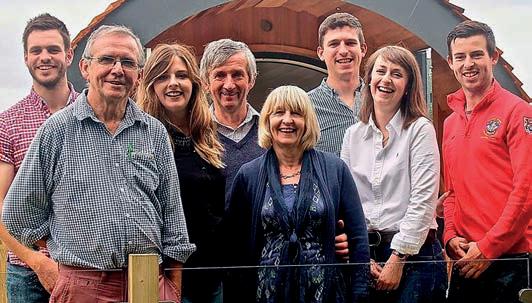
Dairy herd plays a pivotal role in family’s expanding business
The Rees family has been farming in Carmarthenshire since the late 1940s and now brothers Peter and Huw Rees, along with Huw’s family, run the autumn calving herd alongside an award-winning ve-star touring caravan park, with a soon to be open wedding venue also adding to the family’s business interests.
Peter and Huw’s parents, Cyril and Margaret, began milking in the Towy Valley, with just ve cows a er World War II, and from there they steadily built the herd and business.
e farm has expanded, and the family now milks 320 homebred pedigree British Friesian and Shorthorn cows at Dan yr Allt, Landovery.
ey also farm Li le Hall and Green Grove, the la er is where they will be opening the wedding
venue. A 40-point rotary system was installed two years ago at Dan yr Allt and means two people can milk in two hours.
e brothers say the new parlour has ‘revolutionised’ their milking.
Interestingly, although Peter’s Nu eld Scholarship 30 years ago focused on automated milking systems in Northern Europe, they did not opt for robots when replacing the parlour.
Peter says his experience in the Netherlands and at Gelli Aur College where he led the agriculture team, taught him that the need to ‘sweat the assets’ for robot milking would not suit their system.
And he says despite the business expansion over the previous decades, cow numbers will not be increasing going forward. ese days, with sustainability the buzz word and energy and fuel
costs rising exponentially, he says the emphasis is on control of costs and inputs.
“We will now perhaps move towards more regenerative farming.
“It is quite likely that we might even reduce numbers slightly to make it more sustainable, with current feed and energy and fertiliser prices being what they are and Welsh Government legislation being another issue”, says Peter.

“We need to be able to keep to our own resources really; we need to be able to grow as much
forage for ourselves and to be as sustainable as possible.
“I think you have got to be e cient in what you have and, actually, I think labour and having a reliable work force is going to be a key factor.
Efficient


“We were not enthused by the thought of having 1,000 cows, or anything like that.

“So you have then got to say, well if you are not going to go that big, you have got to go to the next most e cient position and you either come down to 100 cows and a robot and do not employ anybody or you have that intermediate stage, where you can a ord to employ sta , but you are still e cient.
“ at is the position we are in.”
He adds that ‘time will tell’ whether they have the right amount of land for their cows, or whether they have to reduce stock
10 ON FARM MAY
We need to grow as much forage and be as sustainable as possible
PETER REES
The family focuses on cost per litre and aim for a simple system.
The Rees family, which farms in the Towy Valley. Left to right, Llyr, Peter, Carys, Huw, Elizabeth, Carwyn, Emily and Alun.
numbers. Cost per litre is now the important factor for the family and the aspiration is to have a simple, viable system.
It is all about controlling costs. If we can control our costs and












produce milk economically, then we have a chance of surviving,” says Peter.
Huw and son Alun, have everyday responsibility for the cows, with Huw’s wife Elizabeth
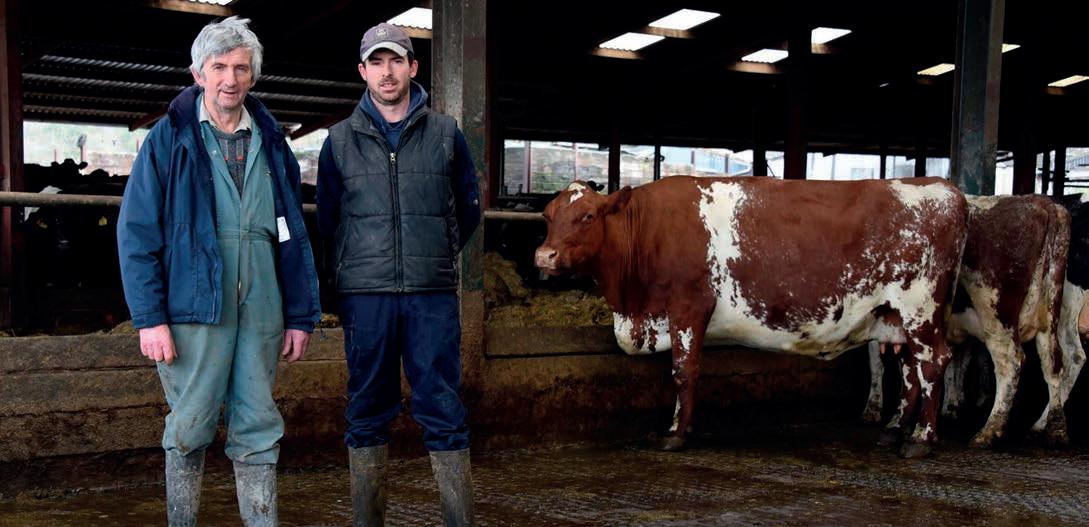
Keep your butterfat levels on track this Spring





‘holding it all together’. Huw says his early enthusiasm for chasing milk yields and the Holstein cow has tempered, because it did not suit the farm. e policy now is to make the best possible use of
grass, so the herd switched to British Friesians and a smaller number of Shorthorns. e autumn calving period is as compact as possible, between September and
Boost your herd’s milk yield and milk fat content by adding Butterfat Extra to their regular feed throughout the Spring.
Butterfat Extra is:
















■ Highly digestible with rumen-protected fat

■ Easy to store, ready to feed

ON FARM BYTRIED&TESTED UKFARMERS
Butterfat Extra can help you achieve: A typical rise in butterfat of 0.3% Increased milk yield by up to +1 litre per cow/day Contact your local merchant to learn more or call Trident on 07540 819080 tridentfeeds.co.uk
Huw and Alun Rees take responsibility for the day-today running of the herd.
ON FARM
mid-December. And the system is designed around a relatively small grazing platform, with outlying land used to produce forage.
Hence, the family does not chase yields, but the cows average between 6,000 and 7,000 litres and can last 10 lactations, with a rst calving at two years old.
Emphasis
e cows are housed as they calve, with 80 or 90 replacements kept.
More sexed semen is used these days, with an emphasis on breeding for fat, protein, legs and fertility. A beef breed is used a er AI and beef calves go o the farm and, from next year, will be sold under contract at four weeks for Wagu beef.

Huw says: “ e heifer calves are reared on an automatic machine a er receiving colostrum for two or three days.
“We start weaning them at six to seven weeks, so they are weaned by eight or nine weeks. en they are fed on straw and concentrates until are turned out in April.”
Once heifers are at the bulling
Farm facts
r243 hectares (600 acres) across three holdings, mostly owned, some rented and some woodland
rOne full-time member of staff plus a number of parttime workers are employed on the farm
rThe wedding venue is due to open in May, run mainly by Huw’s children and partners, including daughter, Carys Jones, whose own wedding to Llyr Jones last year was the catalyst for the venture
rHuw’s son Carwyn and wife Emily also own and run four glamping pods
rPV panels, installed on difficult ground, produce 50 KWH electricity

rThe milk is processed at nearby Haverfordwest
stage, they are kept in cubicles, and pre-calving cows are also cubicle housed.
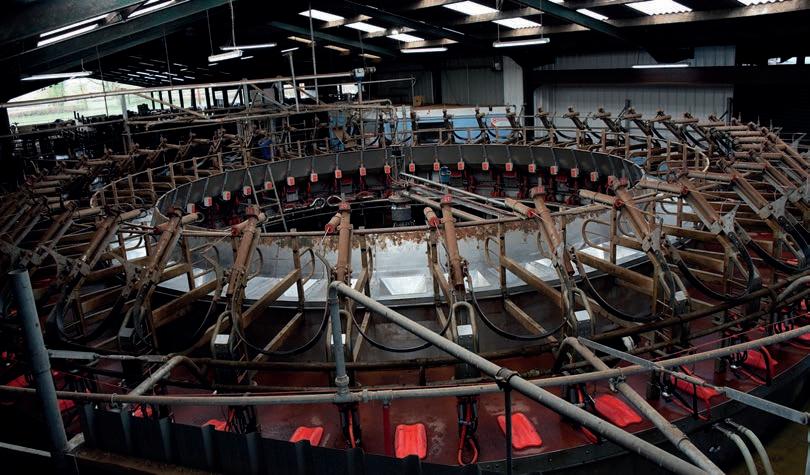
Peter says: “We have a new calving pen with rubber mats to make it hygienic and clean and to try to minimize risks such as Johne’s. e only straw we use is for bedding the calves.”
e brothers enjoy a close relationship and the variety that
and goes for cheese
rThe herd averages 4.4% and protein 3.5%
rPeter was senior lecturer at the Welsh Agricultural College in Aberystwyth from 1978-1995 before joining Gelli Aur as head of department for agriculture. He went on to take on a number of roles at Coleg
Sir Gar culminating in the role of assistant principal. He retired from the further education college in 2015
rThe Rees family is hosting the Dairy Shorthorn AGM weekend on June 10-11, 2023. The weekend includes a young members workshop, judging seminar, herd walk, as well as the AGM.
rFor more information, visit shorthorn.uk
the 100-pitch caravan park, as well as the other diversi cation businesses, bring to the farm. ey were brought up to work together and to play a role in the farming community, as well as in the small town of Llandovery.
Huw has been chair of the NFU locally and of the YFC and is very much involved in the local community, an a itude which has
also been passed on to the next generation.
Alun has been very active in YFC and also successful showing calves and now youngstock.
He is a member of Holstein Young Breeders and enjoys mentoring other youngsters and passing on his knowledge.
Services
And at the end of last year, Peter was presented with the Farmers Union of Wales Award for outstanding services to the dairy industry.
His contribution to education and technology transfer in the Welsh dairy sector has earned him a Fellowship of the Royal Agricultural Societies. He is involved in a range of activities, is chair of Lantra Wales and Future Farmers of Wales president.
12
MAY 2023
We have a new calving pen with rubber mats to make it hygienic and clean
PETER REES
The herd is made up of British Friesian and Dairy Shorthorns registered under the Crugside prefix.
A 40-point rotary parlour was installed two years ago.














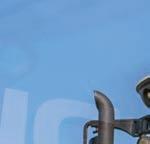






















CLAAS CMATIC – Geared for Growth. claas.co.uk Watch the video Jamie Downing Booth, ARION 660 and AXION 850 CMATIC, May 2022 Contact your local CLAAS dealer today for a demonstration of a CMATIC tractor. Seamless acceleration and deceleration between 0-50kph. Uninterrupted power for maximum productivity and minimising fuel usage. 3 simple drive modes. Auto stretch brake. Tractor implement control. Engine droop adjustment. The CMATIC transmission is so smooth – particularly on the road.
DAIRYMatters
‘Road to nowhere on a bike with no chain’
This month, former cowman and agri-marketing contractor Phil Christopher shares his views on the lack of financial rewards for farmers from an expanding export market for ‘Brand Britain’ dairy products.

It is encouraging to know that two-year-matured UK Cheddar is selling for nearly £40/kg in some USA supermarkets, according to this magazine’s weekly sibling (Farmers Guardian, March 31: ‘Vast US retail scene’). From an AHDB-led export mission, FG reports: “British cheese was seen as a ‘sexy product’ to overseas buyers.”
is echoes a point made by Lucy Randolph, AHDB exports manager, nearly two years ago during an export opportunities industry forum at UK Dairy Day 2021. At the forum, she said: “Brand Britain is very well thought of in export markets.”
So far, so good – except for one tiny aw, as I see it, which is the absence of a mechanism by which some export revenue reaches the dairy farmers reading this.
e best metaphor I can o er is riding a bike with no chain; no ma er how much exports help with pedalling, precious li le reaches you at the back wheel. At UK Dairy Day 2021, I put this to the forum speakers.
e NFU Dairy Board chair said his organisation’s new export strategy would ‘link with milk contracts’ and that they were ‘hoping’ for government support.
Really? And which contracts would those be?
AHDB’s Ms Randolph said that ‘hopefully’ additional export demand for milk would feed through to farmers as be er ex-farm prices. Sarah Appleby, from her family’s admirable cheesemaking farm in Shropshire, said they were ‘lucky’ to own the Appleby brand, from which export sales certainly did yield a nancial gain.
So I asked the panel whether ‘hoping’ or ‘hopefully’ was good enough. To Sarah, I suggested that being ‘lucky’ had nothing to do with it. Instead, her grandparents-in-law, Lance and Lucy, had the vision and courage in the 1950s to start making cheese. Clearly, they were rather good at it and subsequent generations, including Sarah and husband Paul today, have continued their good work.
Brand ownership
Between Appleby’s and the £40/kg Cheddar-maker Barber’s, the common denominator is investment in, and ownership of, their brands. So when a uent USA customers buy their cheeses, Appleby’s or Barber’s
14 MAY 2023
Phil Christopher
receive the lolly. Of course, costs of production, shipping, admin and export insurance have to be covered. But that is under direct control of those cheesemakers.
Returning to our UK Dairy Day panel, I also asked: “What about the majority of milk producers who do not have any brand ownership as their bicycle chain?”

Collectively, the answers from NFU, AHDB and Promar experts can be summarised as ‘blah, blah, blah’. Only Sarah Appleby appeared to understand what I was ge ing at.
It is all very well boosting dairy exports, but how do our farmers reap meaningful gains? Basking in the glow of the good ‘Brand Britain’ reputation does not butter much bread.
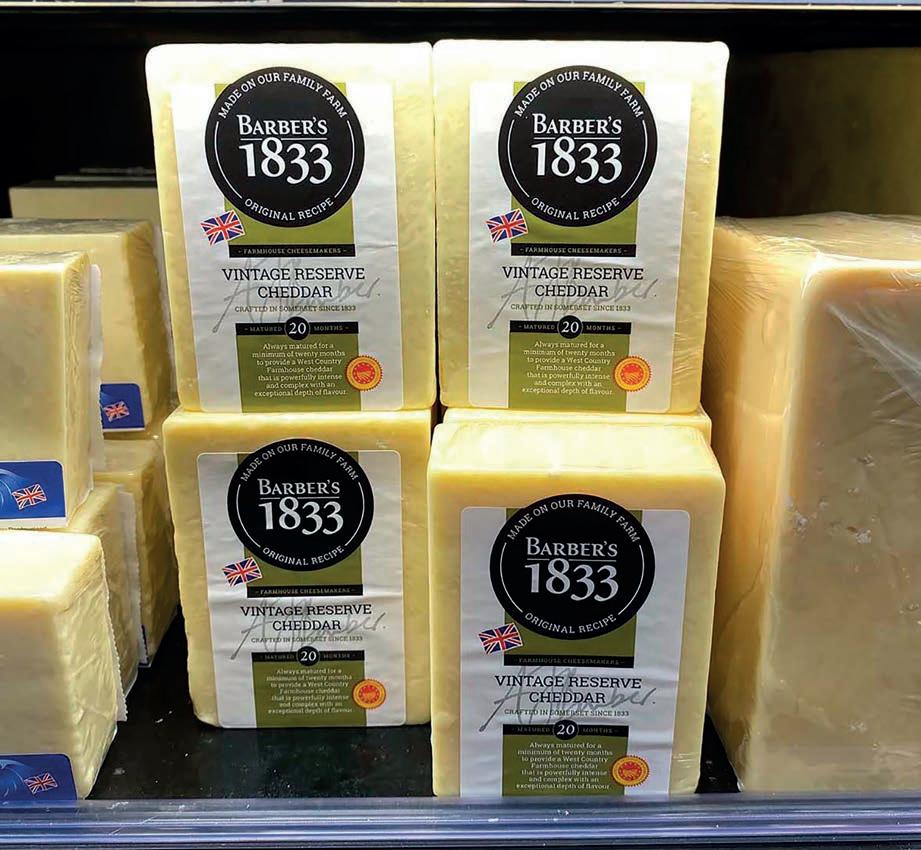
One nal jibe goes to the panel chairman, who said: “British milk is a fantastic product.”
e reality is that most ex-farm milk is tanker
loads of an undi erentiated commodity. In contrast, a product sits on retail shelving in identity-di erentiated, a ractive, customer-friendly packaging.
With the UK having just joined the Trans Paci c Partnership free-trade club, it is a reasonable assumption that new export opportunities for high quality ‘Brand Britain’ dairy products should arise. But, for a fair share of the nancial returns, farmers need more skin in the game than just supplying the bulk raw material for other businesses to convert into products with brand names owned by the processor.
How can this be done? at is up to you, individually and collectively, to follow the role models of Appleby’s and Barber’s quoted above. Is it just me, or have Clover or Country Life, Cathedral City or even Lymeswold, just popped into your head?
FARMING EQUIPMENT & TECHNOLOGY FUND 2023



Eligible items in our ranges:
Mattress
Dairy Grip rubber
AgriCow Pendulum Cow Brush

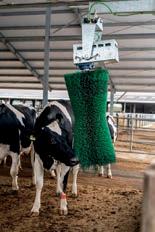
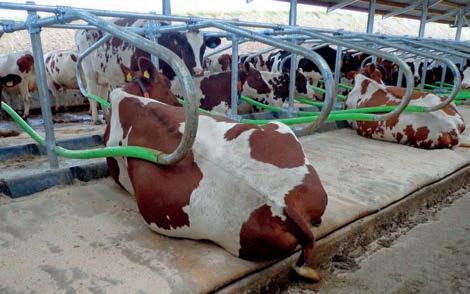
Calf De-horning crate
Calving Gates


Cattle Crushes
Slat Rubber











15 MAY 2023 Official Distrib f View our cow comfort range: www.wilsonagri.co.uk Contact us at HQ: 028 7086 8430
“ It is all very well boosting dairy exports, but how do our farmers reap meaningful gains?
Matthew
422556 Charlie
679023 Midlands & Wales Scotland
Evans 07922
Sutcliffe 07703
& Northern England
Livestock Equipment www agrikit co uk A COMPLETE RANGE OF COW COMFORT PRODUCTS Pasture Mat the premium cow mattress
“ It is a reasonable assumption that new export opportunities for high quality
‘Brand Britain’ dairy products should arise
Two-year-matured UK Cheddar is selling for nearly £40/kg in some USA supermarkets.
Heifers enter the herd carrying a substantial ‘debt’, but how can farmers ensure their youngstock are reared efficiently to pay back those rearing costs and then last well to deliver a good profit? Katie Jones reports.
Maximising the returns from your heifers
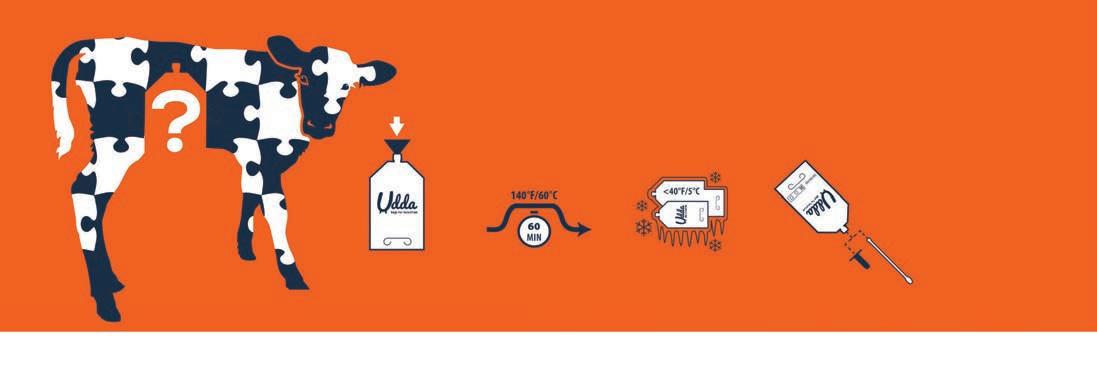
ith research estimates suggesting the cost of rearing heifers sits somewhere around the £1,900 mark, vet Ginny Sherwin, said it was important to make sure these heifers were then lasting in order to pay back that investment.
Speaking at an AHDB-organised event in Preston which focused on the ways to maximise returns from heifers, Dr Sherwin, clinical assistant professor in farm animal medicine at the University of No ingham, said she wanted to see cows lasting into their fourth lactation at the least.
She said: “ e cost of heifer rearing is variable between farms, but it is easy to sit down and work it out for your particular farm.
“If you put heifer rearing at a cost
Wof £1,891 for example, at a milk price of 33ppl this would mean that a heifer is required to give 5,512 litres in total to pay back their rearing costs alone. If that heifer is giving 6,600 litres in her rst lactation, she will still have money to ‘pay back’ at the end of lactation one.

Second
“ ese heifers come with a debt, and we need to remember that in most cases they are not going to pay this debt back until they are at least part-way through their second lactation.”
She said that on average, cows in the UK lasted 3.5 lactations.
“ ere is still some way to go in improving this, and we need to remember that even though these heifers do not pay back the rearing cost until their second lactation, they will not reach
maximum yield potential until they are in lactation ve.”
And she argued that it still stacked up when comparing keeping cows for longer with introducing new genetics.
“We have a desire to improve genetics on farm, and while we need
Most heifers will not pay back their rearing cost until part-way through their second lactation.

this genetic opportunity, what we also have [when bringing in heifer replacements] is a lack of maturity cost and a requirement for a larger number of replacements to be on farm, which signi cantly impacts both the economics and sustainability of the farm.
“By keeping a cow for longer, we will not be losing money, and instead will be allowing her to hit her potential.
“I am not saying we do not need new genetics in the herd, but I am saying we need to be clever with the use of new genetics.
“Work out which are your best
16 VET’S VIEW MAY 2023 Call us on 01772 690131 FILL A BAG WITH YOUR COLOSTRUM PASTEURIZE IN THE BAG STORE IN THE BAG WARM & FEED IN THE BAG WHAT’S MISSING? Answer = Bags for Colostrum. Simple & Hygienic. Scan here with your phone camera for more information G Shepherd Animal Health ADVICE • QUALITY • VALUE 2022-11 Udda Bags Advert_210mm X 77mm_09_22 copy.indd 1 31/03/2023 14:21
By keeping a cow longer we will not be losing money and instead will allow her to hit full potential
GINNY SHERWIN
animals using your herd genetic report, and identify the cows that should be served to sexed semen.”
To successfully calve long-lasting heifers into the herd, Dr Sherwin advised farmers to work towards goals around rearing eciency and heifer e ciency.
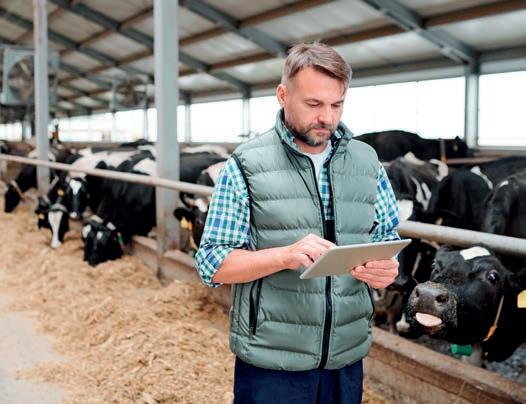
Rearing e ciency, she explained, was the percentage of heifers born alive which go on to calve at the target age at rst calving. She said the target for rearing e ciency should be more than 85%.
Target
Heifer e ciency is the percentage of heifers born alive that calve at or below the age at rst calving target, and then go on to complete three lactations. e gure here, she said, should be more than 75%.
If a herd was not hi ing these targets, Dr Sherwin said it was important to ask why.
Dr Sherwin said she was o en asked whether the age of rst calving actually ma ered, and she said the answer was an emphatic yes, providing the heifers were well grown and were 90% adult bodyweight.
“As well as increasing rearing
costs, and meaning more heifers are needed on farm at any one time, not meeting the 24 month target also means those heifers that calve later are more likely to leave the herd earlier than those that calve at or under 24 months.”

Dr Sherwin said heifers that calved for the rst time at 30 months were twice as likely to leave the herd earlier than a heifer that calved at 24 months.
She said other issues that could impact on heifer e ciency were problems with fertility, lameness and heifers being put under stress when joining the main herd.
She said: “It is important to do what you can to ease the transition for heifers into the adult milking herd. Ideally you want to move them into the dry group in pairs or as part of a larger group of heifers ahead of the transition period, three weeks prior to calving.
Stocking rates
“ ey need time to se le in, and at this stage pay a ention to stocking rates, and space for lying and feeding.”


Other options for easing the transition into the milking herd is early
From dairy cattle, milking parlours, calving equipment and everything in between, you’re sure to find what you need on FGBuyandSell.com.

Start listing your items FREE today!

17 VET’S VIEW MAY 2023
Sell. Buy at FGBuyandSell.com
Browse.
exposure to the environment which they will be kept in, for example
cubicle training and running heifers through a parlour.
The knock-down technique for calf disbudding will speed up the task and minimise stress for both animal and handler, while the traditional method may still be more appropriate for small groups. Wendy Short reports.
Make disbudding a simple task
Disbudding can fall to the bo om of the job list on a busy dairy farm, but vet Ben Pedley, of the Cheshire-based Willows Veterinary Group, says the procedure is simpli ed if calves are treated at four to six weeks old.

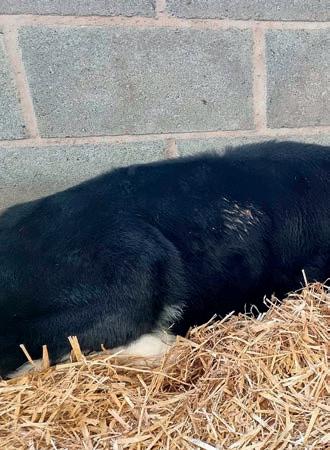
“ e timing of disbudding is not an exact science,” he says. “If
it is carried out when the calf is very young then the horn buds may not have fully developed, while with older calves there is a risk of leaving a small amount of horn tissue that may continue to grow.”
Progress
Mr Pedley says the design of disbudding equipment has
Knock-down disbudding
JThe knock-down technique can be a one-man operation and calves need only to be caught once, with an average work rate of about 30 calves per hour. It involves the prior sedation of calves with xylazine by a vet.
Mr Pedley says: “The sedative dose is related to calf weight and using a weigh band on a couple of individuals in the group will give a more accurate figure. A 75kg calf will require 1-1.5ml, for example. The sedative effect will last for at least half an hour, which allows plenty of time to deal with the selected group.”
Most calves will be lying down within five minutes of sedation, after which a local anaesthetic and pain relief are administered and the buds clipped to remove the hair.
“Post-disbudding, a calf will occasionally continue to lie flat out after 30 minutes. It should be positioned so that its head is upright and the legs are tucked under the body, as there is a
risk that the rumen will become distended with gas and cause bloat. The majority will be eating normally that same evening,” say Mr Pedley.
He estimates the approximate cost per calf for the knockdown technique overseen by a vet at £10/head, including all medication and labour. The price may vary according to numbers and calf weights.
“There is no minimum batch number in my practice, but it makes sense to have a group of about 20 calves ready for disbudding before calling in the vet. It is straightforward, quick and minimises stress on calf and handler.
“Keeping horned cattle in a herd will often lead to bullying. They pose a health risk to stockmen, as well as to the cattle themselves.
“Injuries can also be caused during transport, or in any other situation where the animals are tightlygrouped,” says Mr Pedley.
progressed in recent years. He says: “In my opinion, the best models are the cordless type with a rapid-heating function that can reach a temperature of up to 650degC. I would always recommend clipping hair from the bud before applying the hot iron, as burning hair away rather than clipping wastes heat from the iron.
“Slow disbudding is usually caused by the iron failing to reach and/or maintain the desired temperature.
“Another bene t of clipping is to con rm the formation of


a bud, as it may not be present in some beef cross calves, for example.
“ e technique is to use the iron as a cauterisation tool, maintaining pressure while creating a circle around the bud in stages and aiming to ick it out with the nal movement. Applying a spray product containing antibiotic will help to reduce any chance of post-infection.
18 YOUNGSTOCK MAY 2023
The disbudding procedure is simplified if calves are treated at four to six weeks old.
Molly Garbutt, of Willows Veterinary Group, disbudding a group of calves using the knock-down technique.
“During the procedure, calves are given an anti-in ammatory injection. Administering pain relief will help to encourage them to start to feed again and minimise any change in growth rates. It will also reduce the incidence of head-rubbing, which can slow down healing rates.”
Traditional disbudding



JThe traditional disbudding method can be done without veterinary supervision for calves under eight weeks old, Mr Pedley says.




It requires calves to be caught and restrained twice; first for the local anaesthetic injection (a legal requirement) and second for the procedure itself.
The needle containing anaesthetic is placed in the cornual groove located halfway between the base of the ear and the corner of the eye.

Appropriate training should be undertaken before trying this out for the first time, he says.




“It takes 10 to 15 minutes for the anaesthetic to take action and calves are usually released into the pen while it

takes effect. Having to catch them twice is not ideal for either calf or handler and the animals are often more difficult to catch for the second time.
“However, traditional disbudding can be suitable for smaller groups, as the producer can carry out the task without involving the vet. I would estimate that about 12 calves can be disbudded in an hour.

“The ideal scenario is to use head yokes for restraint, but if they are not available the calves should be gently encouraged into a corner with their heads facing the operator.
“If the calf shows any sign of discomfort when the iron is applied the procedure must be stopped and the anaesthetic repeated.”
Red Tractor standards

















rAt least one person should have a certificate of competence/attendance on administering medicines obtained since October 2016










rChemical cauterisation is only permitted at fewer than seven days with pain relief





























































rA stockperson can only undertake disbudding (other than chemical cauterisation) on calves under two months and they must receive anaesthetic and pain relief

19 YOUNGSTOCK MAY 2023
Ben Pedley
New technology in the form of a fully robotic rotary parlour is making light work of milking

750 cows twice a day on Paul Smith’s farm in Mepunga, based on the Great Ocean Road in south west Victoria.
Mr Smith has been working on the farm for over 30 years. He le school at 15 years old to work for his father, and took over the running of the farm 10 years ago with his wife Marsha; they now lease it from his parents.
Mr Smith says: “We are currently milking around 750 cows, 90% of which are Holsteins, twice a day on a full pasture-based system.
e cows are producing about 8,000 litres on a 300-day lactation and about 600kg total milk solids.”

Investment

e cows were previously milked via a manual 50-cow rotary, which had been installed in 1998. However, this meant milking was taking up a lot of time and required considerable labour input, so in 2022 the decision was made to invest in a new state of the art milking system.
Mr Smith says: “Last October, we installed a GEA Dairy Pro Q, which is a fully robotic rotary dairy. It is the rst of its kind in the southern hemisphere. Our system incorporates 40 GEA milking robots with room to install another 10 if needed. It is working fantastically well and we are extremely happy with it.
The first robotic rotary in the southern hemisphere has transformed a family-run farm in Australia. Chris McCullough reports.

Robotic rotary up and running
“ ere are about 60 of these systems in use worldwide, but ours is the only one on a full-time batch milking pasture-based system. In reality, it is just a normal rotary dairy with the added bene t of robot technology.
“We have gone from manually milking 750 cows twice a day to babysi ing a machine that does it for you. Plus, you get all the data that robot technology can provide. It will comfortably milk over 200 cows per hour and take all the labour and stress away with it.”
e cows are pasture-based and remain outdoors in one single milking group all year long.
Mr Smith says: “Grass is our cheapest and best feed. We also feed a ration on the dairy platform, which is a mixture of crushed barley, corn and canola along with some mineral supplements.
“When the cows are milked, they walk out of the dairy straight into a large feed pad where there will be up to 40 sliced bales of pasture silage to snack on. A er that, they head o to the paddock.”
With the change to robotic milking, Mr Smith says he is pu ing more emphasis on ‘robot ready’ udders when choosing his bulls. However, he adds the only other traits he is interested in are those that
20 WORLD DAIRYING AUSTRALIA MAY 2023
Paul Smith with his wife Marsha and children (from left) Frankie, Ted and Locky.
The new rotary milking unit can hold 40 cows.
We have gone from manually milking 750 cows twice a day to babysitting a machine that does it for you
PAUL SMITH
PICTURES : Picasa
boost foot health and the ability of his cows to consume large quantities of grass to convert into milk.
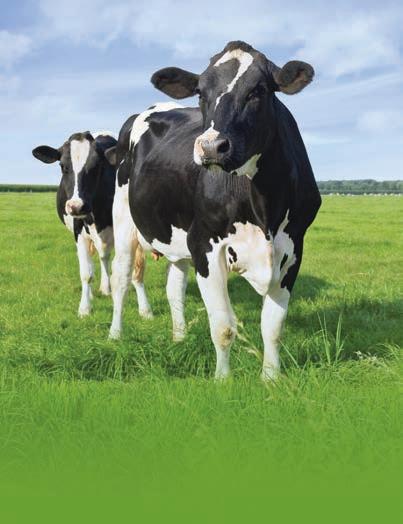






He says: “As far as I am concerned, I need cows with strong feet and legs as we walk our cows up to ve kilometres each way a day. And they need a big wide mouth to shovel in as much grass as they can.
“ ese are the traits my father believed in and I believe they have served us well. I think if you build a
strong chassis, that vehicle will last you a long time.”
Cows are bred to AI from the beginning of April for six weeks, before running with bulls for another six weeks.
Mr Smith says: “ en, any cow we did not get in calf, we do a six week joining in mid-November as a second chance and to give us some fresh cows over the summer when I am running on low numbers.”
He has no plans to expand his operation in the future. Instead, he wants to ne-tune his system to allow him more time with family.
Labour shortage
As for the problems associated with milking cows in Australia, he admits issues with labour availability is crippling the industry.
Mr Smith says: “Although we have excellent long-term







employees, dairy farmers here generally nd it almost impossible to nd local labour as the younger generation are not interested in manual labour jobs anymore. I think that is why we may have to think of making the dairy industry more a ractive in the future.
“ e use of milking robots and smarter machinery may be the only way to a ract the younger generation back to our farms.”
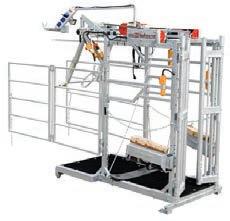
21 MAY 2023
Prefer to speak to a human? Give us a call on 01963 824448 "Thank you to Steve and his team for an excellent and very quick service and very competitive prices every time, thanks!” JOHNNY
LANCASHIRE LAMENESS WORKSHOPS October 22 £125 per person Steve
The UK's leading cattle foot care company TRIMMING • TRAINING • SUPPLIES Free next working day UK mainland & Ireland delivery ORDER BY 3PM when you spend £100 online excluding VAT Make your life easier with our Electric Farmer Crush Do ring us if you’d like more information!
MILLER,
Paul Limited
Cowsfeet advert Farmers Guardian 200x130mm March 2020.indd 1 14/02/2020 09:40
From farmer cattle crushes to wooden blocks, we have everything you need to keep your cows' feet healthy!
The cows are pasture-based and remain outdoors in one single milking group all year long.
Genomic sire retains top ranking Y
oung sire Wilra SSI Faneca Ebersol, which made its debut on the genomic sires ranking last December, retains its number one position at the top of the new Pro table Lifetime Index (£PLI) ranking, published in early April by AHDB.
Despite the base change, which now occurs each year with the April genetic evaluations and has pulled young sire gures down this month by £45 £PLI, this son of Badger SSI Lucia Faneca still earns an impressive £PLI of £945.
This is achieved through high Predicted Transmitting Abilities (PTAs) for fat (50.3kg, +0.26%), as well as superb udder health (-3 Mastitis, -29 somatic cell count) and a high daughter Fertility Index (FI) of +10.6.
Moving up to second position is DG Peace (£PLI £898), a son of Genosource Captain, which also leads the daughter-proven sire rankings.
Peace transmits exceptional protein (38.6kg) and high Feed Advantage, which helps him achieve the Holstein
breed’s highest score for EnviroCow.
A new entrant in third place is Peak AltaKalon, a sire with high protein percentage (+0.14%), solid daughter
fertility (FI +10.9) and shorter than average gestation length (-3), which earn it a £PLI of £891.
Denovo 17835 Lennon-P ranks
Top 10 Holstein bulls with genomic young sired ranked on £PLI
fourth, with very good Calf Survival (+2.5), a high daughter Lifespan, and a £PLI of £887.
e next three places are taken by new entrants since the December release in the shape of Peak AltaMorpheus, Denovo 2776 Leeds and Peak Powerhouse.
AltaMorpheus (£PLI £883) has superb udder health (-3 Mastitis) and the highest lifespan (+177 days) of the top 20 young bulls, also earning him the highest HealthyCow in the top rankings.
Those looking to inject a flush of milk into their cows will find outstanding production (1,278kg) in Leeds (£PLI £879), whereas PowerHouse is the highest protein transmitter of the breed, at 42.6kg. His £PLI is £877.
Stability for block calving herds
JWith the spring breeding season well and truly upon us, producers using grazing based systems will find a reassuring consistency among bulls ranked on Spring Calving Index (£SCI).
Progenesis Wimbledon remains in number one position, with lower milk volume and high components, combined with a
very high daughter Fertility Index and shorter than average gestation lengths, contributing to its £SCI of £588.
This Holstein bull’s genetic performance on this cross-breed ranking, stands just ahead of second placed Denovo Invictus (£SCI £552). With 427 UK milking daughters contributing to its

high-quality milk index, Invictus also breeds smaller sized daughters which will improve maintenance feed costs.
New Zealand-bred Diggs Hardcopy holds on to third position with excellent fat and protein percentages and high fertility all contributing to his £SCI of £550.
Producers calving in an autumn
Continues over the page...
block may also look to the versatile sire, Genosource Captain, which takes the lead in the £ACI ranking with an £ACI of £708, having graduated from the genomic list.
Progenesis Wimbledon moves up into second (£ACI £677) and last time’s number one, Pine-Tree CW Legacy, is third (£ACI £661).
22 BREEDING BULL PROOFS MAY 2023
£PLI Bull name Milk Fat Ptn SCC LS FI Feed Env TM Sire Supplier kg kg kg Adv Cow 1 945 Wilra SSI Faneca Ebersol 676 50.3 29.3 -29 119 10.6 225 4.4 0.64 Faneca WWS 2 898 DG Peace 956 45.8 38.6 -18 104 5 251 4.6 0.66 Captain CBL 3 891 Peak Altakalon 666 41.4 34.5 -19 137 10.9 154 4.2 0.73 AltaKevlow ALT 4 887 Denovo 17835 Lennon-P 627 45.9 28.8 -17 159 10.6 195 4.4 1.26 Mendel GEN 5 883 Peak Altamorpheus 666 44.8 28.5 -24 177 10.5 144 4.2 -0.08 Curfew ALT 6 879 Denovo 2776 Leeds 1278 50.5 38.7 -18 143 4.2 204 4.5 0.66 Laker GEN 7 877 Peak Powerhouse 986 49.4 42.6 -10 119 1.5 114 4.4 1.4 Wheelhouse UKD 8 875 Peak Altaseverus 856 42 36 -23 153 14.3 146 4.3 -0.24 Altaplinko ALT 9 872 DG Space 663 41.2 31.3 -24 104 10.9 119 3.7 1.22 Captain CBL 10 871 Winstar Maserati P 667 53.5 27.8 -18 153 10.1 131 4.1 1.01 Mendel GEN Source: AHDB Dairy. Notes: ALT = Alta; CBL = Cogent Breeding; GEN = Genus ABS; UKD = UK Sires Direct; WWS = World Wide Sires UK; SCC = somatic cell count; LS = lifespan; FI = Fertility Index; Feed Adv = Feed Advantage; Env Cow = EnviroCow; TM = Type Merit.
Dam of Wilra SSI Faneca Ebersol, the leading young genomic sire.
Improving herd performance and fertility can often feel like an uphill battle –BUT YOU DON’T HAVE TO TACKLE IT ALONE.

Our industry-leading sexed semen, extensive range of trait-topping genetics, innovative herd management solutions, and the unparalleled knowledge of our Genetic Consultants are your perfect partners to accomplishing the peaks you never thought you would reach.

WE HAVE THE MEANS, WHATEVER THE CHALLENGE…’

FREEPHONE: 0800 783 7258 | WWW.COGENTUK.COM
Captain tops daughter-proven list
JThe appearance of Genosource Captain at the top of the ranking for daughter-proven Holstein sires offers a resounding endorsement to those who put their faith in this bull in its early years.
Captain featured as a leading young sire in successive genetic evaluations based on his DNA alone and now comes through with a convincing lead as daughters come into milk.
The earliest daughters contributing to these figures are milking in the USA, but UK heifers will shortly join their numbers, increasing the reliability of Captain’s Profitable Lifetime Index (£PLI) over the months ahead.
In April’s evaluations, Captain gains a convincing lead, with
a £PLI of £888. Its breeding pattern demonstrates strong production, good feed efficiency and a high EnviroCow index, while its Type Merit increases to 1.93 as daughters start to be classified.
Making significant gains and climbing into second position is Denovo 14566 Crosby, with 518 UK milking daughters contributing to its £PLI of £719. Notable in its index is excellent Calf Survival at +4.8.
Holding third place is Pine-Tree CW Legacy (£716). An outstanding daughter Fertility Index of +13.7, extreme udder health (-4 Mastitis) and long lifespans (+171 days) give Legacy one of the highest HealthyCow indexes of the breed at £323.
Top 10 daughter-proven Holstein bulls ranked on £PLI
In equal fourth place with a £PLI of £712 are Silverridge V Einstein and Bomaz Monument P.
AHDB’s Marco Winters says: “As we have come to expect, some of the big hitters from the
genomic rankings now appear in the daughter-proven figures and Genosource Captain provides a convincing example of how milking daughters can live up to genomic predictions.”
Three new number one bulls among non-Holstein breeds
JEach of the main non-Holstein breeds has a new leader in the April genetic evaluations.

The number one Jersey, JX River Valley Chief (6), has edged the long-term breed leader into second place, with a Profitable Lifetime Index of £425.
Breed record
It steals a march on its stable mate, most notably for Predicted Transmitting Ability for fat, at a breed record of 36.9kg.
Combined with 834kg milk
and 26kg protein, Chief also achieves a favourable maintenance rating at -14.
The JX prefix to its name indicates it has at least one ancestor of another breed within six generations of his pedigree, in Chief’s case generation six.
Dropping to second place is River Valley Cece Chrome (£PLI £420), which maintains its transmission of exceptionally high production, now with 565 UK daughters contributing to his PTAs.
In the British Friesian rankings,
Manorpark Google takes over the lead, with a £PLI of £370. Google transmits high weights of milk solids (22.6kg fat and 19.1kg protein) and shorter gestations, at three days less than breed average.
Highest Type Merit
Inch Persistent drops down one place, with a £PLI of £364, maintaining a high fat percentage (+0.17), good daughter lifespans (+134 days) and the highest Type Merit in the rankings (+2.27).
In the Ayrshire breed, a big jump in £PLI sees VR Venom head the table for the first time, with a £PLI of £485.
Venom transmits outstanding daughter fertility (FI 16.1), as well as solid production (304kg milk) and a good index for SCC (-10).
Venom’s good performance edges VR Vilano into second position, with an index featuring long lifespans (+95 days) and shorter gestations (-3). His £PLI is £431.
24 BREEDING BULL PROOFS MAY 2023
Other dairy breed indexes are published online at ahdb.org.uk/knowledge-library/dairy-breeding-and-genetics
£PLI Bull name Milk Fat Ptn SCC LS FI Feed Env TM Sire Supplier kg kg kg Adv Cow 1 888 Genosource Captain 968 46 33.2 -5 131 8.6 249 4.5 1.93 Charl CBL 2 719 Denovo 14566 Crosby 776 40 28.5 -22 61 4.6 125 3.2 -0.3 Charley GEN 3 716 Pine-Tree CW Legacy 460 26.7 17.6 -32 171 13.7 166 3.3 0.07 Frazzled WWS 4 712 Silverridge V Einstein 722 39.2 30.4 -24 76 9.4 20 2.9 1.26 Topnotch SMX 4 712 Bomaz Monument-P 496 37.1 23.3 -15 128 8.2 138 3.5 0.11 Medley GEN 6 709 Denovo 7899 Archer 855 46 39.3 -14 -6 -5.2 103 3.3 1.33 Achiever GEN 7 708 Progenesis Wimbledon 27 33 21.6 -23 79 15.3 -37 2.5 0.13 AltaRobson SMX 8 699 Blumenfeld Renegad Ahead 483 38.2 23.7 -14 153 10.5 29 3.2 1.22 Renegade WWS 9 698 Aardema Pistolero 452 27 23.3 -18 137 8.9 125 3.2 0.38 Guarantee SMX 10 697 Westcoast Alcove 1122 51.2 39.6 9 40 2.9 55 3.4 1.24 Duke SMX
Source: AHDB Dairy. Notes: CBL= Cogent Breeding; GEN = Genus ABS; SMX = Semex; WWS = World Wide Sires; SCC = somatic cell count; LS = lifespan; FI = Fertility Index; Feed Adv = Feed Advantage; Env Cow = EnviroCow; TM = Type Merit.
Daughters of Genosource Captain, the number one daughter-proven bull.
BECAUSE IT’S ABOUT RESILIENCE









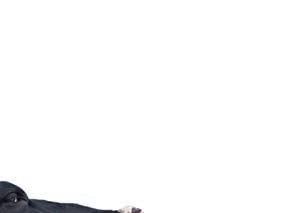






Creating generations of healthy cows.

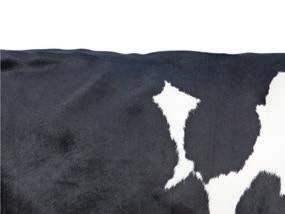
At the onset of lactation, a cow’s need for potassium increases. Various stress factors can drive up the potassium requirement even further. To enable dairy farmers to easily and cost-effectively fill the potassium gap, Evonik offers K-pron®, the most effective potassium source. Thanks to our scientific approach, K-pron® has an exceptionally high level of purity that delivers tangible benefits: animal welfare, high milk yields and healthy profits. Sciencing the global food challenge. | evonik.com/k-pron


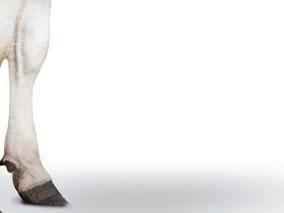






Lancashire vet Tasha Kirby has established a family partnership selling pedigree Holsteins from a small farm with no milking facilities. Wendy Short finds out more.
One of the definitions of the word absolute is ‘without limits’, and it was for this reason that Tasha Kirby’s breeding enterprise took the brand name ‘Absolute Genetics’ when it was set up in 2007. Dealing predominantly with North American bloodlines, the business sells sexed embryos and 10 to 15 calves annually which are marketed at between £3,000£10,000-plus/head.

Miss Kirby, who also has a full-time job with Ribble Vets, near Preston, is in business with her mother, Jane e, and her father, Graham, who works for Semex.

Miss Kirby says: “In our opinion, North America has some of the best bloodlines for dairy cattle, although there are also some very good herds in Holland and we sold three calves there last year. Our customers are mainly UK milk producers who are looking for fresh bloodlines for their pedigree programmes, and some calves will go on to a career in the show ring.
No milking
“Our lack of milking facilities means that we rarely keep home-bred females.
“ e embryo recipients are bought from a neighbouring unit in batches of 10 to 12, with a high health status as 12-month-old heifers, and sold on a er having one calf.”
UK dairy farmers’ requirements have changed slightly over the past decade, she comments.

“Buyers previously wanted a tall, rangy Holstein, but more recently they prefer a slightly smaller and more powerful animal. Females need to have good commercial traits, which include high yields and longevity, as well as the ability to thrive in cubicle housing.
“Although we like to have competition winners, we are not looking to breed ‘show ponies.’ Conformation-wise, we aim for a sloping rump to allow for wider opening of the pelvis. is is to
A family breeding business ‘wi
reverse the fairly recent trend towards breeding animals with high pins. ey should also be clean-boned with slightly more sickle to the legs, have a good teat length to facilitate milking and a decent width of chest.
“ e introduction of genomic testing has taken some of the guesswork out of breeding decisions, but we still get the odd
surprise. One of the cheaper embryos may produce a superb calf on occasion, while a more expensive purchase may be slightly disappointing. at is part of the interest in breeding and it is always exciting to watch a young calf grow and develop.”
e family spends a long time scrutinising Holstein pedigrees
26 BREEDING MAY 2023
Our customers are mainly UK milk producers who are looking for fresh bloodlines for their pedigree programmes, and some calves will go on to a career in the show ring
TASHA KIRBY
PICTURES : Adrian Legge
breeding thout limits’


and will usually source ca le related to winners of the two main global ca le shows: the Royal Agricultural Winter Fair ( WF) in Canada and the World Dairy Expo in the USA.
Showing
Ca le showing is a vital element of business marketing.




“It took several years for our Absolute Genetics pre x to become widely recognised, and the show circuit gives us a shop window,” says 27-year-old Miss Kirby.
which took the supreme heifer championship at the 2022 UK Dairy Expo and was All Britain Senior Heifer 2022. She later sold for 25,000gns to Hullcrest Holsteins in Holland. In addition, Absolute Summerfest TikTok won the autumn-born calf youngstock class at this year’s UK Dairy Expo.”


Calving is all year round, with the aim of having calves ready for the main showing events.
All the pens are straw-bedded and the herd is vaccinated for protection against BVD, leptospirosis and IBR, while recipients are given a rotavirus vaccine and
“Our entire holiday leave is taken up by shows and sales. One major win was with Absolute Doorman She’s A Belter, Continues over the page...
27 BREEDING MAY 2023 The first dairy compound range with SHEEP BEEF PLANET DAIRY PLANET PLANET Successfully fed on farms since 2019 ZERO soya and palm kernel Contact Massey Harpers Feeds: Holmes Chapel: 01477 536300 Preston: 01772 206200 Holsworthy: 01409 254300 or scan: Fo cu se d on n utriti on Fo cu se d on n utriti on Reduce your carbon footprintwith
The Absolute Genetics show team with (left to right): Richard Green, Graham Kirby, Tasha Kirby, Will Horsley, Jordan Murphy and Amelia Hull with show cow Absolute Unix Suzette.
BREEDING
routinely tested for Johne’s disease and neosporosis.
Miss Kirby acknowledges that the ‘tailored’ diets she uses for the ca le would not be viable on a commercial dairy farm, but stresses their importance for ensuring viable calf births and securing a price premium.
“ e concentrate feed is formulated to our requirements,” she explains. “ e recipients have hay, plus a 16% protein ration high in energy and amino acids.
“Neonatal calves are given three feeds of colostrum high in immunoglobulin in the rst 24 hours of birth, followed by six to eight litres of milk per day.
Weaning
“Weaning is relatively late at 12 weeks, but it helps to lay the foundations for a strong calf which will grow on well.
“ e weaned calves are given a 20% protein cake plus alfalfa, which is a tremendous feed and provides roughage to promote rumen development and liveweight gain.
“Calf jackets help to maintain optimum growth rates, and if the weather is cold, they will also be given to older calves, especially if they have been clipped for showing.
Award win
JMiss Kirby is a long-standing member of the Lancashire Holstein Young Breeders Club, and this year won the Holstein UK President’s Medal.
The award aims to recognise and reward young talent in the next generation of dairy farmers, and Miss Kirby has also been active in encouraging even younger members to develop their skills.

She says: “I was delighted with the win and thrilled that it includes sponsorship to the RAWF in Toronto this autumn.
“ e dietary protein percentage will eventually be reduced to an 18-19% formulation.”
e Kirbys moved from a rented building seven years ago to purchase some land on which they built a house and put up a ca le shed. ey now farm just under 11 hectares (27 acres).
As a child, Miss Kirby was given two calf embryos for her birthday in an e ort to
“Holstein UK sadly lost its first female chief executive officer, the late Sue Cope, last year, and I am the first female to be awarded the Sue Cope Memorial trophy, which is given to the President’s Medal winner.
“It is a great honour and Holstein Young Breeders membership has been highly beneficial to me; it has helped me with my career and given me a great social life – I have made friends from all over the world.”
discourage her passion for horses.
“My father’s plan was 100% successful and I have completely lost my interest in horses.
“He kept repeating that there was no money in horses and suggested that I could make a living out of ca le; I am very grateful for that advice.
Beginnings
“In fact, these rst two embryos were actually Jerseys; I sold the bull calf and the cow went on to have heifer calves which helped to fund my veterinary studies. at Jersey cow is now 16 years old and, although she is no longer bred from, I keep her as a reminder in case I ever have thoughts about ge ing a horse.
“However, that is not really necessary as I have plenty on with my job and running a business.
“I want to focus on breeding Holsteins that will be long-lasting and successful for their future owners.”
Her veterinary quali cation and the family history of producing good results from embryo implants have led to a potential idea for the future.
“We might set up a service for dairy farmers who want to invest in embryos but lack the time or facilities to see them through to the live calf stage.
ere are no plans to increase numbers, however, because a small herd gives us the opportunity to give each animal individual a ention, and focus on quality,” says Miss Kirby.
28
MAY 2023
It took several years for our Absolute Genetics prefix to become widely recognised, and the show circuit gives us a shop window
TASHA KIRBY
Tasha Kirby with show cow Absolute Unix Suzette.
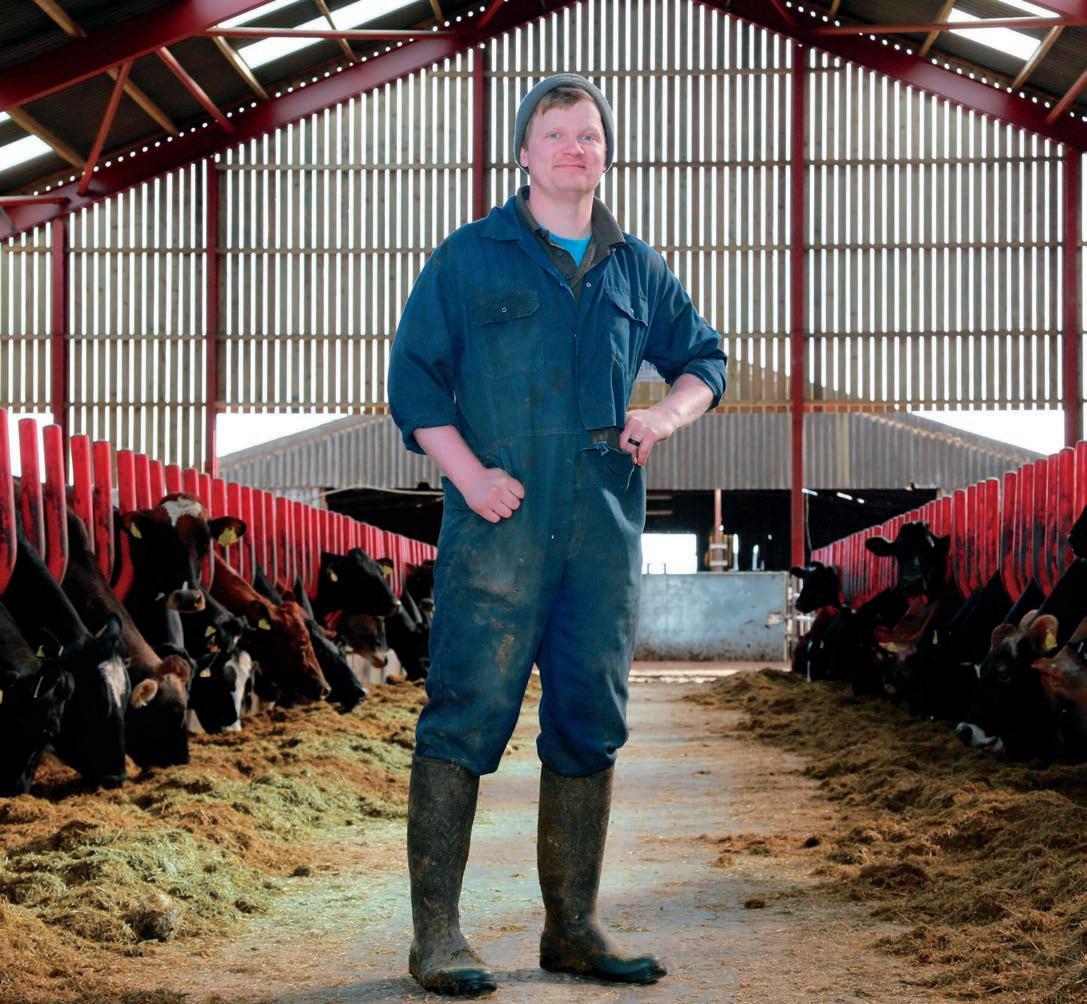





29 MAY 2023 I would not look back after making the switch to EASYFIX, just seeing how comfortable and content the cows are, a picture paints a thousand words www.easyfix.com Providing Farmers With Peace of Mind 07985 602767 - Tom Pemberton, Dairy Farmer Our Dairy Housing Solutions Are Grant Approved! Call For A Free Quotation Flexible Cow Cubicles Cow Mattresses Feed Rail
A Code of Practice could end the dominance of Canada’s popular tiestall barns. Chris McCullough reports.
Canadian housing changes
For dairy farmers planning to erect new barns in Canada it would be unwise to build the traditional tiestall option given the new parameters surrounding cow welfare launched in the latest Code of Practice.
e long-awaited Code of Practice for the Care and Handling of Dairy Ca le replaces its predecessor developed in 2009 and comes into e ect on April 1, 2024.
As well as new guidance, which will end continuous tethering of cows, it will also see the phasing in of new laws to allow cows extra space, which the industry says could force dairy farmers who have recently built new freestall barns to reduce their cow numbers in the future.

Designed, regulated and released by the National Farm Animal Care Council and Dairy Farmers of Canada, the Code is regarded as a powerful tool for meeting rising consumer, marketplace and societal expectations relative to farmed animal welfare.
e development of the Code was led by an 18-person commi ee,
Main housing updates
JThe main updates released in the Code refer to new requirements in housing for cows and calves.
There are almost 10,000 dairy farmers in Canada and more than 70% of dairy farms in the country which are non-robotic use tiestall housing.
Effective from April 1, 2027, this new Code insists cows must not be tethered continuously throughout their entire production cycle, calving to calving.
It states newly built barns
which included participants from across Canada, including dairy farmers, animal welfare and enforcement representatives, processors, researchers, veterinarians and government representatives.
Adjustment
Some aspects of the Code will take e ect in later years, giving farmers time to adjust to the new requirements. Any part of the Code which falls under ‘requirements’ means it must be implemented by the date mentioned and any ‘recommendation’ is a suggestion or good advice.
Most of the latest updates to the Code are aimed at improving the welfare of cows and calves, following the trends Europe has already implemented.
It has been quite a heavily guarded secret until now, but the new Code will raise some questions over the next few months.
Two new general additions to the Code are that all farm personnel must be aware of it and that branding of ca le has been banned.
Canadian Minister of Agriculture and Agri-Food, Marie-Claude Bibeau, says: “Canadian dairy farm-
ers care about protecting the health and welfare of their farm animals. “ is updated Code of Practice will help them continue to enhance the care and handling of animals, while boosting consumer condence that our food system is meeting the highest standards.”
JThe new Code also addresses calf housing and states calves must not be tethered in indoor housing and, if outdoors, can only be tethered via a collar in a calf hutch with access to an area outside the hutch.
must allow daily, untethered freedom of movement and social interactions year-round, a hint that tiestall barns could be a thing of the past.
Having adequate space for calving in a barn is also essential, and, effective from April 1, 2029, cattle on all farms, including existing barns and for those being built, must calve in loose-housed maternity pens, yards or pastures which permit them to turn around.
Stocking densities of barns have also been identified as a new welfare requirement,

therefore increasing the space per cow when housed.
Stocking density
From April 1, 2027, the stocking density must not exceed 1.1 cows per stall. Then from April 1, 2031, the stocking density must not normally exceed one cow per stall.
Resting areas in group pens must provide at least 9.3sq.m (100sq.ft) per Holstein cow. These space requirements will be adjusted for smaller breeds.
Producers raising calves individually must develop a plan to transition to pair or group housing methods in consultation with a vet or other qualified adviser.
Then, effective from April 1, 2031, calves which are healthy, thriving and compatible must be housed in pairs or groups by four weeks of age.
Calves must be dehorned by two months of age and banding as a method of dehorning will be banned.
30 HOUSING MAY 2023
Calf housing
From April 2027, Canadian dairy farmers will be prohibited from keeping cows in tiestalls.
with the public effectively is key
With a record number of schools and consumers seeking opportunities to connect with farmers, there are plenty of training courses and educational initiatives available to boost communication style, welcome new groups and develop new skills.


Visit My Farm
Developed in collaboration with educational partners and supported by some of the leading agricultural stakeholders, Visit My Farm has advice and educational courses for farmers.
■ Visit visitmyfarm.org
Cevas Training
The Countryside Educational Visits Accreditation Scheme is a detailed training programme aimed at those wanting to provide on-farm education or farming experiences for schools.
■ Visit visitmyfarm.org
Farmer Time
A unique initiative for farmers to engage with schoolchildren through video calls to educate on the journey from farm to fork.
■ Visit visitmyfarm.org
Leaf Education
Get access to courses, advice and training materials to begin or continue the journey of promoting appreciation for British farming in every day life and inspire the next generation.
■ Visit leaf.eco/education/for-farmers/ get-involved
Advice guides
WE are producing a series of downloadable advice guides about how better improve communicate with consumers and how to recruit and retain good staff.
■ For more information, visit FGinsight.com/ThisIsAgriculture

Cevas Plus
Cevas Plus is a refresher course for those who took the qualification more than two years ago and who want to update their knowledge and skills surrounding educational visits on-farm.

■ Visit visitmyfarm.org/courses
Speakers For Schools
Delivered by NFU Education, farmers are offered presentation training to deliver to local secondary schools. The 45-minute session provides media content, quizzes, farm myth-busting and opportunity for discussion and questions.
■ Visit education.nfuonline.com/ SpeakersForSchools

In the field
THE Kirkham family run a traditional, year-round-calving 80-strong herd and mixed farming enterprise in Lancashire, and are inspired by the children who regularly visit.
Social media
Headed up by Harry and Janet Kirkham, with son and daughter, John and Helen, it was Helen who noticed the raft of inaccurate information about farming on social media, and decided to begin hosting school visits in 2019.
This year, the farm has welcomed 1,000 schoolchildren, 66 per cent of which had never been to a farm.
“These children, who spend their days learning out of a classroom, arrive thinking they are on a day out.
“They then run through our fields, witness a calving, go digging for dung beetles and by the time they leave they are in awe of what they have seen and done. They truly are our inspiration,” says Helen.
31 MAY 2023
Communicating
Educating children is vital towards a positive future for British farming.
With studies showing that heat stress can lead to significant production losses, dairy farmers are being urged to take action to help mitigate this issue. Ellie Layton reports.
Plan ahead to prevent heat stress and losses


Changing weather pa erns, as indicated by last summer’s drought, are leading to an increase in problems associated with heat stress. With this in mind, Nico Vreeburg, ruminant technical support manager for Lallemand, encouraged farmers to start thinking now about how they can make cows more comfortable.
Speaking at the Cow Convention, an event held at the Royal Agricultural University, Cirencester, and organised by e George Farm Vets, Mr Vreeburg reminded


farmers that cows started to show signs of heat stress when temperatures reached 21degC, but losses started to occur much earlier, when
temperatures were at 18degC. He said a Lallemand study had shown that cows could see yields drop by as much as 200 litres per lactation through heat stress, but there were also longer-term losses to consider, such as poor fertility, hoof problems and poor early growth in calves.
Cows that are experiencing heat stress are more likely to stand, which, as Mr Vreeburg explained, could lead to increased foot problems such as white line disease and sole ulcers – all problems that would make cows less inclined to walk to their source of feed.
Studies also suggest that over a period of six days, cows experiencing heat stress lose up to four hours of resting time, which has a negative impact on production.
Fertility







Furthermore, he said rising body temperatures could impact fertility. “When temperatures rise, the formed embryo can die, ovulation can be interrupted and ketosis and lower body condition scores can cause long-term problems.”





Production challenges posed by heat stress can be alleviated


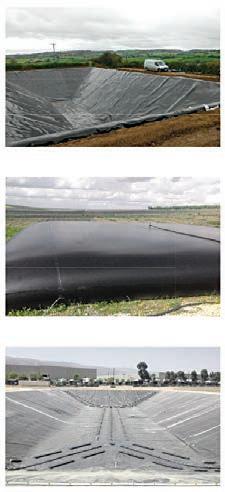
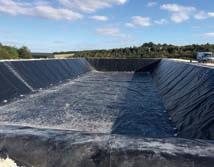

32 HEAT STRESS MAY 2023 YOUR DEPENDABLE PARTNER FOR SLURRY STORAGE SOLUTIONS enquiries@enviroseal.co.uk t: 01695 228626 www.enviroseal.co.uk SLURRY LAGOON FLOATING COVERS Keeps rainwater out of slurry Reduces odour from lagoons Covers comply with EA and SSAFO legislation SLURRY LAGOON LINERS Comprehensive 25 year warranty Materials meet EA and SEPA requirements Installed and tested by certified technicians Enviroseal provide a complete range of products for slurry storage Lowlander ® Manure Spreaders Twin Vertical Auger TVA | 6 – 40 tonnes Horizontal Beater & Spinning Disc HBD | 8 – 40 tonnes bunning spreaders www.gtbunning.co.uk Tel: + 44 (0) 1362 860352 3 Year Warranty | Details available upon request
Nico Vreeburg
by acting on reduced dry ma er intake, which happens as temperatures increase, said Mr Vreeburg.
“When feed intake decreases due to heat stress, nutrient concentration should increase to maintain the required nutrients. Low-quality, brous forages generate more heat through fermentation inside the rumen, while high-quality forages are digested faster and result in less heat being produced.
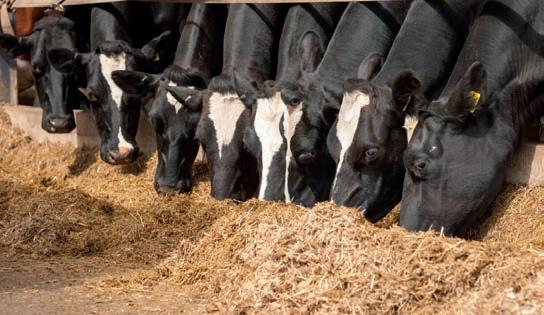
“Increasing the energy density of the diet may require greater amounts of concentrate, but should help the animal maintain energy requirements even when consuming less dry ma er.
“However, this should be managed properly with a nutritionist to avoid digestive disorders such as acidosis and a displaced abomasum,” said Mr Vreeburg.
Changing feeding times so that about 60% of the ration can be fed between 8pm and 8am has also been seen to help in improving intakes.
He also said water supply was critical, as water intakes could increase considerably in hot weather.
For example, said Mr Vreeburg, a cow producing 21 litres of milk per day would drink 103 litres of water when the temperature was 21degC, and 109 litres of water when the temperature was 27degC. A cow producing 45 litres of milk per day would drink considerably more – 128 litres of water when the temperature was 21degC and 135 litres of water when the temperature was 27degC.
He also urged farmers to think
Fusion Dairy Feeds
Sustainable High Performing Feed
about changes that could be made to buildings to help cows cope with heat stress.

Housing
“Cows can spend up to 75% of their time inside, so it is worth investing in good housing. Badly designed sheds could be ve degrees ho er than the temperature outside, but in a well-designed shed, the temperature could be ve degrees cooler,” he said.
“Sheds should not have high walls. Instead, curtains or weather breaks should be used as an alternative. is will help keep cows sheltered from weather but give much be er air ow than concrete walls.”
He also advised insulating roofs and cooling cows with sprinklers or vertical fans. If designing a new shed, Mr Vreeburg said white roofs could help keep the building cool.
When cows were at grass, Mr Vreeburg said stock should have good access to water, appropriate shelter and access to a shed if possible.
• The Fusion range features a high fibre, a starchy and a high protected product diets, available in different proteins to suit a range of systems.
• Ultra Pro-R is a high-quality vegetable protein which, as a result of precise treatment of rapeseed meal, contains a high level of DUP.
• Ultra Starch-W, a protected wheat, aids rumen health to achieve feed utilisation, reducing the rate of ‘quick fizz’ in the rumen preventing a pH drop.
• Formulated utilising British and/or European grown raw materials helping to reduce agriculture’s carbon footprint, keeping raw material provenance in mind.


Fusion
• Manufactured at NWF feed mills in Cheshire, Cumbria and Devon.
0800 756 2787 www.nwfagriculture.co.uk

33 HEAT STRESS MAY 2023 Get in touch for feed and expertise
Available
Rearer Now
The NWF Fusion Dairy feed range is free from soya, soya hulls and palm kernel. Efficient and cost-effective rations for early lactation and high yielding cows.
When feed intake decreases due to heat stress, nutrient concentration should increase NICO VREEBURG
Mr Vreeburg advised insulating roofs and cooling cows with sprinklers or fans.
The dairy cow of the future is likely to be highly productive, much more resistant to disease and ‘inevitably’ smaller in stature, said Prof Mike Co ey of Scotland’s Rural College (SRUC).
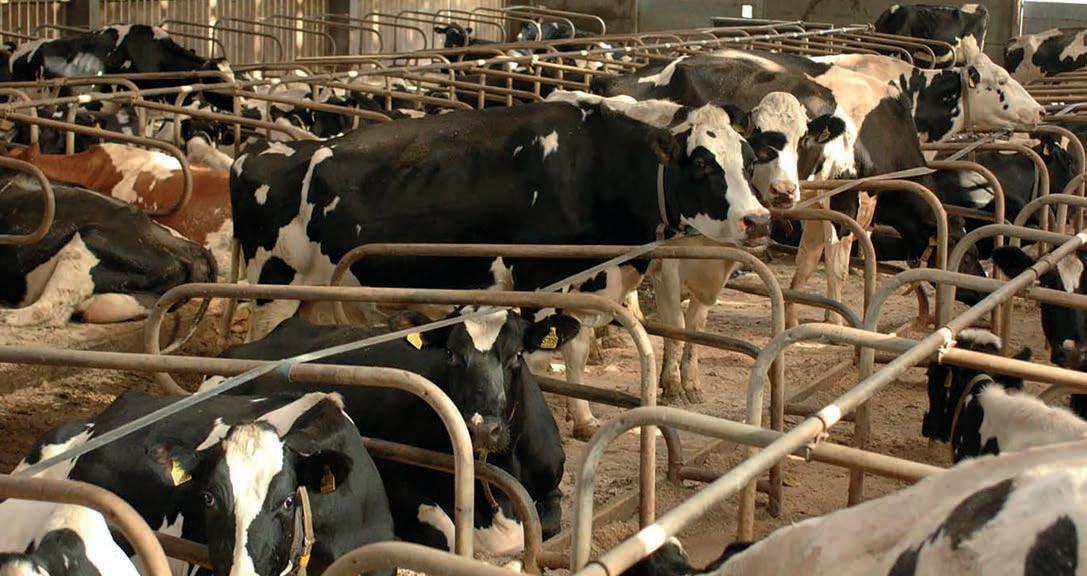
Prof Co ey, speaking during a genetics session, also said that the forces which drive change within breeding decisions were changing.
He said: “Historically, market forces have driven breeding decision, but the luxury of those days

The ‘dairy cow of the future’ was a hot topic at this year’s British Society of Animal Science’s annual conference in Birmingham. Katie Jones reports.
Dairy cow of the future
has gone. e Government and retailers, as spokespeople for the consumer, will now drive that change.”
He said the industry was already seeing this and pointed to the requirements around the shooting of bull calves as an example of this.
He said: “We will see a lot more
enforcement of change in the future, rather than allowing things to change organically.”
He said the possibility of reducing the size of dairy cows in the future was well debated and was starting to gain traction as bigger cows made ‘no sense’ in terms of e ciency
What do we know about teat necrosis?
JDigital dermatitis may not be the main cause or contributing factor in on-farm cases of ischaemic teat necrosis, according to research work carried out by Hayley CrosbyDurrani, of the University of Liverpool.
Ms Crosby-Durrani explained her research had been carried out to find out more about this apparently naturally occurring disease, which was first reported in 2004 and anecdotally appears to be becoming more prevalent.
She added that research into
the disease was limited, but a previous study had suggested that digital dermatitis treponemes were found in most cattle suffering with teat necrosis. However, this was not the case in her own research.
She said: “Only one-third of cases of teat necrosis identified in my research also had evidence of digital dermatitis treponemes.
The idea that digital dermatitis is closely linked to teat necrosis needs to be examined further.”
However, her research which included a questionnaire about
the disease which went out to more than 1,800 farmers and pathological screening of identified cases, suggested that teat necrosis was ‘widespread’ across GB and first lactation heifers within the 90 days in-milk timeframe were most at risk.
“Only 20.9% of cases were reported to recover and 22.8% of cases required rapid culling.”
She also said potential farm level risk factors included on-farm cases of udder cleft dermatitis and chapped teats.
and environmental considerations. However, he added that it was also well discussed that cows in general had been ge ing bigger in recent times.
“However, there are very few records of cow liveweight and, instead if we look at cull cow weights, the data suggests weight is fairly static.”
Prof Co ey highlighted the array of ‘tools’ which had already helped dairy farmers get to where they were in regards to breeding and genetics.
Firstly, he pointed to genomics, which were ‘accelerating progress’.
He said: “ e herds which are genotyping all animals are making much more rapid progress, than those which are only genotyping a small selection.”
And he said the genotypes of the future would do ‘many things’ for cows of the future. is included parentage checking and discovery.
“We will know much more about the dairy cow of the future and we will know where she comes from; she will have ‘provenance’.”
34 CONFERENCE BRITISH SOCIETY OF ANIMAL SCIENCE MAY 2023
The issue of a reduced stature cow was starting to gain traction due to efficiency and environmental considerations.




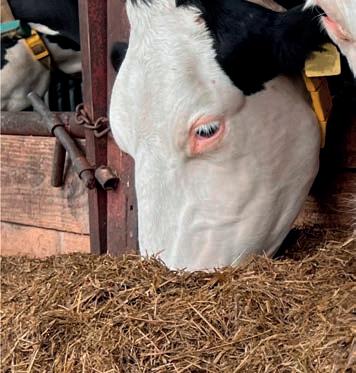


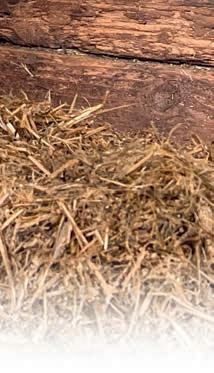

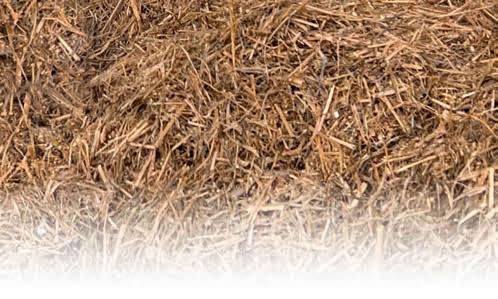


OPEN YOUR CAMERA TO FIND OUT MORE FEED YOUR HERD RUMISTART GREEN & HOVER OVER THE QR CODE T: 01576 205 480 E: enquiries.uk@kersia-group.com
GRASSLAND
As we look ahead to this year’s grass growing season, we discuss the potential use of protected urea, the benefits of monitoring soil carbon, and when and how to supplement grazed grass.
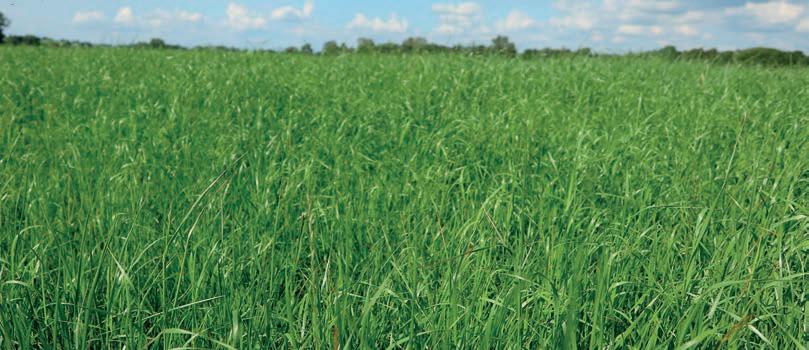
Adapting grassland strategy to cope with climate change
Increasing sales of dual-purpose grass mixes — those that are ideal for grazing and silage making — are but the rst hint that UK dairy producers are starting to hedge their bets when it comes to making decisions about their grassland management.
Jim Juby, of Horizon Seeds, says dual purpose leys are ‘without doubt the biggest sellers at the moment’.
is, he says, is symptomatic of the uncertainty among producers regarding the best approach to take in view of increasingly variable growing conditions.
High resilience upland grazing mix
r1.5kg intermediate perennial ryegrass
r2kg intermediate perennial ryegrass (tetraploid)
r1.75kg late perennial ryegrass
“You can talk to producers about their plans at the start of the year and when you visit them later, they have ended up doing something completely di erent,” he says.
“ ere was either too much rain, too li le or soil temper-
r4kg late perennial ryegrass (tetraploid)
r2.5kg soft leaf tall fescue
r1.25kg Timothy
r1kg white clover blend

atures took too long to warm up, so their decision making was continuously on the move.”
Even more illuminating than the growing popularity of dual-purpose leys is the number now choosing mixes designed for hill grazing rather than
classic dairy farming, he says.
“We have an upland grazing mix which is an extremely hardy, long-term grazing ley formulated speci cally to thrive in di cult upland pastures and on heavy clay soils, but it is now increasingly in demand by milk producers [see panel for more details].
“It is a real sign that many milk producers’ mindsets are changing from chasing yields and production to thinking more about persistence and resilience in their leys and how to best manage the risks associated with more variable growing conditions.”
Continues over the page...

36 MAY 2023 40 PROTECTED UREA Cost-effective alternative to AN 42 SOIL CARBON Benefits to environment and grass management 46 BUFFER FEED Successfully supplement grass 48 TRIAL FARMS Grass and forage demo plots
Source: Horizon Seeds
Jim Juby of Horizon seeds.
More farmers are looking at changing to drought tolerant mixes of grass.
Kill docks for great grassland.

Market leading Doxstar® Pro kills docks.

If you have a problem with broad or curled leaf docks, Doxstar® Pro’s concentrated formulation combines the power of triclopyr and fluroxypyr to deliver outstanding dock control. It is highly e ective on chickweed and dandelions too and is very safe to your grass.

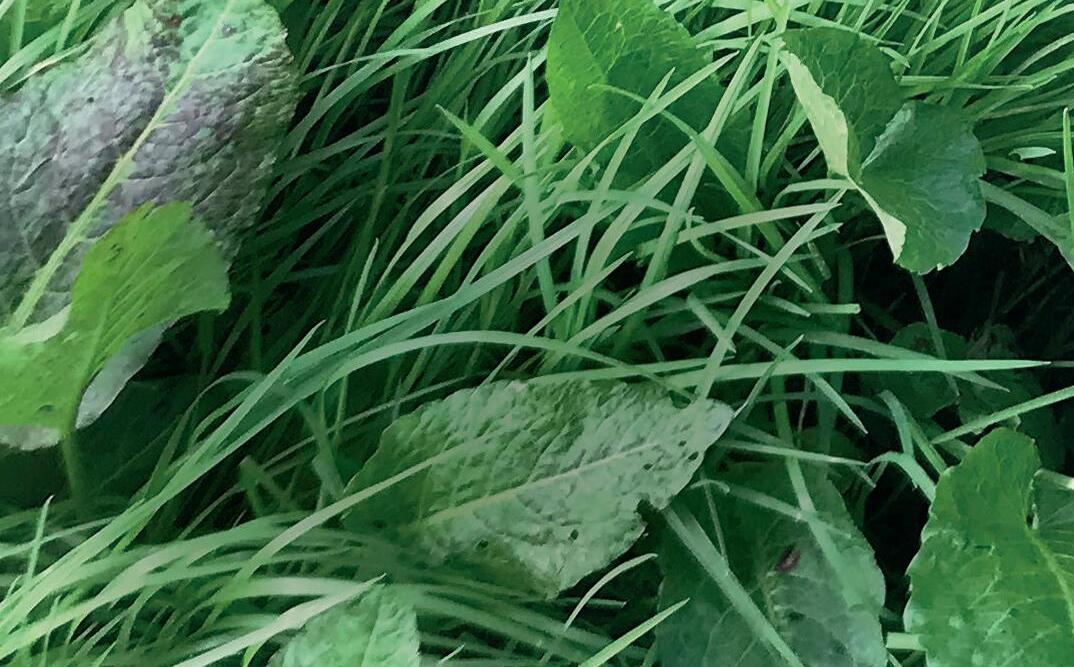

For harder working grassland, talk to your advisor or find out more at www.corteva.co.uk/forage



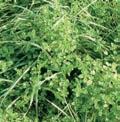
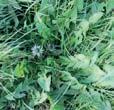
Dandelions Chickweed Docks USE PLANT PROTECTION PRODUCTS SAFELY. Always read the label and product information before use. For further information including warning phrases and symbols refer to label. Corteva Agriscience UK Limited, CPC2 Capital Park, Fulbourn, Cambridge CB21 5XE . Tel: 01462 457272. ®, ™ Trademarks of Corteva Agriscience and its a liated companies. © 2023 Corteva. Doxstar ® Pro contains fluroxypyr and triclopyr. Technical Hotline: 0800 689 8899 E-mail: ukhotline@corteva.com Free and easy to use, the Corteva Forage App is packed with information and tools to help you maximise your grass and maize crops. Forage knowledge on the go. go Download the Forage App now. Simply scan the QR code.
Grass growing strategies to cope with climate change
JMr Juby also says he believes there are four distinct grassland strategies now emerging dictated by region and weather with many
producers moving away from high yielding Italian ryegrasses to deeper rooting and more tolerant species mixes.
Drought problems for the East
JThe area that has seen most problems recently is in a line from the Wash area of East Anglia, all the way across into Hampshire, Wiltshire and the edge of Dorset. This is where resilience needs prioritising over yield, says Mr Juby.
“This area has suffered the most from drought in recent years, but it has also had to deal with extremes of weather including flooding and repeated drying out.
“Types of grass other than ryegrass really need focusing
on in such areas. Multi-grass species leys containing cocksfoot, tall fescues and hybrids all need to come into the mix.
“Tall fescues will be the last things to die in a drought, due to their deep and extensive root structures, and Timothy will be the first to recover after a drought. Having such species alongside ryegrass will mean you will always have something that can be grazed over the summer period, even when very little else is growing.”
Rain dictates for the South West
JToo much rainfall has become the problem in the South West of the country with counties such as Dorset, Devon, Cornwall and Somerset seeing episodes of extreme flooding, he says.
“Waterlogging, such as that seen in the Somerset levels and often caused by short but extreme episodes of heavy rainfall, is a real problem and causes a lot of damage.
“Species grass mixes again work very well in these conditions and cope much better with the stress of such events compared to ryegrasses.
Go Liquid
with the UK’s largest independent manufacturers of liquid fertiliser. Offering 24/7 dedicated support to UK grassland farmers, with national coverage and local service
Tall fescue may be one option in drought areas.
“Multi-species and herbal leys are also a good option.
“They survive winter conditions and cold, wet soils very well and have the added

advantage of strong roots that are able to get into the soil structure and help the water escape more efficiently.
“Soft leaf fescues will do much the same thing, with roots up to 1.0m deep disrupting pans and breaking up any consolidation.
“They also make swards more weather-tolerant as this massive root structure helps them survive most adverse conditions.”
The addition of such varieties also adds greater flexibility to the system, Mr Juby points out.
“Ryegrass has to be cut within one to two days of heading or the quality starts to drop, whereas with fescues this can be as much as seven to 10 days.”

Four ways to adapt your grassland strategy

rNorth: Milder winters mean grass could thrive better. Consider adding cocksfoot to mixes for an early bite

rEast: Droughts are becoming a major problem. Look at deeper rooting fescues, timothy and festuloliums to add resilience to swards
rSouth: Episodes of
flooding can severely damage grassland. Extensive roots of herbal mixes and soft leafed fescues can aid drainage by disrupting pans/consolidation
rWest: Still the best area for grass growth in UK. Stick with high yielding ryegrassbased mixes but watch out for extreme weather events, particularly in the winter
38 GRASSLAND MAY 2023
CONTACT US TODAY Call 01526 396000 Visit www.omex.com
West is best
JVirtually the only area where milk producers can plan on doing things much the same way they have historically is on the West coast, from Lancashire all the way down into Shropshire and Wales, says Mr Juby.
“It is the only area that has the luxury of being able to chase yield over reliability, so ryegrass dominant swards are still the most appropriate, but conditions need monitoring to get the best out of them.

“Summer utilisation is not really a problem, as autumn and spring rains are sufficient

enough to keep grass growing, but producers still need to be aware of the impact of high rainfall in shorter periods.
“This is a particular problem if it is followed by a cold snap as this can do a lot of damage to swards.

“Last winter, for example, was relatively dry until the rains came, but it was also mild so there was quite a bit of grass growth.
“When the heavy frosts then followed, grass really suffered.

“As a result, there are now some very sorry looking swards out there.”
New opportunities for the North

JThe final area is the North of England, up from the Midlands but barring the West coast strip.
“It is not easy to see a single trend emerging in this area, but we are generally seeing a pattern of milder winters, which could mean grass becomes a better option than some of the classic alternative forages such as kale and stubble turnips.
“Winterkill could be significantly less than it has been historically, so varieties that recover well in the spring, such as cocksfoot, could
have a growing role. Cocksfoot will start to grow at 1-2degC cooler than ryegrass and provide a ‘shoulder’ to the growing season, which means there could be an option for an earlier turnout, or grass will hold on better in a particularly difficult, wet spring.
“The bottom line is that if you are not in that West coast area, you have really got to start looking at more diversity in your grass leys and putting resilience and consistency above outright yield.”
39 MAY 2023 To achieve quality forage, you need to get the most out of your machinery. Innovation that will drive performance up and efficiency that won’t let you down. gofurtherwithyourforage.kuhn.co.uk/events/ Scan the QR Code to visit the ‘Find your local event’ website page Quality YOU GET ATTACHED TO GO FURTHER with your forage
The bottom line is that if you are not in that West coast area, you have really got to start looking at more diversity
JIM JUBY
Grasses grown for silage making will need to cope with climate change.
Upcoming rules governing the use of urea fertilisers in England mean dairy farmers will have the choice of nitrates or protected ureas for a large part of their grassland nutrition. Dairy Farmer reports.
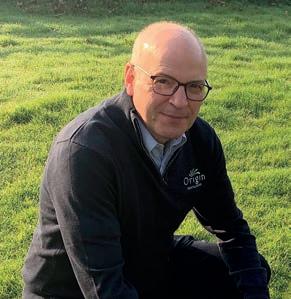




New rules highlight protected urea options
Protected urea may have greater appeal to grassland farmers next season due to the tightening supply on ammonium nitrate (AN) and restrictions on spreading unprotected urea from April 1, 2024 in England.

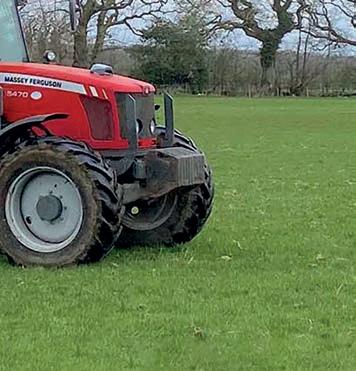
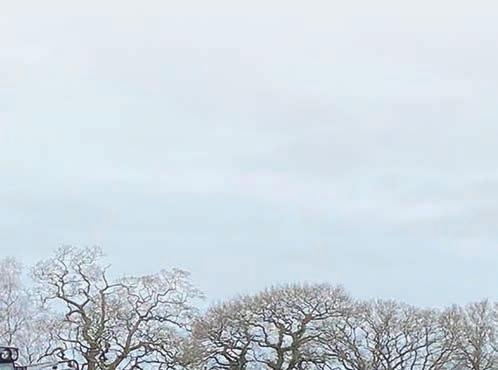
According to the International Fertiliser Association, about 80% of the world’s nitrogen fertiliser consumption is urea, and Peter Sco from Origin Fertilisers says it is possible that a larger percentage of grassland nutrition may come from urea-based nitrogen sources rather than AN next season.

He says: “Some farmers may have concerns about the e cacy of urea compared to nitrates due to potential ammonia losses.

“However, with the addition of urease inhibitors, there is strong data to con rm that protected urea is as e ective as AN, meaning growers have a viable alternative.”
Compliance to the new Defra scheme will be monitored through Red Tractor farm assurance, and is aimed at delivering substantial reductions in ammonia emissions

by recommending that only urea treated with a urease inhibitor can be spread a er April 1, 2024.

Cost-effective
Protected urea o ers farmers a more cost-e ective nitrogen fertiliser alternative to AN, while providing similar yield and crop quality bene ts.
Mr Sco says: “Changing to a protected urea will increase the fertiliser e ciency over unprotected urea, and match the performance of AN, so making be er use of what farmers apply.”
A Defra research project shows that protecting urea with a urease inhibitor can reduce ammonia losses compared to unprotected urea by over 70%.

A common misconception with protected urea is that the whole conversion process is slowed, but Mr Sco explains that this is not the case.
“A urease inhibitor temporarily inhibits the activity of the urease enzyme which reduces the risk of ammonia volatilisation losses. is allows more of the nitrogen to be available to the plant for an extended period. e conversion
process begins as soon as it reacts with the soil, which means the plant can instantly access the nutrient,” he says.
Independent yield trials of one protected urea fertiliser – Origin Enhanced Nitrogen (OEN) –show a reduction in ammonia loss through volatilisation by 86% when compared to straight urea, while it reduces nitrate losses by up to 45% compared to nitrates.
Further data suggests that nitrogen use e ciency of protected urea is comparable to nitrates, meaning farmers will have a performance equivalent alternative fertiliser to AN, with lower greenhouse gas emissions associated with production. Mr Sco details some of the trial work:
“Nutrisphere is the unique carboxylic carbohydrate inhibitor used in OEN, which has been proven in over 41 UK and Ireland trials to o er performance equal to or better than nitrates. is should o er farmers the con dence to switch to a protected urea while not impacting current yield and quality metrics.

“Nutrisphere is not the only urease inhibitor on the market, but it is worth understanding that not




every inhibitor is the same when it comes to blending with other nutrients.
“Inhibitors containing phosphoric triamide, such as NBPT, NBPT/NPPT and 2-NPT, are rapidly degraded within a few days of blending with phosphates, making their inclusion within NPKs unfeasible. A carbohydrate-based inhibitor, such as Nutrisphere, has no detrimental impact on the e cacy of the phosphate over a 12-month storage period.
“ is is key for farmers looking for a cost-e ective, protected urea NPK fertiliser for next season to improve soil indices and maintain yield and quality. It has also been proven to have no deterioration with sulphur over the same 12-month period.”
Environment
Alongside the reduced ammonia emissions, using a carbohydrate-based inhibitor has been proven to o er further environmental bene ts, including positive improvements to soil bacteria compared with standard urea. Studies on earthworms and freshwater sh have shown no long-term e ects, even at 10 times the agronomic rate for the product.
40 GRASSLAND MAY 2023
Peter Scott
Philip Cosgrave of Yara says: “Slurry should be applied soon after harvesting and ahead of fertiliser. A minimum of a week should be left between applications to minimise nitrous oxide emissions.

“If no slurry is available, fertiliser should be spread immediately. Where nutrient applications are delayed a week, there will be a yield penalty of 5%.”
Slurry should be applied using low emission spreading equipment, such as a trailing shoe or hose, Mr Cosgrave says.
He says: “This keeps slurry contamination on grass to a minimum, but exercise caution with these methods if the cutting interval is tight or slurry is thick.
“Applying slurry in a different direction to previous applications prevents slurry residues building up at the base of the sward. When applying nitrogen fertiliser, always choose a product which contains sulphur because of the benefits it brings to yield and grass quality.
“A product such as YaraMila NK Sulphur is ideally suited to making up potash shortfalls.”


Trade-off
Whether making multi-cut or conventional silage, Volac’s Peter Smith urges farmers to cut early in response to grass growth and weather, rather than the calendar date.


He says: “Cutting before heading is critical. Once grass has gone to head, for every day cutting is delayed, quality falls by 0.5 D units, which is equivalent to 1.5 litres of milk per cow per day, if cutting is delayed by one week.”
Achieving the optimum dry matter

Sponsored by

Attention to detail and timeliness are everything when making the best silage, especially with applications of slurry and fertiliser.
Timely application of slurry using a precision application method minimises the risk of spoilage.

Attention to detail pays when making silage

(DM) while keeping wilting times short is a fine balance, he says.
“After mowing, grass continues respiring and can burn up around onefifth of its sugar in the first 24 hours.
“Wilting to 28-32% DM reduces effluent risk and remaining sugars will be concentrated to aid fermentation.
“Once harvested, ensiling promptly and rolling effectively to remove air will allow fermentation to start sooner, ensuring more sugars are retained.
“Using an additive, such as Ecosyl 100, is proven to save sugars leading to improved intakes and animal performance.”
Consistency
Correct setup of the mower, tedder and rake is essential to avoid inconsistency in chop length, insufficient conditioning and contamination.
This is according to Paul Niell, of Krone, who advises farmers to aim for a stubble length of 10cm.
He says: “Whether making silage in a conventional or multi-cut system, you are looking for a rapid wilt. A wide box-shaped swath is desirable to aid
picking up and to allow fast, even drying of the grass. Set the conditioning plates at the most aggressive setting for young, leafy grass on a multi-cut system.
“Ted out the grass as soon as possible, as if it sits in the swath, the top layer will start to dry out, leading to inconsistent DM values in the silage.
“When first tedding the cut grass, set the tedder at the steepest pitch. If tedding the crop a second time, the angle could be flattened.”

Farmers should decide on the most suitable chop length following a discussion with their nutritionist, Mr Neill suggests, but achieving a consistent length is vital.
He says: “The blades on the harvesting equipment must be sharp and properly prepared ahead of cutting to ensure a uniform length to allow consolidation in the clamp.”
Clover
White and red clover will fix up to 180kg of nitrogen per hectare per year (72kg N/acre/year), saving on fertiliser costs, John Spence of Limagrain UK says.
“Drilling or broadcasting clover seed
into a grass ley is an effective way of introducing it into a sward, but ensure the clover is not out-competed by grass.
“Sow clover in May or June when the soil temperature is above 10degC. Drilling or broadcasting seed after first cut silage can work well, but harrow first to expose as much soil as possible to maximise seed to soil contact.
“Red or large leaved white clovers yield more in silage leys but are less persistent than smaller leaved varieties, typically lasting three years.
“Sinclair McGill mixtures include a blend of clover varieties which give consistent yields throughout the season.

“Clover seed is exceptionally small and difficult to broadcast or drill, so a pelleted clover product, such as Clover Plus, helps because it is twice the weight of untreated seed.
“It is also coated with a nutrient treatment, Headstart Gold, which protects the seed until there is enough moisture for germination.”
41 SPONSORED CONTENT MAY 2023
Silage
bettersilage,
Find out more about Campaign for Better
at FGinsight.com/
or scan the QR code
PICTURE : Alistair Hodgkinson
Monitoring soil carbon content is improving grassland management and driving down the carbon footprint of each litre of milk produced at Grosvenor Farms. Dairy Farmer reports.
‘Soil carbon monitoring is here to stay at Grosvenor’


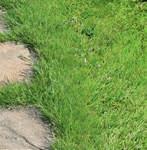








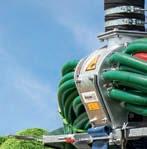











Soil carbon content is rapidly becoming one of the most important management key performance indicators used on Grosvenor Farms’ dairy and arable mixed farming operation in Cheshire, says farm manager Charlie Steer.

With milk yields averaging 12,500kg per cow per year for the 2,600 milking cows, Grosvenor achieves the highest levels of production, but increasingly sees itself as a model of ‘circular’ farming, he says.
“Soil carbon content is an




















essential indicator of a farming business’ overall viability and production potential, but there are wider implications of developing management practices which build soil carbon content too.
Benefits
“At farm level, for example, improved soil carbon content is linked to a multitude of bene ts, such as be er soil structure, improved key nutrient use, be er nitrogen utilisation e ciency, improved moisture retention and healthier soil biology.


“ e real carbon journey
EVEN FOR TINY SPACES
started in 2014 for us when we built a new dairy unit. Without changing anything on the feed
side we saw a 15% improvement in yield and a 20% reduction in costs.
UniSpread: the ultra-agile and superefficient spreader by Vogelsang


Compact and versatile: choose our UniSpread and use it as a dribble bar or trailing shoe. Benefit from easy installation and retrofi tting, small linkage with low overall weight, durable UV-resistant hose material, a high precision distributor and a chassis mounted system. Spread the news – UniSpread is the top choice for best results!




Get in touch now: sales.uk@vogelsang.info




01270 216 600
VOGELSANG –LEADING IN TECHNOLOGY






vogelsang.info

GRASSLAND
We had increased our business performance and reduced our carbon footprint by 36% CHARLIE STEER
“Working with the Scotland Rural College’s [SRUC’s] AgreCalc service, we also learned that the improvements led to the carbon footprint associated with each litre of milk produced falling from 1.12kg to 0.77kg

of CO2 equivalent per kilo of fat and protein corrected milk.
“So with one move we had increased our business performance and reduced our carbon footprint by 36% and this was the start of realising improve-
Issues for es f




ments in sustainability and production can go hand in hand.”
Variety choice
Mr Steer says this was then followed up through a project with SRUC looking at how the






Farms average 12,500kg per cow per year for the 2,600 milking cows.


at





farm could increase grass quality energy and digestibility through variety choice and management. He says: “We started pu ing a fair bit of red clover into leys and this cut inorganic nitrogen applications, increased protein
Feed Processing Specialists


Tub Grinders
- Exclusive UK Distributor of Haybuster & Rotogrind Grinders.

- Range of models from 5t - 25t / hour output.
- New, used & refurbished machines available.
- Ideal for straw, hay, green waste, roots, biogas feeds etc








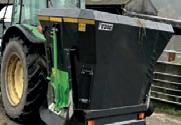
Root Choppers & Cleaners
- Loader, 3 point linkage, free standing PTO and electric drive available
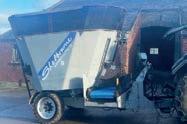

- UK Distributor of VDW range of choppers, cleaners & feed dispensing equipment



- Output from 10t/hour to over 120t/hour available
Diet Feeders
- Largest stock of mixers in the UK - over 50 ma chines in current stock
- Refurbished, used & nearly new units available
- New Mini Mixer available
- Diet feeder parts available- Blades, Conveyor belts, gearboxes, weigh cells.

- All feeders undergo 30 point service


- Finance available subject to terms











- Na onwide delivery available
Current Used Stock:
- Trioliet 20 x 2













- Strautmann 10, 20m




- Bvl 10, 12, 15, 20m
- Kuhn 12, 14, 27
- Siloking 14 x 2, 14 duo, 18m
- Shelbourne Reynolds 13, 19
- Hi Spec 12, 16, 20



- JF 18, 22m
- Redrock 14,16












- Rotogrind 760 x 4
- Farmhand Tub grinder

- Enegis Mul chop 4
- VdW 2.4m root chopper bucket
- VdW 2.4m mixing bucket


Used Diet Feeders always wanted
- VdW Duo Compact loader straw blower on pin & cone
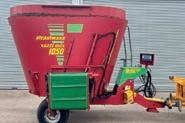

- Profi root Chopper x 2
Please visit www.enegis.co.uk for more photos or call 01789 205132 or 07721 442979

43 MAY 2023
Terms and conditions apply O�er available to new subscribers only Receive the magazine weekly direct to your door via Royal Mail Website access 24/7 plus read on the go with our FG app FREE Arable Farming and Dairy Farmer digital magazines FG Rewards PLUS more! Why subscribe? Scheme SUBSCRIBE
AND SAVE SUBSCRIBE AND SAVE
Milk yields
Grosvenor
content of the forage and gave us greater resilience in drier conditions.
“At this time we also extended reseeding interval from four years to ve years to reduce soil disturbance and carbon loss.”
e end result, he says, was improved yields of be er quality grass, together with improvements in soil structure and organic content, plus another reduction in carbon footprint per litre of milk produced.
Grosvenor’s latest soil carbon analysis has been carried out through NRM’s CarbonCheck service, with NRM agronomy manager Allison Grundy saying the results are highlighting where the farm can continue to make progress.
She says: “Soil carbon content is a very good starting point in itself, but there are many associated areas which give additional insight into what is really happening in the soil.
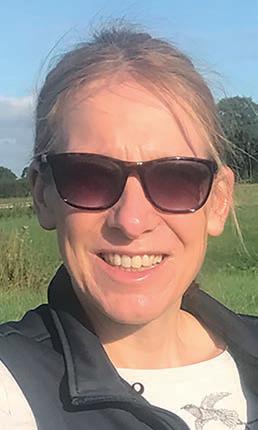
“Measuring a range of parameters associated with soil carbon content is a very e ective way to monitor soil health and production potential.
“ e approach also measures organic and active carbon, as well as total carbon, inorganic carbon, carbonate classi cation and bulk density.”
is not only gives details on traditional information, such as organic ma er, but combines information from a number of di erent carbon measurements, total nitrogen and the carbon to nitrogen ratio, she says.
“Carbon to nitrogen ratio is

an increasingly important area to look at with regard to crop nutrition, particularly when aiming to get the most out of every kg of nitrogen from environmental, crop production and cost perspectives.
“ e proportion of organic carbon relative to nitrogen gives an indication of the right balance for soil microbes to aid the release of nutrients with the optimum ratio for nitrogen release being between 10 and 12.
“ is is a great example of how managing and improving the carbon content of soils can have a signi cant e ect on cost-e ective use of inputs and overall productivity.”
For Mr Steer, the devil is in the
detail: “One of the elds showed a higher level of its carbon coming from inorganic calcareous carbonate, rather than organic carbon, compared to the others, which probably points to the fact that it did have lime on it in the last three years.
“In hindsight, this was probably not graded ne enough and the test could be picking up on that so it is something to be remembered for the future.
“On the grass elds, the move to ve-year leys over four was designed to reduce the amount of cultivations, but despite our best e orts, the silage elds do get a lot of tra c.

“It could be that the bene ts of the longer periods in between reseeds could be outweighed by the negative impacts of greater soil compaction on soil biology, so again that is something we will need to keep in mind for the future.
“ ere could actually be more overall carbon building going in in shorter leys than in the longer ones.
Numbers
“ e point is though, if we do not know the numbers we cannot make the right decisions we need to in order to keep soil carbon moving in the direction we want it to.
“It is all about trying to take assumptions out of the equation so you are basing your management
on facts. is is why we spend so much time carrying out NRM analyses of our slurry, the carbon content of feeds and now soil carbon and associated metrics.”
Farm data
Mr Steer adds that with no two farms or seasons being the same, it is vital to work with as much of your own farm data as possible, rather than relying on generalised information.
He says: “If you put this farm into the models, they just would not take account of the grass leys in the arable rotation, the amount of bulky manure we use and the amount of nitrogen we are o se ing.
“Our aim is to use as much of the farmyard manure and slurries from the dairy unit on the arable unit and grassland as possible to lock in key nutrients on-farm.
“We can then grow the best quality forage and feed we can for the cows and focus on the increasingly important carbon footprints at every stage of the journey.
“Furthermore, di erent practices have a massive in uence on the carbon equilibrium year on year and only by keeping on top of the numbers can we hope to manage and improve this. Soil carbon monitoring is de nitely here to stay at Grosvenor.”
GRASSLAND 44 MAY 2023
There are many associated areas which give additional insight into what is really happening in the soil
ALLISON GRUNDY
The silage fields do get a lot of traffic, says Charlie Steer.



























ARE YOU A BUSINESS THAT HAS BEEN OPERATING FOR UNDER 2 YEARS? 2023 The dedicated Start-Up Zone at Future Farming Expo is ideal for enterprises that have been in operation for less than two years. The zone allows smaller businesses to participate in events alongside larger corporations and other like-minded businesses. WHY FUTURE FARMING EXPO SHOULD BE ON YOUR 2023 CALENDAR: 3 Exposure to thousands of farmers, advisors, and rural business owners 3 Promote your product or expertise to an engaged audience 3 Generate crucial leads for your business 3 Promotion across huge brands, such as Farmers Guardian 3 Pre-and post-show marketing across web and social media Brought to you by: Contact Joanna Wignall on Joanna.wignall@agriconnect.com or 07881 386 250 to discuss your stand or sponsorship options. 10 th - 11 th October 2023 www.futurefarmingexpo.com
Grazed grass remains the cheapest option for dairy farmers, and it is a good source of protein, which is a big advantage at present given current commodity prices. Nevertheless, Promar consultant, Geraint May, stresses it is also the most inconsistent.

He says: “ roughout the grazing season, grass quality and quantity will vary considerably, largely as a consequence of the weather and growth stage. is will impact on both dry ma er [DM] intakes and potential milk from forage. Even with exemplary grazing management and control of the grazing wedge, there will be times when bu er feeding should be considered.”
High-yielders
He says bu er feeding is particularly important with high-yielding cows, and for maintaining body condition and fertility. Higher yielders will struggle to maintain production, particularly if grass dry ma ers are low, as they will struggle to physically eat enough. A cow required to eat 21-25kg DM will not manage this on wet pastures.
“If grass growth declines but other forage stocks are tight, it might be that bu er feeding is not the best option, particularly as current milk prices are falling. It might be worth accepting a reduced milk volume and reducing grazing
Buffer feeding has increasingly become a feature of most grazing seasons, but how do you ensure its success? Dairy Farmer reports.
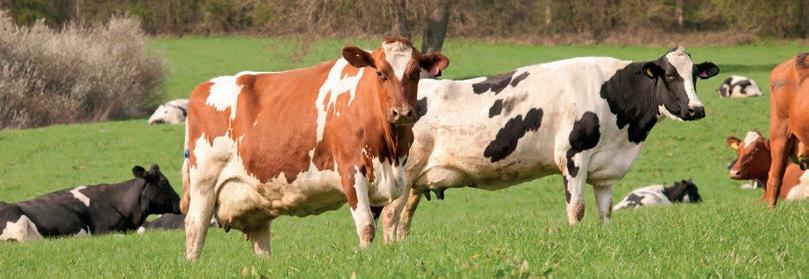
Do not rush into buffer feeding
demand by culling cows earlier, especially if prices remain strong.”
e key to cost-e ective bu er feeding is to understand what is happening to grass by regularly assessing covers and testing grazing quality.
Early season
“In early season, the main concern is about keeping on top of early-season growth and, in many cases, cows will be able to consume at least 14kg DM from grazing and may require no bu er at all.
“If grass is adequate, then bu er may actually replace grazing in the ration as cows eat too much bu er and underutilise grass. However, if growth is impacted by the weather, then bu er can play a crucial role in helping to maintain intakes and production.”
Mr May emphasises the importance of regularly assessing covers and the grazing wedge as a way of evaluating the need for bu er feeding, and the amount that might be required.
He says grass residuals falling below 1,500kg DM/hectare are a sign that more bu er is required. Equally, residuals of over 1,700kg DM/ha indicate that cows are
being o ered too much bu er and are poorly utilising immediate grass intakes, which may compromise grazing quality and grazing management in the longer term.
“By monitoring both grazing quality and quantity, you will be much be er placed to determine how much bu er needs to be fed, optimise grazing intakes and control the amount of bu er on o er in order to reduce waste and control costs.”
Formulation of the bu er is also crucial to derive maximum bene t. Early-season grass will be high in rumen-fermentable energy and low in neutral detergent bre, so including highly digestible bre ingredients in the bu er will help rumen function and promote bu erfats, which will be important in many contracts.
He says that wholecrop can be a good ingredient in early-season bu ers as it is low in protein and can complement the protein in grass. However, as the season progresses, grass protein can decline, meaning the bu er needs more protein to balance the total diet.
Moist feeds
“Moist feeds can work well in buffers depending on availability, and if silage stocks are low, straw and a molasses blend can be used to replace some of the silage in the bu er.
“ e key is to appreciate that the bu er formulation and quantity offered need to be regularly reviewed to ensure grazing intakes are optimised, but that cows are not le short. If intakes in fresh calved cows are compromised, they will not peak as well, which will prove more costly than bu er feeding.
“It is also important to consider how the bu er is o ered. To maximise intakes, mix it as close to feeding as possible to keep it fresh and avoid heating. Also consider feeding it before a ernoon milking so cows will go back out to grass feeling hungry. Avoid feeding buffer in the morning as cows are more active grazers in daylight hours.”
46 GRASSLAND MAY 2023
If grass growth declines but other forage stocks are tight, buffer feeding might not be the best option.
Geraint May
GERAINT
By monitoring both grazing quality and quantity, you will be much better placed to determine how much buffer needs to be fed
MAY

TRANSFORM HOW YOU FEED YOUR HERD With Feedlync’s weigh system & feeding app you can: > Quickly & easily analyse your feed accuracy > Instantly save money by reducing feed waste > Access your data instantly from your mobile anywhere, anytime > Integrate with your processor, herd management, nutritionist and more! Speak to our friendly team today to find out more! Call +44 20 3966 90 63 or visit www.feedlync.com
UK farmers are taking part in a new collaborative project run by grass breeding company DLF. Sara Gregson reports.
Show and tell for grass and forages
APartner Farm programme, of demonstrations and trials on dairy farms from as far north as Dumfries and as
far south as Somerset, has been established by DLF.
Monty White, DLF agricultural project manager, says the on-farm trials have been set up to create local hubs for farmers
In the field Barry Jones Shropshire
Farming at Tilley Park Farm, near Wem, Shropshire, he milks 230 dairy cows on 240 hectares (593 acres) on heavy clay land.
The Holstein cows calve from October to June and produce on average 8,500 litres a year with 4,000 litres coming from forage.
They are milked twice a day and in winter are fed a total mixed ration (TMR) consisting of red clover and oat wholecrop silages, with home-milled and mixed oats and a 35% protein blend.
A 16% protein organic concentrate is fed in the parlour.
The first trial Mr Jones is going to be involved with will compare four different organic fodder beet varieties.
He says: “We grew fodder beet for the first-time last year. We were looking for a different
kind of feed for the TMR and were hearing good things from other farmers about it.
“We have taken on some lighter land, which could take a harvester into November, and we tried 3ha.
“We were very pleased with how it turned out, yielding about 54 tonnes/ha. It may have been that we picked a very good year, when the weeds all died in the
to talk about all things grass and forage.
He says: “ ere will be di erent levels of activity. At one end there will be trials measured and recorded regularly which will relate
drought. We harrowed the field a couple of times and a student rogued the docks.
“The fodder beet was harvested and stored in a clamp in the yard made of concrete and straw bales. It was chopped and fed out in the diet feeder and the cows loved it.”
Varieties
Mr Jones is going to double the acreage this year, including four small 0.2ha (0.5-acre) trials plots sown with different varieties, including Delicante.
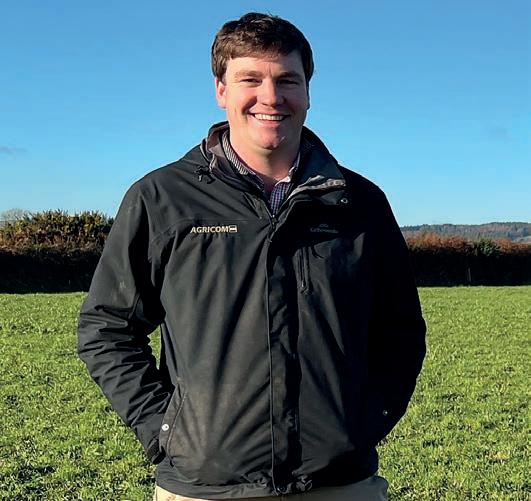
This is a new white-skinned variety with high fresh and dry matter yields of greater than 21t/ha (8t DM/acre) and clean roots and healthy foliage, with good resistance to rust and mildew.
This will be grown alongside the varieties Enermax, Bangor and Magnum. All the varieties will be untreated.
to work also being undertaken at the DLF breeding grounds in Didbrook, Gloucestershire, to demo plots which may just compare how di erent varieties perform on one farm in one eld.”
“This will give us a good idea of how they compare growing them organically and will provide us with useful information.”
In summer, Mr Jones will also undertake a reseeding demonstration, splitting one field into five strips and sowing it with perennial ryegrass and clover as standard and including others with red clover, plantains and a full-blown multi-species sward.
The cows will graze across all the plots and measurements will be taken before and after to gauge how much has been eaten of each one.
“We have relied on a lot of red and white clover in our mixtures over the years, but herbal leys have not really been on our radar,” says Mr Jones.
“We do not know how they will perform on our heavy land and are glad to take the opportunity to see what happens in the trial.”

48 GRASSLAND MAY 2023
JOrganic producer Barry Jones is one of the first Partner Farmers in the UK.
Monty White, DLF agricultural project manager.
Barry Jones
In the field Peter Done, Cheshire
JPeter Done farms at Larkton House at Malpas in Cheshire, running 180 Friesian cows and 100 head of youngstock on 106 hectares (260 acres).


The cows calve all year round and yield on average 6,500 litres of milk, with 4,100 litres coming from forage.
The all-grass farm is on light sandy soil, which dries out in hot weather. Last summer, Mr Done buffer-fed from silage, spreading it out on the grazing ground to see the cows through the driest times.
As a Partner Farmer, Mr Done will be trialling five different hybrid brassica catch crops drilled in six metre strips across one field in April.

The crops will grow and be grazed by the end of July. The varieties will include Spitfire, Interval and Winfred and a new variety called Mainstar.
“I have never grown brassicas before, but I like the idea of using them as a break between grass crops as this will help avoid leatherjacket damage,” says Mr Done.
“We have been reseeding























grass to grass since the chlorpyrifos ban and getting away with it by the skin of our teeth. But we lost two fields of forage rye this winter, so the time has come to try something different.
“The additional forage may also be useful to feed the cows should the summer come dry again.”




In the summer, Mr Done will also be hosting the same reseeding trial that Mr Jones is putting in — to find out how different seeds mixtures work on his land.
Plantain




“Until last year I had always grown perennial ryegrass and white clover, but I did a bit of a trial, adding 5% plantain to the mixture. Plenty of it grew and the cows are eating it. But I am not sure what all the benefits are yet.
“It will be good to have plantain in the DLF trial to see how it compares with the other mixtures. Being a Partner Farmer may provide me with some of the answers.”
49 GRASSLAND MAY 2023 50 years of trusted leys Or contact your nearest stockist for more information Turbo charge your grazing TURBO® MEDIUM TERM GRAZING For your free Grass & Forage Crops Handbook, call 01472 370117 or email: enquiries@ limagrain.co.uk
over the page...
Continues
Five different hybrid brassicas will be trialled by Mr Done on his Cheshire farm.
In the field Dr Thomas Moloney, Ireland
JFor the past six years, seven Partner Farms have been running in Ireland.



Led since 2020 by Dr Thomas Moloney, who has previously worked with Ireland’s government advisory service Teagasc, the programme focuses solely on dairy farms in the south and east of the country. Each farm hosts a number of in-field trials featuring varieties and mixtures of current interest.

Programme

“Partner Farmers feel like they are part of a global research programme,” says Dr Moloney. “Sometimes they may be growing varieties before they are commercially available.
“There are a couple of concepts that have really taken off and partner farms




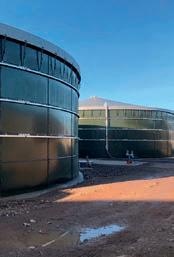
have played a part in getting the message out and accepted by the wider farming community.
“The first is the use of DLF’s next generation tetraploid varieties, such as Nashota, which have the yield and quality of a tetraploid but the density and slender leaf of a diploid.





“We started trialling these in














Slurry Stores & Covers






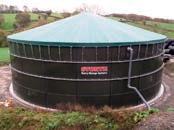
grazing mixtures on three Partner Farms six years ago. Now many more Irish dairy farmers are growing higher proportions, or even all tetraploids in their mixtures.
“The other concept is multispecies swards. Some of the Partner Farmers, which are very comfortable growing and grazing perennial ryegrass and
clover, were sceptical that drilling diverse mixtures would work.
“But they have done better than the farmers ever thought, particularly in last year’s summer drought. This success has sparked the interest of other farmers who have visited and seen with their own eyes how well they are performing.”
50 GRASSLAND MAY 2023 Tel: 01524 781900 www.storthmachinery.co.uk sales@storthmachinery.co.uk
781
Monty White (left) and Dr Thomas Moloney at the grass breeding and trials ground in Ireland.
This animal health special looks at issues around water quality, youngstock health and on-farm bacteriology and features a farm at the top of its game for animal health.
Cutting antibiotic use and improving growth rates
By Katie Jones
Achange in the calving pa ern for Dan Miller’s herd has meant it is even more important than ever to achieve good heifer growth rates and improvements to youngstock health have been key to this.
By working hard to maximise passive immunity and, at the same time, ensuring acquired immunity is boosted, Mr Miller and his team at Cribhouse Farm, Stalbridge, Dorset, have made huge strides in improving calf health.

While levels of calf pneumonia were certainly not at a critical level,

there was a real desire to make improvements to calf health in order to reduce antibiotic use in youngstock and also to make sure calves were achieving good growth rates so heifers were well developed when calving into the herd at two years old.
is was particularly important in 2021, as the herd moved from all-year-round calving to autumn calving, a change driven by a desire to make the most of the 36-hectare (90-acre) grazing block.
Mr Miller says the calving period for the 170-cow herd is not intended to be tight with calving taking place over four to ve months so milk is produced all year round.
Mr Miller says: “While the calving
Farm facts
r170 cows giving an average yield of 9,320 litres at 4.5% butterfat and 3.5% protein
rHeifers served at 14-15 months to sexed semen
r50 replacement heifers a year are kept
block is relatively long, we do want to the heifers to calve at the beginning of July and August.”
In the past, heifers calved into the herd at an average age of 28 months, which Mr Miller says suited the previous system and meant any surplus stock sold well as ‘strong’ in-calf heifers.
rMost milk, about 75%, is sold to Barber’s for cheesemaking, with the remainder used in products produced on-farm and marketed under the Dorset Dairy Co brand
He says: “Now we are aiming to calve them slightly earlier, but we still want them to be strong.”
With the knowledge that pneumonia has an impact on growth rates, meaning heifers could potentially be underweight at service at 14-15 months, which also has an impact on puberty and conception,
51 MAY 2023 ANIMAL HEALTH
54 WATER MATTERS Quality and quantity important considerations 58 ON-FARM TESTING Help with diagnostics and treatment 60 AWARD-WINNERS Focus on animal health leads to sustainability accolade
Left to right: Lucy Hepworth, Louis Sarsfield and Harry Arnold.
ANIMAL HEALTH
a decision was made to focus on disease prevention.
Mr Miller says much of this was driven by herdsman Louis Sarsfield, who worked closely with the farm’s vets, Lucy Hepworth and Helen Rogers, and nutritionist Charlie King to develop and stick to a plan for youngstock health.
The approach can be split into two areas: maximising passive and innate immunity; and boosting acquired immunity.
The first area relies on following protocols for optimising colostrum quality and calf colostrum intake.
Working with the Mr King, the dry cow diet was formulated with colostrum quality in mind.
Cows are given a scour vaccine at drying off, which helps boost colostrum antibodies for rota/coronavirus and E.coli. Mr Miller says scour incidence has greatly reduced and is now at a ‘minimal’ level.
Colostrum quality is tested using a Brix refractometer, with colostrum measuring 22% or more fed to calves. The aim is to give them four litres as quickly as possible after birth.

Total proteins are monitored at the start of the calving block to get an idea of passive transfer levels. At the start of the 2022 calving block, results showed that 80% of calves tested had good levels of antibody absorption.
Mrs Hepworth, of Friars Moor Livestock Health, Dorset, says: “Practice data for our autumn calved herds in 2022 showed farms ranged between 50% and 100% for calves having good levels of antibody absorption.”
She adds that monitoring total proteins at the start of the calving
block is a good idea, as it gives farmers the opportunity to make improvements if results are below target.
Calves are fed transition milk for three days before moving onto milk replacer, with the manufacturer’s guidelines followed for formulation.
Calves are fed four litres of milk twice a day for six weeks. Milk is then gradually stepped down over a three-week period to weaning.
Mrs Hepworth says there is a gap in immunity at about two to four weeks when passive immunity fades and the calf is developing its acquired immune system.
She says: “I always encourage clients to feed high levels of milk powder for the first six weeks to provide the immune system with plenty of energy to help support this period.”
The second area is boosting acquired immunity with vaccination and calf environment plays a vital role in this to minimise challenge.
Mrs Hepworth says: “Last year the heifers were vaccinated with Bovalto Respi 3 at two and five weeks of age and this means there is full vaccine immunity by eight weeks of age.
“The vaccine gives six months of protection, so comfortably lasts the length of the housed period.”
Vet technicians carried out these vaccinations, meaning calves were vaccinated at the correct age with an appropriate gap between doses.
Impact
While the vaccine spend at £1,500 in 2022 was not dissimilar to the cost of treating pneumonia the previous year, this does not take into account the impact good youngstock health has further down the line in terms of longevity and milk yields.
As well as vaccination, the team at Cribhouse also aims to minimise stress and challenges during the rearing period by managing the weaning process and avoiding group changes at stressful times, including weaning and disbudding.
Harry Arnold, who is responsible for feeding the calves, says: “Calves are kept in individual pens to start with, before moving to groups of five, then groups of 10, where they stay until after weaning.

“There are no group or shed changes for at least a month after weaning to keep stress levels to a minimum.”
The management of other diseases, particularly coccidiosis post-weaning, is important.
Mrs Hepworth says: “Coccidiosis

is common in autumn-born calves and we used a therapeutic drench last year to treat this.
“Ahead of the next block, the shed will be disinfected for coccidiosis and alterations to feeding troughs are to be made to reduce coccidiosis challenge.”
The calf environment is also an important part of disease prevention and Mr Miller says the calf shed was designed with sloping floors to keep moisture away from the calves and is also well-ventilated with a fan and duct system.
The positive impact this approach to youngstock health and pneumonia prevention has had is clearly evident.
Mr Miller says that around Christmas 2021 there was an outbreak of pneumonia, which meant all the heifer calves had to be treated with antibiotics.
He says: “Jump forward to autumn/winter 2022/23 and there has been a vast improvement in calf health and calves grew well as a result.”
This improvement is also mirrored in vet and medicine costings, with the cost of drugs used to treat pneumonia, including antibiotics and anti-inflammatories, falling by 94% for the period of July to March, when comparing 2021/22 against 2022/23.
52 MAY 2023
To help cope with the gap in immunity when passive transfer fades, calves are fed high levels of milk powder to provide the immune system with plenty of energy.
Dan Miller
• Increases milk yield by up to 2 litres per day1

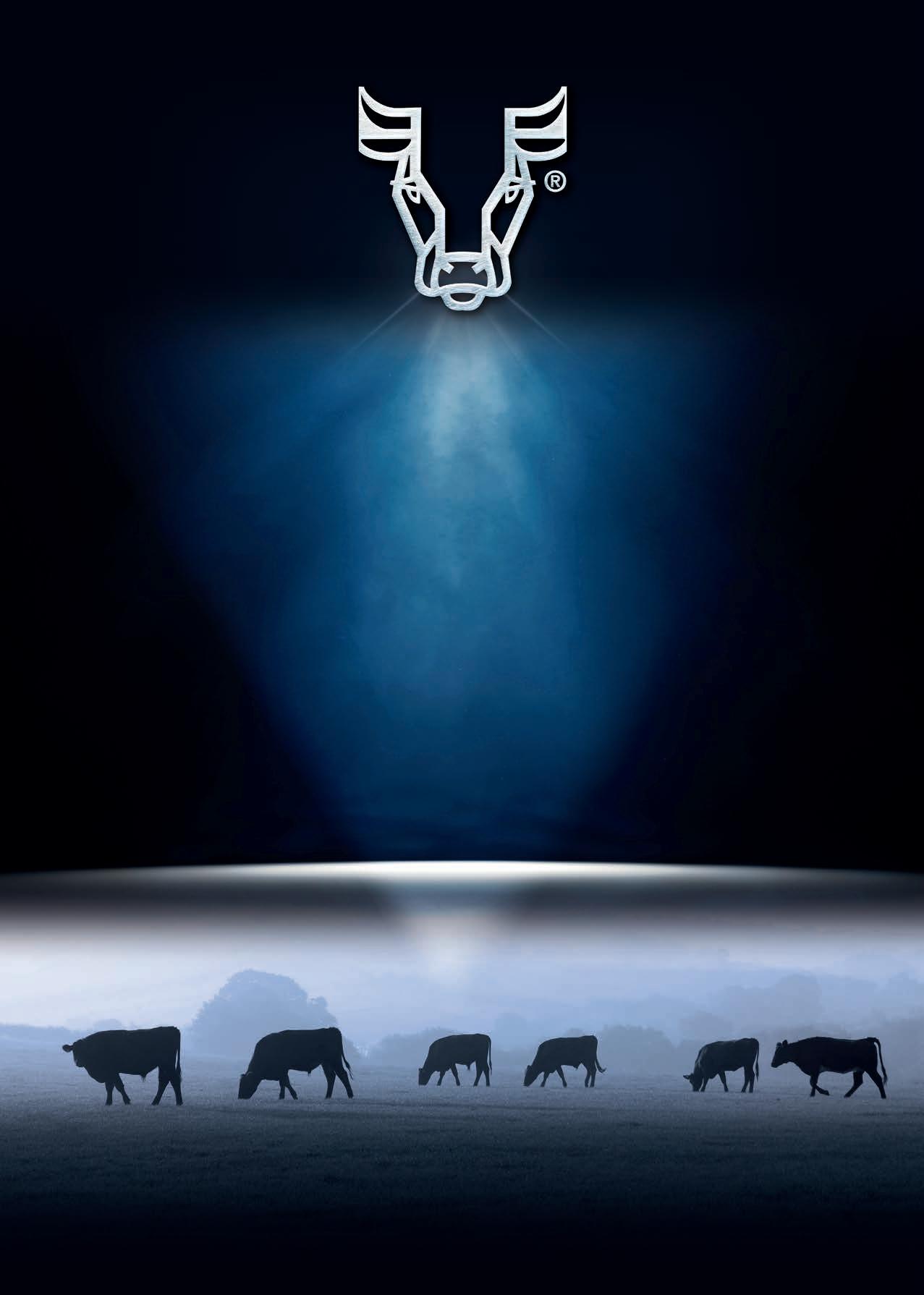
• Protects fertility and reduces calving interval2
• Protects against reinfection by gutworms and lungworm*
parasite control, trusted by farmers for generations.
Proven
Find out more, visit beattheparasites.com
Journal. 49:106-110.
New
* Up to 28 days control
,
up
21 days control of reinfection with
spp. EPRINEX® Pour-On for beef and dairy cattle contains eprinomectin. POM-VPS. Advice should be sought from the prescriber. Further information available in the SPC or from Boehringer Ingelheim Animal Health UK Ltd, RG12 8YS, UK. Tel: 01344 746957. Email: vetenquiries@boehringer-ingelheim.com. EPRINEX® and the Steerhead® logo are registered trademarks of Boehringer Ingelheim Animal Health France SCS, used under licence. ©2023 Boehringer Ingelheim Animal Health UK Ltd. All rights reserved. Date of preparation: Feb 2023. UI-BOV-0025-2023. Use Medicines Responsibly.
1. McPherson WB et al. (2001) New Zealand
Veterinary
2. McPherson WB et al. (1999) Proc AAVP,
Orleans.
of reinfection with O. ostertagi and D. viviparus
and
to
Cooperia
EPRINEX®, a zero milk withhold wormer, is proven to improve the productivity of dairy cows and heifers by removing productionlimiting gutworms and lungworms.
Accounting for 87% of milk’s composition, water is an essential nutrient to the dairy herd. And while it is accepted that cows must always have access to water, is the quantity required and the importance of quality truly understood?

With 85% of UK farms using borehole water, according to Roy Waller, of Clear Water World Technology, dairy farmers are being encouraged to pay greater a ention to water quality and reap the rewards in improved cow performance.


Mr Waller says: “Dairy herds are su ering the results of the poor quality of their water and probably do not even realise.”
Farmers should look at bacteria levels, mineral and acidity of water, says Mr Waller, whose company specialises in natural, non-chemical, organic solutions for improving water quality.
With freedom of thirst at the top of the ve freedoms in livestock
The provision and quality of water is paramount to overall cow health and performance, but these are areas of management which are often overlooked. Katie Fallon reports.
Quality and quantity key with water
husbandry, it is no surprise that water is imperative to overall cow health and performance, says ruminant technical co-ordinator at ForFarmers UK, Dr Bethan Till. However, this is o en forgo en due to water issues not being as obvious as physical ailments when causing yield reductions. While quality is key, ge ing


the basic requirements right is just as in uential.
Dr Till says: “You can have the best quality water out there, but if it is not accessible you are still going to have issues. So that is when the access and quantity of water is just as important as the quality.”
Generally, a trough space of 10cm/cow should be provided,



says Dr Till, with 15% of the herd able to drink from the troughs at any one time.
Trough placement also has an in uence on water intake and farmers should consider where their troughs are placed both in the shed and outside.
54 ANIMAL HEALTH MAY 2023 Are your cows insured this summer? Feeding Equaliser® CoolCow costs just £20 per cow for the 150 day summer period and has been proven to maintain fertility, foot health and yield performance. T (01845) 578125 E customerservices_dalton@cargill.com @CargillAnimalUK
Water should be tested for minerals and coliform and E.coli bacteria.
Dr Till says: “Troughs need to be spread out to ensure dominant cows are not preventing the timid cows, especially heifers, from accessing the troughs, as this will result in a constant reduced milk yield in the timid cow.”
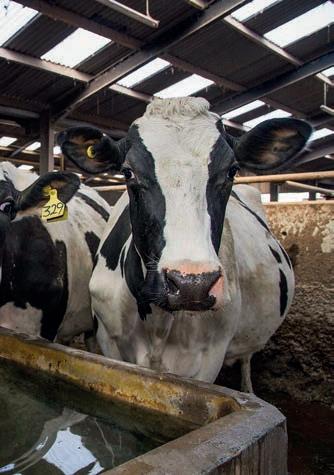
She also advises cows should not
have to walk further than 250 metres to a water trough located in a eld.
Focusing on water volume, Dr Till says a 28-litre cow will drink between 95 and 115 litres of water per day, depending on temperature, humidity, dry ma er content of the feed and competition for water space. And high-yielding cows require an extra 2.7 litres of water for every extra litre of milk.
Cows are also expected to drink twice as much when temperatures exceed 21degC.
Water ow is also important, as poor ow will reduce water intakes, says Dr Till.
She explains that a dairy cow will drink 12-24 litres of water per minute, therefore if the water ow is low the more dominant cows will always be at the trough drinking, making it unavailable to the less con dent cows.
She says: “You want the water troughs to ll back up as quickly as possible, with a target re ll of 20 litres per minute.”
Cleaning
JWhen it comes to water quality trough cleanliness is essential and Dr Till advises farmers to clean troughs at least once per week, if not once a day.
She says a brush around the trough will provide a sufficient clean. However, in the case of an E.coli outbreak, the disinfection of troughs may be required.
Cleaning is even more important in spring and summer to keep bacteria levels down.
Cow behaviour when drinking can be an indicator of water cleanliness and quality, explains Dr Till.
“If a cow drinks from the trough with no fussing then walks off straight away the water is okay. But if they starts splashing the water about with their tongue or walk away and go to another
trough to drink, you know that trough needs to be cleaned.”
Placement of water troughs can also impact water cleanliness, as troughs located nearer to the feed face will be at greater risk of contamination.
TAKE CONTROL OF GRASS SILAGE QUALITY

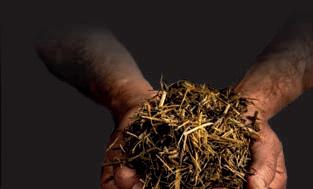

MAGNIVA crop and condition speci c inoculants are formulated for the multiple challenges of grass silage.


MAGNIVA grass inoculants contain a unique combination of proven bacteria and enzymes providing complete exibility on clamp opening times, plus:

% More fibre digestability
Scan to find out more about theMAGNIVArange
ANIMAL HEALTH LALLEMAND ANIMAL NUTRITION SPECIFIC FOR YOUR SUCCESS www.lallemandanimalnutrition.com + 44 (0) 1684 580022
UP TO 13 UP TO % MORE DM 15 UP TO % more protein 4
Continues over the page...
If a cow drinks from the trough with no fussing then walks off straight away the water is okay
DR BETHAN TILL
ANIMAL HEALTH
Testing
JWhen it comes to testing water quality, there are two tests which can be completed including a borehole test and a trough face test, and Dr Till advises carrying out both.
“It is important to also measure the water quality at the trough face, because sometimes you will get differences. The borehole may tell you that the water quality is good, but a trough sample may suggest you need to clean it out if it has been contaminated.”
Dr Till advises farmers to test for water minerals (see table, right) and check their test is measuring all of the minerals below, as some cheaper tests do not. After testing for minerals, Dr Till also advises testing for Coliform and E.coli bacteria.
Water testing should be completed on an annual basis, says Dr Till, and she advises farmers to use the results when formulating diets to prevent over-supplementing cows, save costs and maximise performance.


She adds: “In many cases, the quality and provision of water on-farm may not be optimal to maximise animal performance and health.”
Testing for water minerals
Mineral/pH Target level Reason for test

pH Between six A pH of five or below will cause the water to become too acidic and eight and result in acidosis. Similarly, a pH of eight and above will cause the water to be too alkaline and result in acidosis symptoms, reducing feed intake and therefore milk yields.
Total 1,000mg/litre Up to 3,000mg/litre is considered satisfactory, but any higher dissolved than 1000mg/litre, Dr Till advises testing the water for all major solids minerals, salts and metals.
Sulphate <250mg/litre High levels of sulphate can disturb the absorption of trace elements, such as copper and Vitamin E.

Magnesium <125mg/litre High levels can disturb the absorption of trace elements, while also increasing the hardiness of the water resulting in blocked pipes and poorer water flow.
Calcium <500mg/litre If calcium and magnesium levels are too low or too high they will affect the dietary cation-anion balance (DCAB) of the diet. Levels should be considered when rationing the diet to avoid the cost of over supplementation of minerals, when the cow is already receiving enough through the water. When testing for a low DCAB diet, Dr Till says to test the pH of both the cow’s urine and water at the same time.
Sodium
rKeep water troughs clean
rTest water at least once per year
rWatch out for behavioural changes with water
rMake sure water troughs are spaced out and not located at dead ends in the shed

Not usually an issue, as cows are often supplemented with sodium, but if it is too high it will affect the water palatability.
Iron <0.3mg/litre Often higher in a ground water source. Reduced water intakes if levels exceed 0.3mg/litre.
Manganese <0.05mg/litre Often higher in a ground water source. Reduced water intakes if levels exceed 0.05mg/litre.
Chloride <250mg/litre Affects palatability of water.
Nitrates/ <200mg/litre
If levels are above 200mg/litre it will cause nitrites reproductive problems, such as issues with fertility and abortions. Often happens when there has been a fertiliser run-off into a water source.
Copper <1mg/litre
Source: ForFarmers
Levels greater than 1mg/litre can reduce water intakes due to poor palatability and cause liver damage in extreme cases.
56 MAY 2023
Dr Till’s top tips for achieving optimal water quality
Cow behaviour when drinking can be an indicator of water cleanliness and quality, says Dr Bethan Till (inset).
3 ways to avoid heat stress in your dairy herd

Plan how to tackle heat stress in your herd this summer to avoid milk yield drops and longer term impacts on fertility.

DAIRY COWS
Increased somatic cell count –Decreased immunity







INVEST IN GOOD HOUSING
Ensure you have the best housing possible because cows spend 75% of their time inside.
This matters because the temperature inside a badly designed shed could be 5°C higher than the temperature outside, however the temperature inside a welldesigned shed could be 5°C cooler than outside. Housing areas to focus on:
> Ensure adequate ventilation – there should be fresh air 24/7










> Insulate the roof and provide shade – if you’re designing a new shed, having a white roof can help keep the building cool
> Install sprinklers or vertical fans – these will help keep cows cool
2
EFFECTS OF HEAT STRESS
DAIRY COWS & CALVES
Increased locomotion issues, increased mortality risks & decreased fertility levels
PROVIDE ENOUGH ACCESS TO FRESH WATER
Cows need access to a reliable source of fresh water as they will drink more in the heat. Drinking requirements in hot weather:
> A cow producing 21 litres of milk per day will drink 103 litres of water a day when the temperature is 21°C, and 109 litres when the temperature is 27°C


> A cow producing 45 litres of milk per day needs 128 litres of water a day when the temperature is 21°C, and 135 litres when the temperature is 27°C

discover our heat stress monitor farms
DAIRY CALVES
Lower future milk production
INCLUDE A LIVE YEAST IN RATIONS
Farmers can include a rumenspeci c live yeast, such as Levucell SC, in rations to mitigate the negative e ects of heat stress – impaired rumen function and a reduction in milk yields.




Trials1 have shown feeding Levucell SC at double the standard dose during periods of heat stress can result in a 6% increase in feed e ciency and milk yields.
Lallemand is once again partnering with independent vet consultant Tom Chamberlain to monitor the impact of heat stress on dairy cows on up to 12 farms across the UK, helping progress this important research.

n Scan the QR code for the results of the 2022 project.
help beat heat stress with
for 2023
new
Nico Vreeburg, ruminant technical support manager at Lallemand Animal Nutrition, shares his top tips for avoiding heat stress:
1
ADVERTORIAL LALLEMAND ANIMAL NUTRITION n SPECIFIC FOR YOUR SUCCESS www.lallemandanimalnutrition.com +44 (0) 1684 580022
1 University of Florida, USA (2010), University of Bologna, ITALY, (2013).
3
–Lower daily gain
Bacteriology can play a big role in driving down antibiotic use further and faster. Dairy Farmer reports.
Despite considerable progress being made to reduce the incidence of mastitis and the use of antimicrobials to treat infections, mastitis still represents a drain on dairy businesses. is means there is also the opportunity to reduce infections further to reduce costs and increase e ciency.
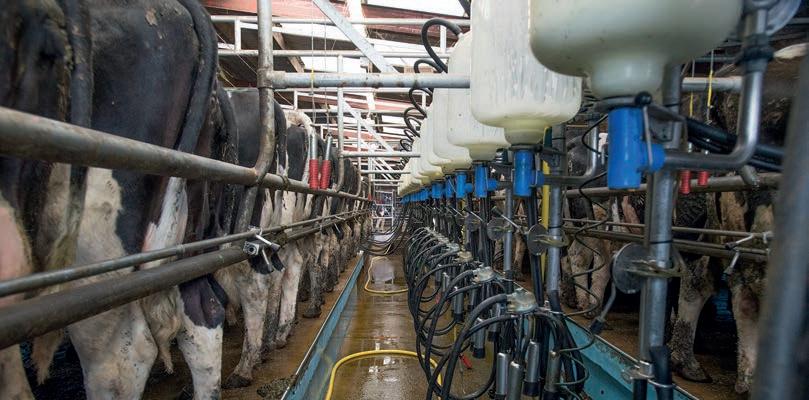
e 2022 Kingshay Dairy
Costing report showed the average incidence of clinical cases at 30 cases per 100 cows, down from 39 in 2019, a reduction of 23%.
e top 25% of farms recorded 16 cases per 100 cows.
“ is is signi cant progress that farmers can be rightly proud of,” says dairy vet Ma hew Dobbs, chief executive of Agsenze, the UK distributors of the Mastatest system.
“Cases had been stubbornly holding at about 40 per 100 cows for many years, so things are moving in the right direction.
“However, it is important to keep striving to reduce cases further as clinical mastitis is still costing the average farm more than £10,000 per year and accounts for 9% of all culls.”
Kingshay also reports a significant reduction in the use of antibiotics on dairy farms, particularly the antibiotics critically important to human health. However, in the past two years, the rate of the decline has plateaued.
Mr Dobbs says: “If further progress is going to be made in both reducing the incidence and cost of clinical mastitis and further

New technologies which increase the precision of diagnosis and treatment will play an important role in reducing the incidence of mastitis and the need to use antibiotics to treat it.
Use on-farm data to reduce antibiotics
cu ing the use of antibiotics on-farm, then new technologies which increase the precision of diagnosis and treatment will play an increasingly important role.
“ e objectives should be to reduce the cases of mastitis while also reducing the number of cases which are treated with antibiotics, which is where on-farm bacteriology will help be er decisions to be made.”
ere is no universally e ective intra-mammary antibiotic, with the e ectiveness depending on the class of bacteria causing the infection. Bacteria can be classi ed into gram-negative and gram-positive strains, which respond di erently to antibiotic treatments.
Mr Dobbs says up to 50% of mastitis on UK dairy farms is either caused by gram-negative bacteria, such as E. coli, or does not have an identi ed bacterial cause.
Treating these mastitis cases with antibiotics may be unnecessary as they typically resolve without any intervention, yet in many cases antibiotics are used as routine for no benefit.
Cure rates
For cows with a gram-positive mastitis infection, such as Strep. uberis or Staph. aureus, knowing the antibiotic the particular strain is most sensitive to will improve cure rates as the farm’s vet can make a be er-informed decision about the most e ective antibiotic to use.
Mr Dobbs says: “If bacteriology is not carried out, it is di cult to re ne treatment protocols. Where bacteriology has been used in the past, it has been a time-consuming process, requiring samples to be sent away for testing, with results o en back on-farm too late.
“ e simple Mastatest on-farm system overcomes these drawbacks, allowing a sample to be tested with data back on-farm and simultaneously sent to the vet in less than
24 hours for prompt and accurate treatment decisions.”
e test automatically processes milk samples using a simple cartridge system and an electronic eye which takes images of the samples as time passes.
e images are sent to the Cloud, where they are analysed and interpreted, with results in the farmer and vet’s inbox within 24 hours.
e results include the bacterial species present or con rmation of no bacteria being present and its sensitivity to common antibiotics. ese data are used to generate and report a recommended treatment plan, based on a protocol devised by the farm’s vet.
Mr Dobbs says: “Farmers and vets have timely data available to determine if antibiotics should be used and from the sensitivity pro le, which antibiotic will be most e ective.
“ is will allow more robust treatments and help drive down unnecessary use of antibiotics, reducing the amount of milk withheld and discarded.”
e system can also be used to make be er decisions about selective dry cow therapy.

58 ANIMAL HEALTH MAY 2023
Farmers and vets have timely data available to determine if antibiotics should be used
MATTHEW DOBBS

ANIMAL HEALTH
Making animal health the top priority is paying off for a family dairy farm. Chloe Palmer reports.
Taking a proactive approach to herd health
Fertility, calf health and cow welfare have been the focus of e orts to improve animal health at Spring eld Farm, near Belper, Derbyshire.
e Oulton family’s hard work was acknowledged when they were named runner-up in the VetPartners Sustainable Farm of the Year Award.
Working closely with their vets, the Oulton family have made important changes to protocols, resulting in signi cant improvements to these performance indicators.
Michael Oulton, who farms with his wife Jo and son Barney, says: “We have become more proactive in our approach to herd health so that we tackle any problems at the earliest opportunity.
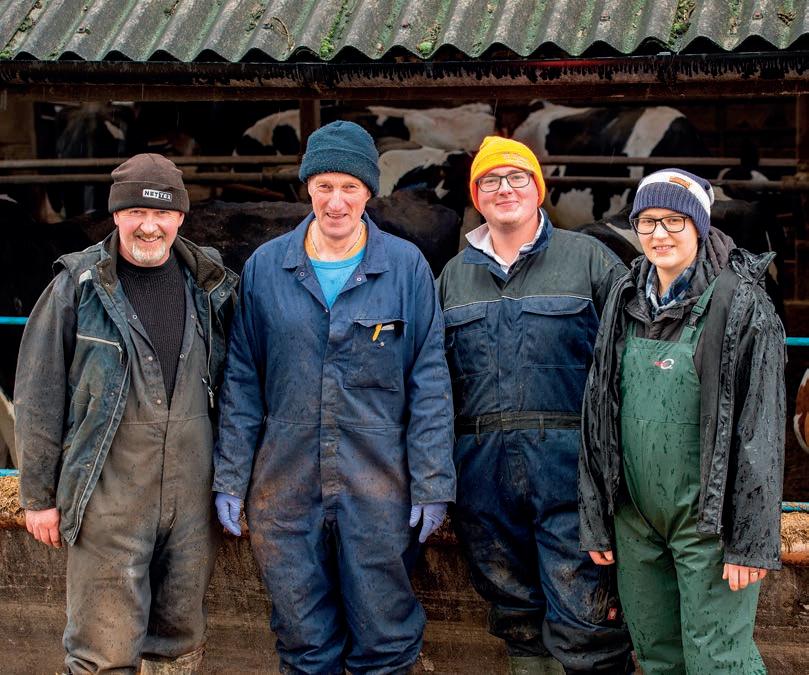
“We have a weekly visit from LLM Vets who look at any issues with individual animals but we also look carefully at the cows’ environment.
“We do not have state of the art buildings here; the roofs are lower than we would like which a ects ventilation and means heat stress can be an issue in the warmer
summers we are now experiencing. e youngstock are currently housed in our oldest buildings, which is not ideal, so we have to work hard to ensure welfare is not compromised.”
Calf rearing is the responsibility of Stephen Oakes, who has been at the farm for more than 35 years.
Ensuring the calves all receive the necessary amount and quality of fresh colostrum in the rst few hours of their lives has been one of the main factors resulting in all the calves recording 100% passive immunity levels.
Mobility
Improving the mobility of cows when working with old sheds
and infrastructure is not easy, but careful investments and taking a pre-emptive approach to potential lameness issues has been highly bene cial.
Michael says: “We have ed rubber to the slats and we have bought a robotic scraper. Letizia, our herdsperson, is a very capable foot trimmer and we watch all the cows carefully as they walk to and from the parlour so we can identify any which might be showing the early stages of lameness.
“By keeping on top of foot trimming, we are seeing far fewer mobility problems.”
Increasing the longevity of cows on the farm is another important target and, although at four
lactations the farm is well above the national average, Michael would like to see this gure raised further.
He says: “Some of the gains in longevity are down to genetics, but improved fertility and overall cow health are having a positive impact. We have one cow which is 14 years old and has done 133,000 litres of milk and nine tonnes of bu erfat and protein; if she gets in calf again, we hope she might make 150,000 litres and 10t.”
Michael is exploring ways of reducing the risk of heat stress in the warmer summers which are experienced more frequently.
“Fans are already ed in all the sheds and we recently commissioned a consultant to look at how

60
MAY 2023
Improving [...] is the main aim so we can continue to build on excellent cow health and performance
MICHAEL OULTON
PICTURES : Jo“ Eveson
Left to right: Steven Oakes, Michael Oulton, Barney Oulton and Letizia Magoni.
BEWARE THE MYCOTOXIN EFFECT ON THE DAIRY COW IMMUNE SYSTEM
The negative e ects of mycotoxins on herd performance are well documented, but mycotoxins also have a large e ect on the herd’s immune system.
The negative e ects of mycotoxins on herd performance are well documented, but mycotoxins also have a large e ect on the herd’s immune system.
It has been shown that mycotoxin ingestion can have negative e ects on both innate and adaptive immunity, causing either suppression or over stimulation of a cow’s immune system.
Immunosuppression
An inferior response to an immune challenge not strong enough to tackle the problem.

Immunostimulation

An over response leading to increased inflammatory response potentially causing autoimmune issues.

THE BENEFITS OF ULTRASORB R












Transforms and degrades a range of mycotoxins including masked mycotoxins such as DON, which cannot be bound by traditional binders

For example, DON and FB1 can have an e ect on immunity and even at low levels can cause problems, with females tending to experience immunosuppression, whereas males experience immunostimulation.
DON also decreases white blood cell mobility, therefore reducing their ability to damage foreign bodies, leading to potential damage of mucosal cells of the gut epithelium and increasing the risk of leaky gut syndrome.
(lower milk yield) well before any significant risk to cow health.
Add in a mycotoxin challenge and there is a large potential to not only reduce the litres in the tank, but also health and fertility. To mitigate the risk of damage to productivity and health from mycotoxin ingestion, many top producing herds routinely include UltraSorb R as both a preventative measure, and as insurance to protect cow health and production.
The suppression of an immune response allows mycotoxins to cause damage along the cow’s Gastro Intestinal Tract (GIT), but the over activation of the immune system also poses challenges to the cow.
An exaggerated immune response to the challenge of mycotoxin ingestion has a very large energy expenditure – which can require around ~1kg of glucose every 12 hours, which could otherwise be used in the mammary gland for milk production.
To add to this, the immune system’s response to a mycotoxin challenge can be di cult to predict, with responses di ering depending upon type and level of mycotoxin ingested, and whether the animal is male or female.
The gut wall acts as a barrier between the external and internal environment of the cow. Academic research tells us that 70% of the immune system resides in the GIT, so if it is damaged this can reduce the animals immune response, particularly if the cow is experiencing other stressors to her GIT.
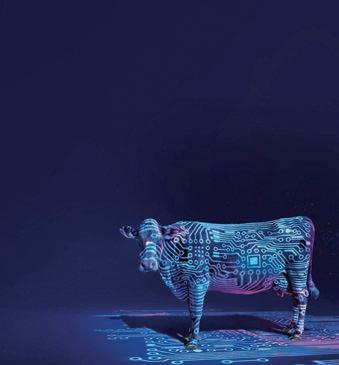
WHAT IS THE REAL COST OF A COMPROMISED IMMUNE SYSTEM?
How long is a piece of string? Especially as cows don’t always show symptoms to suggest their health status is compromised!
We know there are many ways to challenge the cow’s immune system, including heat stress, acidosis, metritis, mastitis and pneumonia. Generally this leads to reduced animal performance
The typical milk yield increase seen when an e ective deactivator like UltraSorb R is added to a ration containing mycotoxins, also makes it a useful low-cost way to diagnose and guard against potential problems.

BENEFITS
The ruminant-specific mycotoxin solution UltraSorb R brings key benefits to the dairy cow:
+ Higher feed intakes


+ Increased milk production and growth rates


+ Improved fertility rates


+ Supports natural defences against mycotoxins
■ Call us on 07395 248963 or visit abvista.com


ADVERTORIAL
Yeast cell extracts
Essential oils
A unique blend of essential oils which protect against toxin-forming moulds which may be present in feed
Multiple
sources of clay minerals Binds and removes mycotoxins most common in ruminants
Yeast wall component
Bio-active ingredient to bind and remove mycotoxins and masked mycotoxins such as Zearalenone (ZON)
OH
ZON
O O HO CH3
FOR MORE INFORMATION CALL 07395 248963
tough on those pesky mycotoxins! Don’t let the notorious ZON & DON cause a sudden drop in your herd’s performance!
Get
the existing equipment could be used more e ectively. He suggested angling fans over the cubicles and we will also look to install new fans on his advice,” he says.
“If extreme heat is to become a feature of our summers and we have longer periods of very hot conditions, we may need to look at other solutions. We recently visited farms in Italy to look at cow cooling systems where they shower the cows with cold water at the feed barrier.
“We notice that when the cows become overheated they huddle together, which is of course the opposite of what they need to do. By the time they are actually showing the signs of heat stress, it is usually too late as it is already adversely a ecting their well-being.”
Vaccinations
Like many farmers in this part of Derbyshire, bTB is a constant concern for the Oultons. ere are badger se s on the perimeter of the farm so all buildings are badger-proofed, water troughs are raised o the ground and care is taken to keep badgers away from clamps.
Michael says: “We have always had inconclusive reactors and have had several breakdowns over the years. ankfully, we have been clear for several years now but it is a constant worry.
“We vaccinate against all the usual diseases plus Bovine RSV, as we suspect we may have had a problem with this in the past. Using preventative vaccinations has helped us to reduce antibiotic use across the herd.
“We have also been using selective dry cow therapy for six years and have worked hard to improve the cows’ environment. As a consequence, we have seen a marked reduction in the number of mastitis cases.”
For several years, Micheal was crossing the Holstein to a Swedish Red to introduce more genetic diversity and hybrid vigour into the herd, but for the last 10 years
Farm facts
rThe Oulton family farm land extending to 182 hectares (450 acres) located across two main sites with other outlying blocks. The milking herd, dry cows and calves are housed and grazed at the main farm (Springfield Farm), with youngstock kept down the road at Lawn Farm. Other blocks of land are used to grow maize, wholecrop and grass for silage
rMichael Oulton farms
he has returned to the Holstein.
“When we started cross breeding, we were looking for a solid and stronger cow, but now we are using a mating programme which allows us to choose the traits we are seeking in our cows from Holstein genetics alone.
“We do not want anything too big or extreme and we concentrate more on type than production.
“We have recently started using genomics which we hope will allow us to be more selective when deciding which cows to serve with sexed semen for replacements,” he says.
Careful ration planning has tackled milk fever and has also
prevented dry cows from becoming too fat.
Diet
Michael says: “We struggled with milk fever, but a er taking advice from our nutritionist we replaced the grass silage in the diet with maize and wholecrop for the close calvers for a period of three weeks before calving.
“ is has had a positive e ect, although we have to be careful when reintroducing the grass silage as we transition them from the dry cow diet to the high yielders’ ration.
“ e dry cows have a high bre diet which includes a high propor-

with his wife Jo and son Barney. They employ Letizia Magoni, the herdsperson, and Stephen Oakes, who is responsible for the youngstock, plus other parttime staff and relief milkers
rThe milking herd numbers approximately 310 cows calving all year round, of which 180 are high yielders milked three times a day and the remainder are low yielders milked twice a day through a 30/30 herringbone parlour
rHeifers are generally served by an Angus bull and are, on average, 24-monthsold at first calving. The top genetic cows are served to sexed semen, with the remainder and third services being to beef semen
rThe herd average yield is 11,000 litres – an increase on the previous year of 500 litres
rButterfat is currently 4% and protein 3.3%
rMilk is supplied to Muller on a liquid contract

62 ANIMAL HEALTH MAY 2023
The necessary amount and quality of colostrum in the first few hours of the calves’ lives has helped result in 100% passive immunity levels.
tion of chopped straw to provide the bulk and volume to maintain rumen size. e milk cows are fed grass silage, Tra ord Gold, maize, wholecrop, a blend and soda wheat to bu er the pH in the rumen plus concentrate to yield in the parlour.”
Turning out
High yielders are housed and are milked three times a day. A er about 200 days in milk, they move to the low yielders group which, from March to October, are turned out
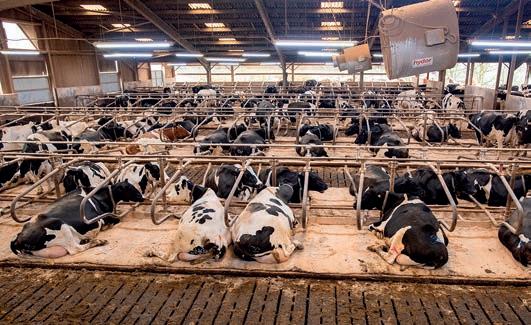

to grass and are milked twice a day.

Michael says almost all the cows will be turned out at some point during the year unless they calve down in late April or May.
e land around the farm is sloping so relatively free draining, and elds are sheltered from the worst of the weather even though they are situated at almost 200 metres (600 ).

e aim is to grow as much of the ration as possible on-farm and they have been growing maize and

wholecrop wheat successfully for many years.
Michael says: “We have to grow early varieties of maize here to ensure we can get it o before the weather conditions deteriorate. We use maize as an entry to a grass reseed, or it is followed by wheat.
“We make sure we always drill a winter cereal or grass straight a er the maize comes o so we never have any bare ground across the farm.
“Occasionally, when the crops go in late, we may have to patch
up a erwards but the grass always grows really well a er maize.”
Expanding housing for the dry cows and the low yielders, alongside investing in accommodation for the youngstock which will have to be moved down the road from the farm as buildings go for development, is the next job, Michael says.

“We may increase numbers of cows slightly but improving everything we do is the main aim so we can continue to build on excellent cow health and performance.”

63 ANIMAL HEALTH MAY 2023 Call: 028 6774 8377 (NI) +44 28 6774 8377 (ROI) www.teemoreengineering.com FARMING EQUIPMENT AND TECHNOLOGY FUND • Fixed and mobile handling systems • Manual and automatic crush • Weigh kits & EID compatible products • Calving Gates • Positive pressure tube ventilation • Head Scoops
The Oulton family’s 30/30 herringbone milking parlour.
High yielders are housed and are milked three times a day.
Since introducing a Kuhn feeding and bedding machine, farm manager Paul Redmore finds he can complete these jobs more accurately for his organic Jersey herd. Dairy Farmer reports.

Combination mixer wagon reduces costs



Based on an 850-hectare (2,100-acre) inhand farm at Neston Park Estate, Wiltshire, Paul Redmore has kept with tradition by using
homegrown straw bedding and silage for the 280-cow herd.
He says: “We are feeding and bedding down morning and a ernoon, while the cows are milked. e process needs





to be awless; we want to make the best environment for the cows to reduce any risk of mastitis and provide them with a calm atmosphere.”
Previously, he used a mixer

wagon and a separate straw chopper, which required two tractors twice a day, or swapping each machine on and o the same tractor.
Now, a 18cu.m Kuhn Pro le Plus 2 DS is used. It has two vertical augers with a straw-blowing turbine and spout to feed out. is gives the exibility to feed and bed into the farm’s buildings.





Time-saving





Mr Redmore says: “We use up to 12 six-string bales per day. Generally, it takes two hours to milk, scrape, feed and bed down 280 cows. One person milks, whilst the other scrapes, feeds and beds. Having a combination machine to feed and bed is saving us between 30-45 minutes, and the new machine is more accurate and faster at preparing the ration.”
e Kuhn ful ls the twice-a-day bedding routine and is also helping to manage feed accuracy. e unit allows feeding at ground level and directly into 1.2-metre-high troughs using the straw blower.

64 MACHINERY MAY 2023 DON’T CHANGE YOUR TRACTOR. TRANSFORM IT. WITH A STOLL PROFILINE FRONT LOADER ENGINEERING • Ideal for any tractor from 40 to 270hp • Superb visibility from the cab • Attach/detach in under 2 minutes • Effortlessly smooth, precise control • Unrivalled range of tilt/crowd angles • Ultra-strong steel, superior paint finish MORE WAYS TO ADD MORE PRODUCTIVITY FRONT LINKAGES • FRONT PTOS • PICK-UP HITCHES • WEIGHTS • REVERSING FANS • FRONT PRESSES For further details about any products in the Lynx Engineering range call us today on 01327 843215 or visit www.lynx-engineering.co.uk 3340 Lynx Front Loader Quater Pg Ad DF.indd 1 17/03/2023 11:58
The 18cu.m tub uses two mixing augers, holding two-and-a-half six-string bales.
Consistency in routine is key for the team members involved, but more importantly for cow

welfare and milk production. e machine’s polygon shape delivers consistent fodder
circulation. It is designed so that the entire volume of the chamber is used during chopping and

mixing, with the double-pitch angle of each auger providing a constant break-down of feed.

65 MAY 2023
Paul Redmore
CROSS
Mr Redmore says: “ e accuracy and consistency of the mix stops cows sorting the feed. is is be er for the cows because they love consistency, and it also translates into higher yields.”
e business analyses silage every two months. Working with a nutritionist to calculate the optimum TMR, they are able to use the mixer to accurately weigh each component.
“Testing silage and monitoring the TMR is helping to maintain cow health and productivity,” Mr Redmore says. “ e machine can deal with any grade of material and the chopping knives provide a consistent mix. is is also saving feed which is lowering our costs.”
Weighing
e internal weighing function of the unit also enables Mr Redmore to make the most e cient use of straw for bedding.
He says: “ e weigh scale means I can monitor and control straw use for the various sheds while checking how much is in the tub to minimise
journeys. We can even split bales to bed the smaller sheds; we can t two-and-a-half sixstring bales in the tub, and having this capacity has reduced the time and fuel needed to bed the sheds each day.”
Precision
e chopper adds further precision, as well as making the loading and preparing of the straw easier and more accurate.
e two augers are driven on the same driveline, mixing the product in a gure-of-eight pa ern which increases product ow in the chamber.
Mr Redmore says: “ e straw chopper reduces the amount of straw we use by about 30% as it avoids waste caused by lumps going through into the sheds and creating an uneven layer of straw.
“ e blower is also very accurate, enabling us to bed wide areas and cubicles.”
e mixer also features the manufacturer’s optional ‘Cleanstraw’ function, which reduces dust in livestock buildings by


 PAUL REDMORE
PAUL REDMORE
applying a ne mist of water to straw as it is distributed.
It uses a 64-litre water tank and three misting nozzles mounted at the exit of the straw-blowing chute.
e nozzles are fed by a pump which applies one litre of water per 100kg of straw.
Applying a mist of water reduces excessive levels of airborne dust by decreasing the amount of time the particles remain suspended in the air.
Trials conducted by Kuhn have shown that the air in a typical livestock building should



66 MAY 2023 www.abbi-aerotech.com www.rumitechs.co.uk Ph: 07714 846987 HEATSTRESS? The climate in the barn is the key! NEW! NEW! DC-permanent magnetic motor 40-70% energy savings No frequency control needed No motor protection switch needed No special wiring needed No maintenance Mains: 230/400V 50Hz Simpler installation Less electric wiring No obstacles inside No restlessness when doing maintenance Shorter suspension of the fans Lower total investment Airflow in length of cubicles THE SOLUTION: ABBIFAN 140-XXP-2 The latest motor technology now applied on our fans! Direct drive.
VENTILATION blows fresh outside air in your barn!
Testing silage and monitoring the TMR is helping to maintain cow health and productivity
The integrated ‘Cleanstraw’ system applies a water mist to the straw as it is blown, reducing dust.
MACHINERY
be dust-free within 30 seconds a er straw-blowing with the ‘Cleanstraw’ system, which is compared to several minutes without.
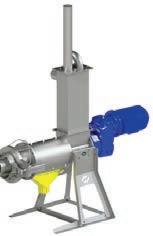
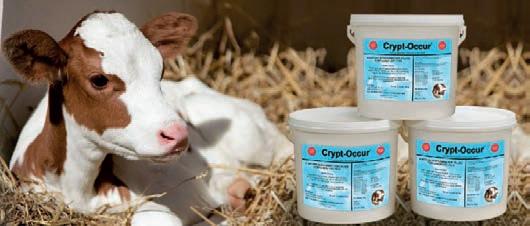
Mr Redmore says: “Adding a ne mist of water as straw exits the spreading chute means very li le water is required. e low water usage also means the straw still has high absorbency which makes it more hygienic.”
Maintenance
Upfront costs of the machine were 30% less than purchasing two separate machines, and it requires less operator time and fuel to carry out the daily feeding and bedding work.

To reduce power consumption, the unit utilises asymmetric knives which are designed to be self-cleaning with a cu ing edge pro le, which claims greater torque transfer from the drive to the material.


As it is a single machine
delivering two services, the increase in mechanical complexity is outweighed, in part, through reduced overall maintenance.



Mr Redmore says: “ e unit reduces maintenance because we only have one machine to maintain, and it only requires basic


greasing once a week. We were surprised with the low power output. It runs at a pto speed of 540rpm which is saving fuel.”

67 MACHINERY MAY 2023 Call Andy Berry about “Crypt-Occur” 07969 164 066 www.berrysagriculture.co.uk Maintaining Calf Health OWEN BOND@SAVECO-WATER CO UK WWW SAVECO-WATER CO UK Separators Green Bedding Screw Conveyors Long Shaft Pumps Submersible Pumps Submersible Agitators s EXPERTS IN SLURRY HANDLING 07851 25 26 27 01684 29 91 04 Call today to be put in contact with your local dealer
The Kuhn mixer is used to mix and distribute the ration, alongside straw chopping and spreading.
MILKprices
Arla Foods forced to make deeper cuts



JWith the ongoing price negativity in wholesale dairy markets over the last six months, and especially since the start of the year, the April price reduction of 6 euro cents/kg (5p/kg) by Arla Foods for both conventional and organic milk should come as li le surprise for anyone following the markets.
And unless markets start to turn positive and quickly, then along with other buyers, most of which have now con rmed further price cuts for May milk supply, the cuts announced to date are unlikely to be the last.

Levelling out
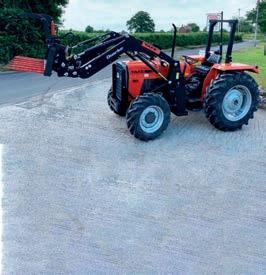
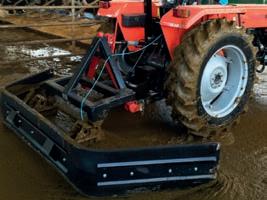

At the time of its price announcement, Arla con rmed that while some prices for dairy categories were seeing early signs of levelling out, the severity of the ongoing cost of living crisis and volatile economic environment was continuing to negatively impact consumer demand.
As a result, commodity prices continue to decline signi cantly, especially as global milk volumes increase overall.
e company’s outlook was hopefully looking towards stabilisation as commodity markets get closer to balance.
It goes without saying this is a record price cut for the cooperative, pu ing rmly in



the shade its record monthly price increase of 5c (4p) for June last year.
Proof that markets can always come down faster than they go up. Following the 4c (3.5p) cut for March, the reduction takes the company’s total decrease for the year to date to 14cpl (12.34ppl).
In addition, the quarterly currency smoothing mechanism impacts the on-account price for UK owners by a further -0.01ppl. e 6c (5p) takes our manufacturing standard litre* down 5.31ppl to 39.64ppl. is price includes the guaranteed minimum supplementary payment (forecast 13th payment), increasing by 0.01p/kg to 1.29p/kg (1.329ppl).
Our liquid standard litre reduces by 5.1ppl to 38.08ppl, which represents a decline of 12.16ppl for the year to date. is price includes the guaranteed minimum supplementary payment of 1.23p/kg (1.277ppl).
Our U F Tesco price reduces by 5.1ppl to 39.5ppl, as with Morrisons to 39.47ppl, with our supplier in the retailer’s grazing group also moving down to 39.7ppl.
As with conventional, our organic manufacturing standard litre price also reduces by 5.31ppl to 44.42ppl, with our liquid standard reducing 5.1ppl to 42.68ppl.
DEEP GROOVES FOR SOLID FLOORS SLAT GROOVES DIAMOND CUT Call us on 01258 817372 email: info@tractorsuk.co.uk TRACTORS UK SOLE UK IMPORTER OF TAFE TRACTORS FROM THE BEST PEDIGREE BASIC, SIMPLE & RELIABLE TRIED & TESTED FOR GENERATIONS 08R04B Drum or oil immersed brakes Roll bar or cab 2wd or 4wd 2 Years’ warranty Comprehensive parts backup www.tractorsuk.co.uk ✆ 01258 817372 ✉ info@tractorsuk.co.uk BASIC, SIMPLE & RELIABLE www.tractorsuk.co.uk • • 2 Years’ warranty Comprehensive parts backup • • Oil immersed brakes 2WD or 4WD 68 MAY 2023
Milk price analyst





Stephen Bradley on the latest milk industry developments.
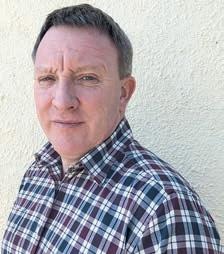





Tesco switches back to cost tracker

JTesco has reverted back to setting its Tesco Sustainable Dairy Group milk price according to its cost tracker, which has generated an increase of 1.01ppl for May.
The retailer moved away from its cost tracker last July after it issued a temporary market-based payment of 2.89ppl, in addition to the 0.76ppl originally set by the tracker for that month.










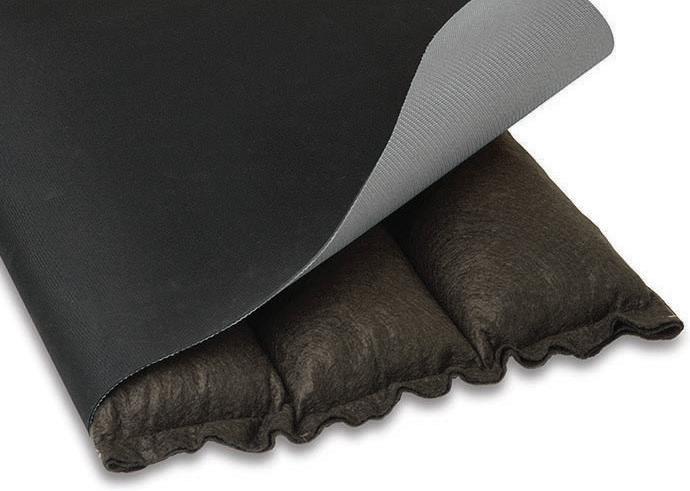
The increase follows the 1.5ppl cut from the previous month after the price moved in line with the Muller Direct cut and takes our liquid standard litre to 43.51ppl.
Our Arla Direct Tesco supplier also receives the same increase, taking the price up to 43.26ppl.





The latest Promar March 2023 tracker review for the 12 months from October 2022 to September 2023 puts the cost of milk production up 3.22ppl since the December 2022 review to 43.98ppl before the latest quarterly feed, fuel and fertiliser adjustment.
Variable costs are up 2.66ppl to 27.15ppl, with overhead costs up 0.32ppl to 13.83ppl, while depreciation rises 0.24ppl to 3ppl.
Sainsbury’s tracker moves lower
JThe Sainsbury’s cost tracker has taken the Sainsbury’s Dairy Development Group price for May down by 0.99ppl to 42.91ppl for our Muller supplier and 42.79ppl for our Arla supplier, both on our liquid standard.

The tracker has feed, fertiliser and fuel declining by 0.91ppl to 19.56ppl, with overheads (including depreciation) down 0.11ppl to 15.49ppl, while other variables are up 0.03ppl to 7.24ppl. Adding the average
0.62ppl Herd Health and Efficiency bonus to the 42.29ppl takes the price to 42.91ppl.












Other retailers to reduce their milk price from May include Waitrose, with its 1.6ppl cut to 46.7ppl, with suppliers in the Muller Co-operative Dairy Group seeing their price reduce by 0.82ppl to 42.15ppl, while Muller suppliers with volume on the Lidl fixed price deal have a decrease in line with that of the Muller Direct price decrease of 2.5ppl to 40ppl.
*Our liquid standard litre is 4% butterfat and 3.3% protein, for our manufacturing 4.2% butterfat and 3.4% protein and, in both cases, Bactoscans of 30,000/ml and SCCs of 200,000/ml, with Thermodurics of 500/ml, 1m litres/year on EODC (max vehicle accessibility) based on level supply and therefore before seasonality (but includes the winter premiums paid in Northern Ireland), as well as monthly profile adjustments, balancing charges, capital deductions or annual/part annual growth incentive schemes or supplements not directly linked to dairy market price movement.



Proven 3 Ply waterproof rubber top cover www.cozycow.co.uk info@cozycow.co.uk Cozy Cow UK Ltd 07713 097184 /01296 738122 Quality and Value from a name you can trust Tried & Tested Since 1996 Unbeatable comfort and long-lasting performance ALSO ON GRANT - Range of Rubber Flooring and CCTV Syste Available with foam pad 50mm thick mattress with DPM & balanced latex core AVAILABLE ON GRANT NOW ! AVAILABLE ON GRANT NOW ! Follow us on Facebook: www.facebook.com/bdsupplies SUPPLIERS OF HOOF TRIMMING AND ANIMAL HUSBANDRY EQUIPMENT PHONE OR ORDER ONLINE Tel: 01738 842996 www.bdsupplies.co.uk sales@bdsupplies.co.uk KVK Hoof Trimming Chutes • Cow kennels • Perfect Shelter • Designed for Animal Health • Excellent Ventilation • Shelter from Wind & Rain • Shade from the Sun • Plenty of Fresh Air • Ample Space • Minimum Draught • Many options available Telephone: 01772 785252 www.farmplus.co.uk RECRUITING REPS See website for details 69 MAY 2023
MILK PRICES
Notes to table
Prices for both Liquid & Manufacturing tables paid for a producer sending 1mltrs/yr on EODC (max vehicle size accessibility) with Bactoscans of 30,000/ml and SCC’s of 200,000/ml with Thermodurics of 500/ml. Excludes capital retentions or AHDB levies, profile adjustments from level supply, seasonality, balancing and A&B price schemes (includes the winter premiums paid in NI). Excludes annual / part annual growth incentive schemes or supplements not directly linked to dairy market price movement. Liquid price for milk contains 4% b/f and 3.3% protein. Manufacturing price for milk containing 4.2%/b/f and 3.4% prot. All prices for non-aligned prices are before monthly retail supplements. (i) Dec’22 prices before seasonality or B pricing (ii) Jan’23 prices before seasonality or B pricing (iii) Table ranked on simple rolling 12mth average of monthly prices Feb’22 to Jan’23). (i) v (ii) The difference Jan’23 compared with Dec’22. UK Arla Farmers 1.28ppl price hold for Dec’22 includes the forecast 13th payment +1.24ppkg (+1.278ppl) based on our liquid std litre. UK Arla Farmers hold for Dec’22 includes the forecast 13th payment +1.29ppkg (+1.329ppl) based on our manufacturing std litre. UK Arla Farmers 1.13ppl decrease from Jan’23 includes forecast 13th payment reducing from +1.24ppkg (+1.278ppl) to 1.23ppkg (1.267ppl) based on our liquid std litre. UK Arla Farmers 1.12ppl decrease for Jan’23 includes forecast 13th payment reducing from +1.29ppkg (+1.329ppl) to 1.28ppkg (1.318ppl) based on our manufacturing std litre. First Milk price includes 0.5ppl Member Premium accrued as a 13th payment paid Apr’23. First Milk Haverfordwest Tesco Cheese Group includes 2ppl retailer premium averaged as 1.5ppl based on seasonal profile. Fresh Milk Company price before Morrisons monthly cheese supplement (last payment made in Dec’22 of 0.072ppl for Jul’22 to Dec’22 period). MMG Direct price includes 1ppl Premium paid annually in arrears to Direct/ Organic farms meeting specific Müller Direct criteria (Quartely payments from Apr’22).Crediton Dairy price includes FarmMetrics Scheme Bonus of 0.5ppl paid monthly. South Caernarfon price includes flat 0.7ppl annual member bonus. ‡ Price includes 12mth average rolling profile fixed at 0.57ppl. * UK Milk Futures Equivalent (UKMFE) net to producer includes 5% processor margin and allowing 2.62ppl ex-farm haulage + milk testing for Jan’23. ** Ave delivered spot milk net to producer allows 3ppl covering haulage + milk testing and margin. (iv) Latest confirmed milk price at the time of going to press. UK Arla Farmers 2.54ppl decrease from Feb’23 includes forecast 13th payment holding on 1.23ppkg (1.267ppl) based on our liquid std litre. UK Arla Farmers 2.65ppl decrease for Feb’23 includes forecast 13th payment holding on 1.28ppkg (1.318ppl) based on our manufacturing std litre. UK Arla Farmers 3.39ppl decrease from Mar’23 includes forecast 13th payment holding on 1.23ppkg (1.267ppl) based on our
70 MAY 2023
liquid std litre. UK Arla Farmers 3.52ppl decrease for Mar’23 includes forecast 13th payment holding on 1.28ppkg (1.318ppl) based on our manufacturing std litre. UK Arla Farmers 5.10ppl decrease from Apr’23 includes forecast 13th payment holding on min 1.23ppkg (1.267ppl) based on our liquid std litre. UK Arla Farmers 5.31ppl decrease for Apr’23 includes forecast 13th payment increasing from 1.28ppkg (1.318ppl) to 1.29ppkg (1.329ppl) based on our manufacturing std litre. MMG Direct Premium for Direct/Organic farms meeting specific Müller Direct criteria confirmed as 1ppl for 2022 and paid quarterly, Apr’22, Jul’22, Oct’22 & Jan’23. All prices (excluding First Milk Haverfordwest Tesco at 1.50ppl and Parkham Farms Tesco 1ppl) are before monthly retail supplements. Milkprices.com cannot take any responsibility for losses arising. Copyright: Milkprices.com Dec’22 Jan’23 12mth Diff Latest 4.0/3.3 4.0/3.3 Ave Jan’23 Confirmed Before Before Feb’22 v Milk Seas’lty Seas’lty Jan’23 Dec’22 Price LIQUID PRICES (4% b/f & 3.3% prot) (i) (ii) (iii) (i) v (ii) (iv) UK Arla Farmers – Morrisons (Grazing) 51.86 50.73 46.72 -1.13 47.99 UK Arla Farmers – Tesco 51.66 50.53 46.65 -1.13 48.19 UK Arla Farmers – Morrisons 51.63 50.50 46.48 -1.13 47.96 Müller Milk Group – M&S 51.38 52.66 46.25 1.28 52.66 Dale Farm NI 51.02 44.02 45.41 -7.00 50.02 UK Arla Farmers 50.24 49.11 45.23 -1.13 46.57 Müller Milk Group – Waitrose 50.00 50.00 45.15 N/C 50.00 Dale Farm GB (Kendal) 48.95 48.70 43.74 -0.25 48.70 Crediton Dairy 48.50 48.50 43.63 N/C 45.00 Freshways 50.00 47.00 43.50 -3.00 44.00 Paynes Farms Dairies 48.00 48.00 43.42 N/C 43.75 Yew Tree Dairy 48.00 48.00 43.38 N/C 47.00 Müller Milk Group – Tesco 48.00 48.00 43.38 N/C 47.00 Meadow Foods Lakes 48.00 47.00 43.23 -1.00 44.15 Meadow Foods 48.00 47.00 43.23 -1.00 45.50 Müller Milk Group – Müller Direct 48.00 48.00 43.17 N/C 45.50 Arla Foods – Tesco 47.75 47.75 43.13 N/C 44.00 Müller Milk Group – The Co-op Dairy Group 47.83 47.83 43.12 N/C 44.44 Müller Milk Group – Müller Direct (Scotland) 47.79 47.79 42.96 N/C 44.00 Müller Milk Group – Sainsbury’s 47.50 47.50 42.92 N/C 44.32 Arla Foods – Sainsbury’s 47.38 47.38 42.80 N/C 45.50 Blackmore Vale Dairy 48.00 48.00 42.59 N/C 43.79 Grahams Dairies 46.00 46.00 41.96 N/C 44.00 Simple Average 48.93 48.26 44.00 -0.67 Simple Average (excl. retail contracts) 48.50 47.47 43.50 -1.03 MANUFACTURING PRICES (4.2% b/f & 3.4% prot) UK Arla Farmers 52.24 51.12 47.04 -1.12 48.47 Dale Farm NI 51.91 44.91 46.28 -7.00 50.91 Wensleydale Dairy Products 50.52 50.28 45.68 -0.24 40.90 Parkham Farms Tesco 50.90 50.90 45.54 N/C 44.06 The Fresh Milk Company – Level Profile ‡ 50.69 50.69 45.52 N/C 49.27 First Milk – Haverfordwest Tesco Cheese Group 51.19 51.19 45.28 N/C 47.19 Wyke Farms 50.12 50.12 45.01 N/C 46.11 The Fresh Milk Company (Lactalis) 50.12 50.12 44.95 N/C 43.49 Barber’s Cheesemakers 50.02 50.02 44.88 N/C 50.12 Saputo Dairy UK – Davidstow 49.50 49.50 44.50 N/C 46.50 South Caernarfon 50.00 48.50 44.14 -1.50 44.00 Glanbia – Llangefni (Constituent) 49.25 49.25 43.98 N/C 43.25 First Milk 49.69 49.69 43.78 N/C 45.69 Belton Farm 48.55 48.55 43.70 N/C 44.05 Arla Foods – Direct Manufacturing 49.70 49.70 43.70 N/C 48.58 Simple Average 50.29 49.64 44.93 -0.66 Simple Average (excl. retail contracts) 50.18 49.42 44.86 -0.76 ‘B’ Price Indicators StoneXMilkprices.com UKMFE (gross) 41.50 37.33 49.30 -4.17 *StoneXMilkprices.com UKMFE (net) 36.76 32.85 44.26 -3.91 **Delivered spot milk (net to the producer) 36.12 36.65 0.53 Latest milk prices from

Non-aligned price for May drops to 38p D
efra’s milk price for February fell again, by 1.14p to 48.06ppl at 4.31% fat and 3.38% protein. It equates to a standard litre of about 46.1ppl. e average non-aligned price for April, weighted
according to processor milk volumes, is currently 39.91p, and that drops another 1ppl to 38.9p for May. But some processors have not yet announced their May prices, and that will fall again.
e future prospects are not encouraging. e latest AMPE
gure for March is 34.55p, which is actually up 1p on February. But a er a processor margin and additional supply chain costs have been factored in, it equates to about 30.55p.
MCVE is at 39.35p, before costs and a margin, which equates to 35.35p.
No obvious floor for EU prices just yet
JEU commodity prices continue to decline and none have seemingly found their floor.
Butter has dropped for six consecutive weeks now, after a very brief and inexplicable surge in February.
GDT drops again
JPrevious GDT auctions were gloomy. It is worse now, with the first April auction down 4.7% – its biggest fall since last August. There have been seven reductions out of the last eight auctions and 15 out of the last 20. WMP dropped 5.2% and only just managed to hold its own above $3,000 (£2,395) at $3,053 (£2,438). It is the lowest price now since
The average price is now at €4,450/tonne, (£3,923/t) which is down €500 (£439) now on its recent peak.
UK butter has dropped below £4,000/t (£3,526/t) for sizeable quantities.
The SMP price has also fallen in line with butter,
and is now at €2,250/t (£1,983/t). The combination values farmgate milk at well below 30p now.
On cheese, curd is put at €3,950/t (£3,482/t). Curd is important as the usual rule of thumb is that mild Cheddar is £150-£200
Futures crash
November 2020. SMP settled at $2,579 (£2,059), its lowest since June 2020. But Cheddar increased after suffering some $900 (£718) worth of losses since the end of February.
Prior to this auction, Fonterra dropped its predicted farmgate price again, to less than 30p equivalent. If the auction carries on like it is doing, the firm might have to drop again.
JThe futures suffered another mauling after the GDT, with New Zealand butter futures down nearly €300 (£265) equivalent on average over the next six months and down more than €650 (£573) compared to February.
EU butter futures were down another €70 (£62) in the week of going to press, with €100 (£88) falls in June through to August.
But despite those, the
more than curd. That would value it at £3,600.
But Gouda is way lower at €3,175/t (£2,799/t) and that will drag down mild prices as there is never normally an £800/t differential between the two. Mozzarella is at €2,925/t (£2,579/t).
average price is still a respectable looking €4,750 (£4,190), but in contrast, New Zealand’s average is a sobering €4,125 (£3,639).
On powders, EU SMP is down €130 (£115) on average to €2,425 (£2,139) and New Zealand SMP is down €50 (£44) to €2,525 (£2,227).
The combination converts into a milk price of less than 30p – similar to the GDT, therefore.
Milk volumes and lack of demand
JPrices are falling markedly because of the lack of demand for dairy products and volumes in most markets being plentiful. Buyers are not worried about product availability and are sitting on their hands waiting for further
reductions. Milk volumes in Europe are about 1% ahead of last year still and, although those on the UK are tracking less than they were and are now on a par with last year, they need to fall markedly to turn the market.
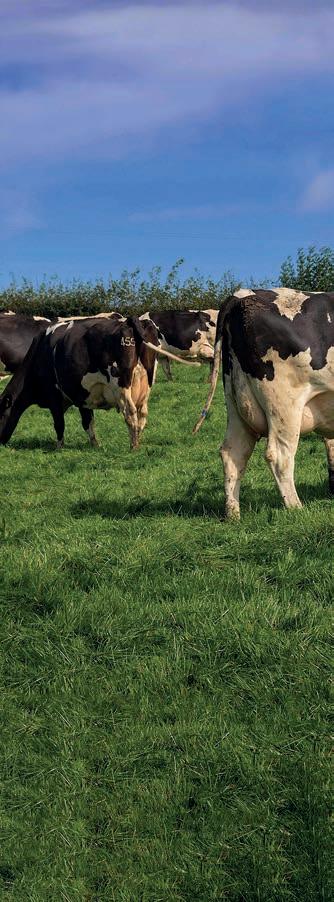
72 MILK ANALYSIS MAY 2023
GDT predicted price vs. UK non-aligned price (with three-month lag) Jan 2019 May Sept Jan 2020 May Sept Jan 2021 May Sept Jan 2022 May Sept Jan 2023 60 50 40 30 20 10 0 GDT Non-aligned
Milk price gap widest in history
JThe gap between the highest and the lowest milk price is the widest it has ever been, at nearly 20p.
At the time of writing, those in the Marks & Spencer pool were currently getting the highest milk price, at 52.66p,




while those supplying Glanbia are down at 32.86p for a standard litre and 34p for a manufacturing one.
The gap of nearly 20p is the highest ever, with the previous biggest differential being 15p in May 2016.
Highest vs. lowest farmgate prices, including retail-aligned pools
73 MILK ANALYSIS MAY 2023 Key Features: Flying insects stay away Birds stay out Energy efficient Reduces ground moisture High Volume Low Speed 100ft by 100ft effective working area HVLS - Fans For a no obligation quote or more information Scotland/N. England Will - 07591833853 Wales/Midlands/S.England Fred - 07762800149 N. Ireland/R.O.I - 07803124235 JohnEmail - info@cowcaresystems.com Andrew Cowcare SYSTEMS Innovators in Dairy Farming
The average non-aligned price for April was 39.91p, and that dropped another 1ppl to 38.9p for May.
Jan 2016 May Sept Jan 2017 May Sept Jan 2018 May Sept Jan 2019 May Sept Jan 2020 May Sept Jan 2021 May Sept Jan 2022 May Sept Jan 2033 May 55 50 45 40 35 30 25 20 15 10
NEWProducts
This month, we feature a new grass guide offering forage planning advice, a four-teat ad-lib calf feeder and a bolus for heavier cattle.
BVDV diagnostic
JScottish biotech company Biotangents has launched its first next generation molecular diagnostic assay.
AmpliSpec LAB BVDV is designed for use by laboratories to detect bovine viral diarrhoea virus in cattle.
Its unique design, Biotangents says, utilises isothermal amplification tec“ology, meaning labs can use less expensive equipment while lyophilised bead tec“ology ensures its stable and easy to use.
While Biotangents believes its new test will be a novel alternative or supplementary assay to those already used by laboratories in the UK, it sees export markets where prevalence is high but eradication is low as key to the product’s success.
r More information from biotangents.co.uk
Got a new product?
JNew products are featured in each issue of Dairy Farmer. Please send details and pictures to Hannah Morgan at hannah. morgan@agriconnect.com, or call 07824 498 702.
Bolus for heavier cattle available
Ateam of scientists, vets and farmers at Animax have developed a new bolus, Tracesure Cattle XL, to supply cattle weighing over 500kg with enough essential trace elements for six months in just one bolus and in one single application, rather than two to four applications needed previously.
New tec“ology
The single application is as a result of the new waxed groove diffusion tec“ology which regulates the rate of release, meaning the bolus increases in surface area over time for a safe long-lasting release. This has allowed
higher levels of trace element inclusion in a single bolus. A free bolus applicator is being offered with every eight boxes
of 10 bolus ordered between March and June 2023.
rMore information from animax-vet.com
New grass guide offers forage planning advice
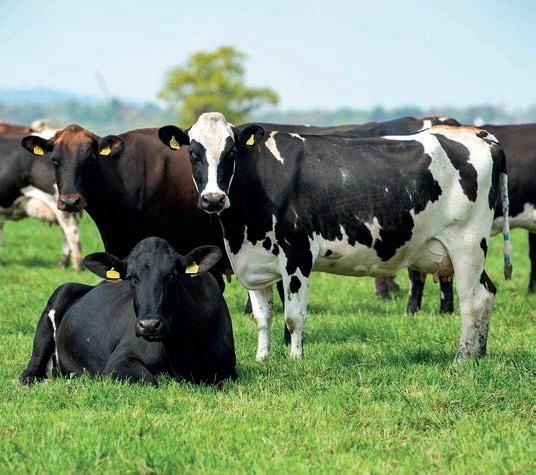
JField Options has published the 2023 edition of its grass, clover and forage crop guide, which contains full details of its cover crops, forage crops and specialist grass, clover and herbage seed mixtures, alongside agronomic and forage planning advice.
The new publication also contains details of Field Options’ specialist fertilisers and silage inoculants, along with guidance for how and when these products should be used.
Also featured is advice on pest control, weed control
and soil health, as well as the latest results from Field Options’ extensive grass and clover mixture trials.
rDownloaded the guide for free at field-options.co.uk, or for more information call 01544 262 500 or email info@field-options.co.uk
74 MAY 2023
JOpico has introduced its range of Magnon 8 forage wagons into the UK. The smaller sibling in the Magnon series, it follows the successful 2019 launch and rollout of the Magnon 10 range.
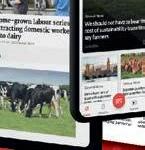


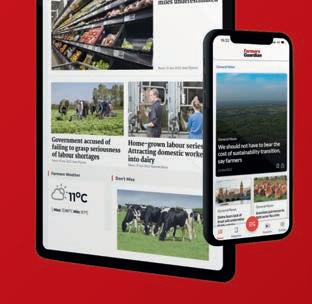
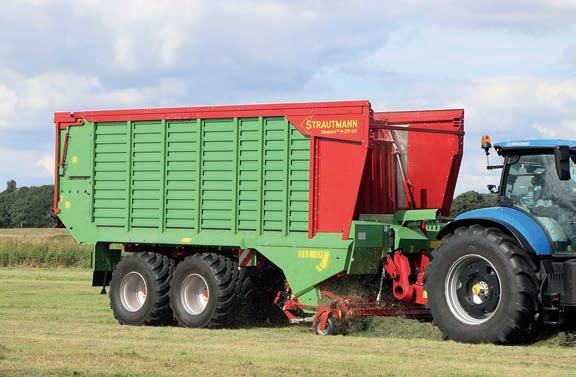
The Magnon 8 is a compact machine with a loading capacity of 36-44cu.m. It has a smaller ‘external’ footprint to other wagons with similar DIN.
The range features a new moving front wall, as well as Flex-Load pickup and Exact Cut as standard. The three models in the Magnon 8 series (370, 410 and 450)

are aimed primarily at agricultural businesses and contractors with high demands, which are dependent on compact dimensions.




































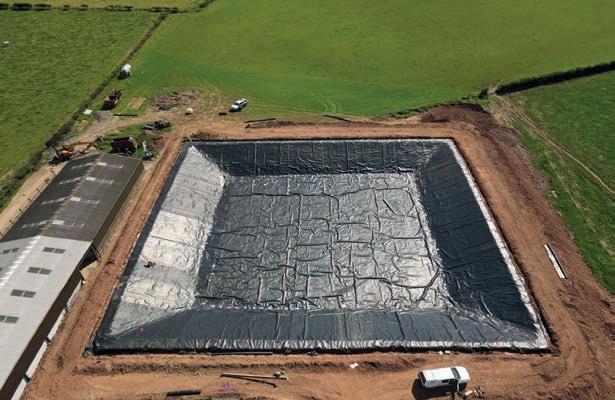
The Magnon 8 forage box is 2.25 metres wide and consists of four round steel chains (10 x 31mm) embedded in the steel platform floor.
They each have a breaking strain of 13 tonnes. The entire platform is powder-coated for protection against corrosion.

The Magnon 8 CFS 370 has an RRP of £129,588.



Four-teat ad-lib calf feeder





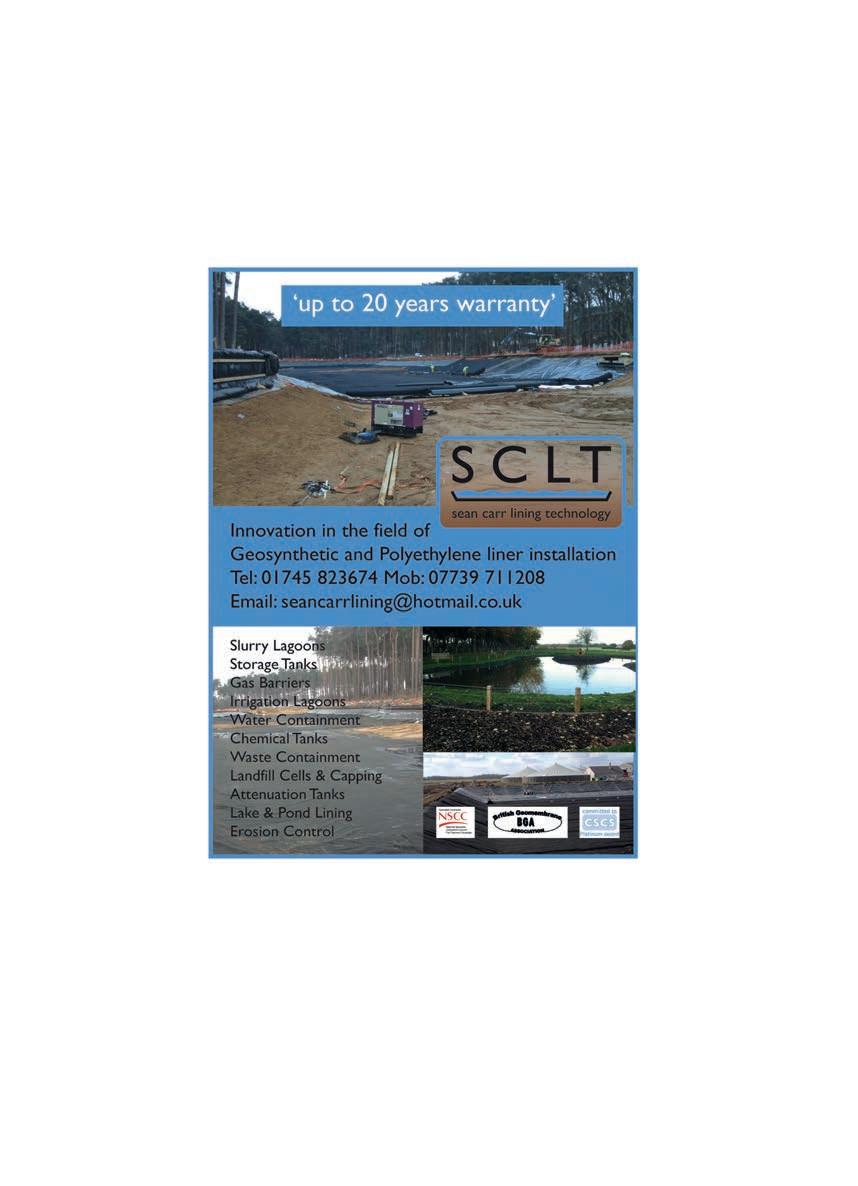
JA new milk bar feeder for ad-lib feeding systems has been launched by Dairy Spares. It is designed with two different teat heights and feeding mechanisms which ensure the speed of milk intake is controlled through the rearing phase until weaning.
Young calves start off on the feeder with teats inserted at the lower level which are firm initially, meaning calves will have to suckle hard to ensure feeding is controlled.
After two to three weeks, the teats will start to soften and drinking speeds will start to increase.
When this happens, the same four teats are moved























75 MAY 2023
UK SLURRY LAGOON LINERS AND FLOATING COVERS Tel: 01745 823674 Mob: 07739 711208 Email: sean@seancarrlining.co.uk www.seancarrlining.co.uk OVER 30 YEARS EXPERIENCE Materials meet EA and SEPA requirements, installed and fully tested by TWI / CSWIP CERTIFIED TECHNICIANS Covers comply with EA and SSAFO legislation Full UK & Ireland Coverage PONDS LAKES SLURRY LAGOON LINERS AND FLOATING COVERS Tel: 01745 823674 Mob: 07739 711208 Email: sean@seancarrlining.co.uk www.seancarrlining.co.uk OVER 30 YEARS EXPERIENCE MATERIALS & INSTALLATION Materials meet EA and SEPA requirements, installed and fully tested by TWI / CSWIP CERTIFIED TECHNICIANS Covers comply with EA and SSAFO legislation Full UK & Ireland Coverage WATER STORAGE IRRIGATION RESERVOIR PONDS LAKES SLURRY LAGOON LINERS AND FLOATING COVERS Tel: 01745 823674 Mob: 07739 711208 Email: sean@seancarrlining.co.uk www.seancarrlining.co.uk OVER 30 YEARS EXPERIENCE MATERIALS & INSTALLATION GUARANTEED Materials meet EA and SEPA requirements, installed and fully tested by TWI / CSWIP CERTIFIED TECHNICIANS Covers comply with EA and SSAFO legislation Full UK & Ireland Coverage WATER STORAGE IRRIGATION RESERVOIR PONDS LAKES Visit FGInsight.com Keep up to date with the latest news headlines in the agricultural industry In print, online and via our app App access only available to subscr bers Co s E CLASH approximatel price needed 0ppl or armer flow. have ju the mo y, i ionshipwi h feel they av airly hey mecretailers hani warnedrelationships theret-screamieirmodels ng’,sinc eir priori ies are heir omer andshareholders, not farmers. He aid “Thesealignedpool ma havebeengoodfor ew selectbut highly ebatable hethe the have b good for thein us d hi k eirtime ascome Sai bur spokesperso said tima n prices i adva help member plan, but highlight d he forecasts o ldchangebetweenno andSep ember LTURE June 10 2022 Linkbetween farmprofit andpasture plans PAGE 78 LIVESTOCK PAGESOFSHOW HIGHLIGHTS SEEP82 8 STEN THE ODCA L th e ed n he O The Ga pod for o thi st ificantnumb T sand ainsb ys milkpoo h gned equi tingtheindu y 08/06/2022 15:53 rsatri koflosingsupplie s ILK PRICE h h inu price farmer market at risk industryleader chair Michae alarmaft recen dSainsbury’s liquid nd 35ppl d41.7 Kite Co sult g no production was 42-43ppl, t ai b out 48-50ppl to around milk He aid “Farmers esi b use of also bou heirrela ionship ailer d hey may ot been treated couldhavebeenin he Mr Oakes called retailers revi their pricing mec eyvaluedtheirfarmerrelationships Yet Walklandwarned ailer would o adjust theirwithout‘kickingandscreami E HEART OF AGRICULTUR bac to how F 7000made waves 7 ACHINERY behind in drvefor more potatoes 1 USIN S
Forage wagon range comes to
Milk PasteuriserMR1000 with Homogeniser. Travis Twin StationGlass Bottle Washer. 6 head Glass and poly milkbottle fillers.


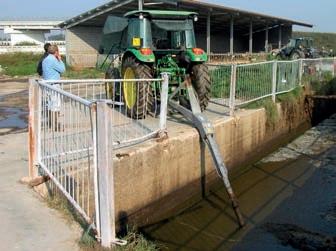
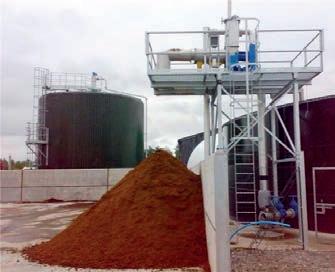
100 ltr Electric Batch Pasteuriser. Batch Ice Cream Freezer




Single Phase Electric. APV Gaulin Homogenisers K3 K6 MC18. Dawson 12 head Bottle FillerPlastic and Glass. Labeller HIS Cap SealerCollecting Tables full line.
Wait 07788 233608




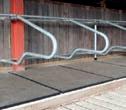





Delaval mobile milking bale for hire/sale. Delaval Blue Diamond 32/32 fast exit MM25s. Save energy, Ice Builders : Bulk Milk Tanks. Heavy duty replacement troughs for most parlours. Delaval VMS Robots : Milk meters, keypads, feeders etc. Everything for the Dairy Farmer Call Vic/Tracey Brown Tel: 01260 226261 www.milkingequipment.com Milking Equipment 76 MAY 2023 Equipment & Accessories SEPCOM The unique separator Slurry pumps & lagoon mixers 01328 701992 | enquiries@greencrop co.uk | www greencrop co.uk Multicam dirty water irrigator Slurry pump Pump in a box DAIRY FARMER CLASSIFIED TELEPHONE: 01772 799400 Tractor GPS 1 8m x 1 2m / 6ft x 4ft Each 30kg Per Mat Easy Grip Handles Animal Proof Weather Resistant 100% Rubber Construction R U B B E R S Y S T E M S F O R A G R I C U L T U R E DAIRY MAT ARK www arkmat co uk C a l l o r E m a i l F o r P r i c i n g A n d F u r t h e r D e t a i l s 01392 209 394 info@ark-rubberandresin co uk PARLOUR MATTING HEAVY DUTY SILAGE PIT MATS SUPERSOFT CUBICLE MATS ALLEY MATS 5 YEAR GUARANTEE DAIRY FARMER Building Services SPRAY FOAM INSULATION To Crop & Livestock Stores, Poultry Sheds, Cattle & Pig Buildings, Workshops & Barns. Frost & Condensation Protection. Temperature Control Energy Saving Tel: 01405 812682 www.webstersinsulation.com info@webstersinsulation.com The Captive Bolt Stunner that’s also humane on your pocket! ORDER YOURS NOW! For further enquiries and for telephone orders please contact Calton Moor Farm 01538 308697 You can pay by Cheque made payable to M Dickinson, Bank card over the telephone, or BACS, please ring for bank details. BRNO Guns UK Calton Moor Farm, Swinscoe, Ashbourne, Derbyshire, DE6 2BU. TRADE ENQUIRIES WELCOME E&OE www.brnoguns.co.uk
Bolt gun come with a box of 50 blanks a carry case and
Used for the humane destruction of animals, no firearms permit is required to use one and at only £320.00 (inc VAT & p&p) this has to be the best value Captive Bolt Stunner on the Market! The
postage Electric
Charles
‘ON THE BUTTON SOLUTIONS’
Livestock Services

Business Development Manager

Agriconnect is a business unit within the Arc network, a global events, data, and media platform. Arc is a fast-growing global events, data, and media platform with a varied portfolio content led portals, magazines, and events. Agriconnect’s mission is to empower, inspire, and connect people and business in agriculture by creating trusted content and connections that help the industry thrive.
Since 1844, the brands of Agriconnect have been the trusted source of information for farmers and with brands like Farmers Guardian, events, like LAMMA and Farm Business Innovation, and digital platforms, like FG Insights, Agriconnect continues to bring together the British farming community.

THE ROLE:
• We are now looking for a motivated and driven salesperson to join our Sales team.
• The main function of the role is to develop business through growth in revenue, yield, and to increase customer numbers. You will be required to identify new opportunities and in uence companies’ media buying habits within the agricultural sector. Due to the ever-changing nature of the industry, this person will have the ability to spot new avenues and exploit market trends.
• Hours: 35 hours per week – Mon – Fri
• Location: Preston – temporary hybrid remote
• Salary: Competitive, dependant on experience.
SKILLS & EXPERIENCE:
• Own, support and fully develop speci c market sectors
• Conduct sales presentations by telephone, email or face to face to existing and prospective clients in order to develop existing business and generate new business wherever possible.
Nationwide (01948) 662910/663143 george@greenfieldsrise.f9.co.uk

FARM HEALTH SOLUTIONS


PROBLEMS WITH HIGH SCC /MASTITIS? - WANT TO REDUCE USE OF ANTIBIOTICS? - COST EFFECTIVE PRODUCTS WITH EASY WATER TROUGH ADMINISTRATION - DISCOUNTS - WE CAN HELP WITH SHEEP PROBLEMS TOO - CALL FOR A FREE SAMPLE KIT
Ask about Herd Health Analysis
T 01756 749444 W www.crossgateshealth.co.uk
Dumped Milk & Cream Collec on

Call Rob: 07967 565264
Same day collec on PJ & VH Huntbach
• Advise existing and new customers on the most e ective solution to meet client needs within the Agriconnect portfolio.

• Continually seek and develop new sales & opportunities.
• Ability to accurately forecast future sales
• Keep abreast of all current trends, activities and relevant news within agriculture and speci c sector
• An interest in agriculture
• Highly motivated & driven, with an ability to meet ambitious performance goals
• Be enthusiastic and motivated to continually explore new opportunities, whilst possessing a natural inquisitive nature
• Excellent communication written and interpersonal skills
We o er an excellent package including:
• A competitive basic salary
• 25 days holiday increasing to 27 after two years
• An extra day o on your birthday
• Free life assurance
• Contributory pension scheme
• Employee assistance programme
Arc has ambitious plans for growth, and this is an opportunity to be part of our continuing success story whilst enjoying a fabulous work/ life balance.
We strive to create a culture that is open and respectful, where di erences are valued and celebrated. We want everyone to be able to reach their full potential, so we are committed to cultivating a company that promotes inclusion and belonging.
To apply for this role, please email amber.tabiner@agriconnect.com
77 MAY 2023
Recruitment Livestock
APPLE CIDER VINEGAR (ACV)
Dumped Milk & Cream Collection
GOODEvans
‘Beware: Wolves come in many disguises’
There have always been ‘buzz’ words in farming, but now there are more than ever.
Two of the buzz words in current use are ‘sustainability’ and ‘rewilding’.
I don’t have a clue what the rst means.
How is your farm sustainable if what you produce is worth less than the cost of production?
is is a particularly relevant question for egg producers and pig keepers, and milk could be heading the same way.
We are in a cycle of cheap food.
Cheap food will help to bring in ation down and the present Government needs to bring in ation down in order to get re-elected. It’s a shortterm view, but beware.
As regards rewilding, I don’t know whether to laugh or cry, but I much prefer to laugh.
For a farmer, ge ing o a tractor to open a gate will be a thing of the past, and unless he is particularly sprightly the wolves will get him.
Your present gate will probably be some sort of electric beam that you can drive your tractor through.
Looking on the bright side, the wolves will probably kill all the beavers as well.
Obviously I can’t put a timescale on this, but we could see packs of wolves roaming the streets where the pickings are easier, such as children on their way to school.
Until that sort of thing happens, wolves will enjoy a protected status.
e big news now is that the Government intends to turn the UK into a sort of park.
How you do that if, at every turn, you are confronted by a dangerous wild animal? is clearly hasn’t been thought through.
At present there is plenty of cheap food around the world, but there won’t always be. Natural disasters and competition will see to that.
Not that it ma ers, just as long as the Government gets re-elected at the next General Election.
A er that, food security will kick in and there will be yet another change of agenda.
But there is another buzz word. is word bothers me. It’s diversi cation.
If this word is in common use, and it is, it means that farming isn’t paying.
I know that diversi cation works for some people, but it wouldn’t work for everyone.
For example, there are four dairy farms down this road.
If one of these put in a milk sales point, it might work, but if they all did it wouldn’t.
Diversified
I have to be very careful how I write this next piece. If this person could be identi ed by what I write, there could be repercussions.
I know a farmer who diversi ed. He devised a fresh meat product.
It wasn’t niche or unique, but he was the only man in that area who was producing that sort of product.
When he started out, he sold some at farmers markets, some to the trade, some went for export.
He sold it where he could, but his nancial commitment was increasing.
He was approached by a supermarket which said they would take all his production, just as long as he didn’t sell it anywhere else. is supermarket is one of the big chain ones, if I mentioned its name you would know it immediately.
He jumped at the chance to supply them, he thought his life would be so much easier and simpler. But 12 months later things weren’t so good.
He had to put in fresh product seven days a week.
At the same time, he had to take back all the product that was not three days old and was unsold. ey paid him every six weeks.
I never asked him what he did with the product that was three days old, but I bet he sold it to the
This month, Roger Evans discusses his thoughts on the farming ‘buzz’ words of the moment; sustainability, rewilding and diversification.
78 MAY 2023
trade and I also bet that he was glad to get rid of it. Never a way to make money.
is is all very complicated and it takes a mathematical genius like me to work it out.

In my mind, for everything of his that they sold they had their money in three days. But they had his money for another six weeks.
Potato
If you are going to diversify just be careful, as wolves come in all sorts of disguises. ere’s no need to rewild the wolves, they are already here.
Wherever we live, we are all probably familiar with large-scale potato growing. If the weather is dry they operate 24 hours a day.

So for the time it takes to clear a given acreage, the local peace is sha ered by the sound of tractors.
e aspect of this that most of us notice is the

Find Jobs Faster

sight of huge trailer loads of potatoes being carted away by tractors. ese trailers and tractors are usually driven by young men whose job it is to drive as fast as they can, lest, heaven forbid, the machine that does the li ing should have to wait. ese young men usually drive with one hand. is is because the other hand is clutching a mug or a mobile phone.
If you couple this with the fact that the trailers are just as full as they can be, if the tractors have to swerve at all then it is inevitable that some potatoes get spilt onto the road.
I know of an isolated village where some of the residents became aware of this.
So they park their cars in selected places, so the tractor drivers nd themselves driving one handed through what is in e ect an elongated chicane.
One of the residents picked up enough potatoes to last the family 12 months.
JobsInAgriculture Jobs in your field Let us keep you updated by email and never miss another great job JobsInAgriculture.com
“One of the residents picked up enough potatoes to last the family 12 months
Receive the latest jobs in your inbox with our free email alert service 79 MAY 2023
Dairy farmers are in a farm policy revolution, with new environmental payments not filling the gap in direct support. Cedric Porter reports.

Reduced BPS aid takes effect
The UK’s exit from the EU included departure from its Common Agricultural Policy (CAP).
e UK Government has commi ed to continue spending £3.5 billion on agriculture and the rural economy across England, Scotland, Wales and Northern Ireland at least until the next General Election. England has gone the furthest and fastest in reform of its agricultural policies. English payments have been guaranteed at a total of £2.4bn until the election.
e last full England payments based on previous CAP support was in 2020. Since then, funding has been reduced every year. In 2023 there will at least a 35% drop in support compared to 2020.
e rate of reduction is larger for larger payments with larger historical payments.
ose farms that received £150,000 or more in 2020 will see a 55% reduction in funding this year. e last direct payments are in 2027. Half of the annual payment is now made in summer.
“ e summer payments are helping cash ow, but you have to remember that in ation has also eaten away at the value of the funding since 2020,” says Richard King, partner at Andersons Farm Business Consultants.
“Another major change is taking place in 2024, when delinking will take place; breaking the link between land occupation and support. A er that there will be no environmental cross-compliance requirements and the entitlements to support end.”
Andersons calculates that English Basic Payment Scheme was worth 1.9ppl on its model 200-cow plus followers, 130-hectare
Situation in Scotland
JInitially, the Scottish Government had wanted its farm policy to mirror that of the EU.
But it now plans to introduce a four-tiered system in 2025, with half of the support conditional on reducing greenhouse gas emissions, managing plant nutrients and improving biodiversity, soil health and animal health and welfare.
The four tiers are base and enhanced level direct payments, elective payments for specific aims such as developing food businesses, organic farming, innovation
and enhancing habitats. Advice, career development and specific support for woodlands, less favoured areas, peatland, plus beef and lamb makes up the fourth tier.
Andersons says that BPS payments were worth 1.8ppl to its model Scottish dairy farm in the 2022/23 milk year or 35% of the 5.1ppl margin.
The payment will remain the same in 2023/24, but a squeeze on profitability may mean that direct support is responsible for 75% of the margin, with just an extra 0.6ppl coming from production itself.
(321-acre) part-rented farm in the 2020/21 milk year, the last year of full payments. at fell to 1.8ppl in 2021/22, was down to 1.5ppl in 2022/23 and will be 1.2ppl in 2023/24, with further reductions to nothing by 2028/29.
Mr King says pro ts are expected to fall in the 2023/24 milk year as falling milk prices and continued high costs bite.
Surplus
e gures estimate a 5.9ppl business surplus in 2021, with the basic payment making up 30% of that gure. at falls to 5.5ppl in 2022/23, with support at 27% and to just 2.4ppl in 2023/24 when funding will make up half of pro t.
“Our forecast for 2023/24 is for a signi cant fall in milk prices on average. Costs will not fall as fast and this squeezes margins. Pro ts are below
Situation in Wales
JA Sustainable Farming Scheme (SFS) is set to replace BPS at the start of 2025.
There are three layers to the SFS. The universal actions layer is compulsory for all farmers in the scheme and will include baseline environmental standards, which may mean a requirement for 10% of the farm to be devoted to seminatural habitats or woodland.
There may be some flexibility and exemptions based on specific farm types and locations.
A targeted farm approach will be taken in the optional action layer. Farmers will be able
where they were in 2020/21, but at least there is a return from production. Without the bu er of support there is a danger in future years that the farm goes into a loss.”
New payments are a long way o matching the reduction in direct support.
Analysis by e Observer newspaper shows that the reduction in funding to all English farmers in 2022 was 22%.
However, new funding under the Sustainable Farming Incentive was at £10.7 million, just 0.4% of the Government’s total spending commitment of £2.4bn.
“It is worth remembering that new environmental payments are not a
to choose which action they undertake and receive payment upon delivery in addition to their universal action payment. This could include devoting more than 10% of the farm to wildlife habitats or woodland; actions to improving grazing; growing crops to replace bought-in feed and actions to improve productivity.
A complimentary action layer to encourage collaboration to improve landscapes, develop food-chain businesses and share knowledge is the third element. The SFS may be phased, with additional support from small grants.
80 BUSINESS CLINIC MAY 2023
like-for-like replacement of direct support; they require cost and e ort to access,” said Mr King.

Much of the rst tranche of Sustainable Farming Incentives (SFIs) introduced last year apply to dairy farmers. A £28/ha (£11.30/acre) payment is available for farmers who test their grassland soils’ organic ma er and ensure that 95% of their land is covered with vegetation over
Situation in Ireland
JA tiered approach is being proposed with an area-based capped and conditional Farm Sustainability Payment.
Farming for Carbon will encourage more general carbon reduction through peatland reduction, efficient feed and
winter. at rises to £58/ha (£23.47/ acre) if 15% of the land is also put into herbal lays. Separate payments for arable land and moorland are made.
Carrying out integrated pest management, including a review and plan and removing insecticides from a spray regime can also a ract funding.

Funding for an annual animal health and welfare review designed to reduce disease and increase productivity is also available. Additional incentives have been launched this year, including


fertiliser use and generating energy from waste.

There will be a fourth Farming With Nature tier.

Extra support for innovation, supply chain development and encouraging new generations of farmers will be offered.
a £333/ha (£135/acre) payment for taking eld corners out of production and £474/ha (£192/acre) to manage grass for winter bird food.
Using very low volumes of crop nutrients can earn up to £151/ha (£61/acre) in non-severely disadvantage areas, while there are payments for hedgerow management.
Announcements

Agro-forestry, water management, farm woodland and organic payments are expected to be announced in 2024. Meanwhile, the existing Countryside Stewardship scheme
has been retained. Unlike the BPS, which required an annual application every May, farmers can apply to join SFI schemes whenever they want.
A series of English farming grants has been introduced. e Farming Equipment and Technology Fund gives xed payments for 120 speci ed items with grants between £2,000 and £25,000.
Water management, productivity and adding value initiatives can attract between £35,000 and £500,000, with the Slurry Investment Scheme paying out £25,000 to £250,000 for projects which allow the storage of six months’ worth of slurry.

New payments are political, with their future dependent on the actions of a new Government a er the probable 2024 General Election, and whatever Government is in power, Mr King warns there is no guarantee money will remain available.
“With pressures on government spending, if farmers do not claim the new sources of funding then there is the danger that it will be removed.”
Open phone camera & scan
BUSINESS CLINIC Finance for business use customers only. All finance is subject to credit status, approval, terms and conditions. Finance for Farms is a trading name of Shire Leasing PLC who is authorised and regulated by the Financial Conduct Authority for certain types of consumer credit lending and credit related activities that are regulated under the Consumer Credit Act 1974 and by the Financial Services and Markets Act 2000. 01827 300 333 farmers@shireleasing.co.uk www.financeforfarms.co.uk Discuss agricultural finance solutions for livestock, machinery, vehicles
and more.
Scan the QR code to watch the video.
After his farm was affected by toxicity issues, Finance for Farms were able to provide the livestock finance required to rebuild this
farmer’s herd of
dairy cows.
Andersons calculates the English Basic Payment Scheme will be worth 1.2ppl in 2023/24.
Milk restriction affects calves’ ability to learn

New research has shown calves’ ability to focus and learn are seriously a ected when their milk allowance is suddenly reduced and that they could experience negative feelings of hunger.
e study, which was published in Royal Society Biology Le ers, assessed the e ect of milk restriction on calf cognition in two experiments using a modi ed hole-board test.

Dr Ben Lecorps, animal welfare lecturer at Bristol Veterinary School, completed this study while working in the animal welfare programme at the University of British Columbia, Canada.
Too hungry
He said the researchers expected the sudden reduction of milk allowance, mimicking what would happen at weaning would be associated with calves being too hungry to focus on a learning task.
To investigate this, the research team used a test where calves had to remember the location of four milk- lled bo les among 15 bo les.
Research suggests a calf’s ability to focus is seriously reduced when its milk allowance is suddenly decreased.
ey explored whether a sudden milk restriction (reduced from 12 to six litres per day) would negatively a ect the calves’ capacity to remember where the rewarded bo les were (experiment one) and whether it would disrupt the capacity to relearn a er changing locations of the bo les (experiment two).
Consistent with the idea that milk fed calves experience hunger when the milk supply declines, the study found that cognitive performance dropped when milk allowance was reduced by half (experiment one).
e research also showed that
calves fed restricted quantities of milk are slower to learn new rules (experiment two).
De Lecorps says: “Our results show that calves’ ability to focus is seriously reduced when their milk allowance is suddenly decreased, suggesting they most likely experience negative emotions associated with hunger.
“We need to know more about what calves feel if we want to change routine farm practices to improve their welfare.
“Although we may never be able to fully understand what a
calf feels or thinks, this type of study gets us closer to this goal.”
e next step for Dr Lecorps and his graduate students in the Bristol Veterinary School is to look at whether calves which are fed restricted quantities of milk during the pre-weaning period show lower cognitive abilities compared to calves fed quantities of milk without restrictions. ey expect that calves which are fed restricted amounts of milk will be slower to learn because they experience hunger at a level that is more disruptive.
Crossing the channel in a bid to boost low-carbon dairying
JA two-year project involving partners in the UK and France has recently completed work on low-carbon dairying, with the work showing that changes to cow diets have the potential to reduce carbon footprints by 10%.
The project, which involved the Chamber of Brittany and Cornwall Council, with €500,000 (£440,000) funding granted by the EU, was split into two parts.
The first involved trials at the Duchy College’s Future Farm and the second part centred around
knowledge exchange activity. The trials at Duchy College took place between October last year and February this year and looked at cows’ diets and how to formulate them to reduce carbon footprint.
Two groups of 62 cows were used in the trial. They were balanced by parity and predicted milk yield, were milked twice a day and fed five times a day using an automated robotic feeding system.
Concentrate blends were
formulated with or without soya, with equivalent levels of crude protein (22.3%), metabolisable energy (14.8MJ ME/kg) and fibre (5.11%). Where soya was excluded from blends, rapeseed meal was used instead.
Paul Ward, research and programme manager at Duchy College, says: “Milk production, milk quality and body condition scores were unaffected with a ration containing no soyabean meal, compared with a diet containing soya.
“Using this soyabean meal-free ration was estimated to deliver a significant reduction of 80g/litre of milk CO2e [8.6%] in carbon footprint.
“Assuming the herd was making progress on other measures, such as improved fertility, first calving optimisation, better health and use of homegrown protein, total carbon footprint would fall by 10%.”
But he adds that longer term research is needed to confirm the estimates.
82 RESEARCH MAY 2023
11,539 attendees









74 %

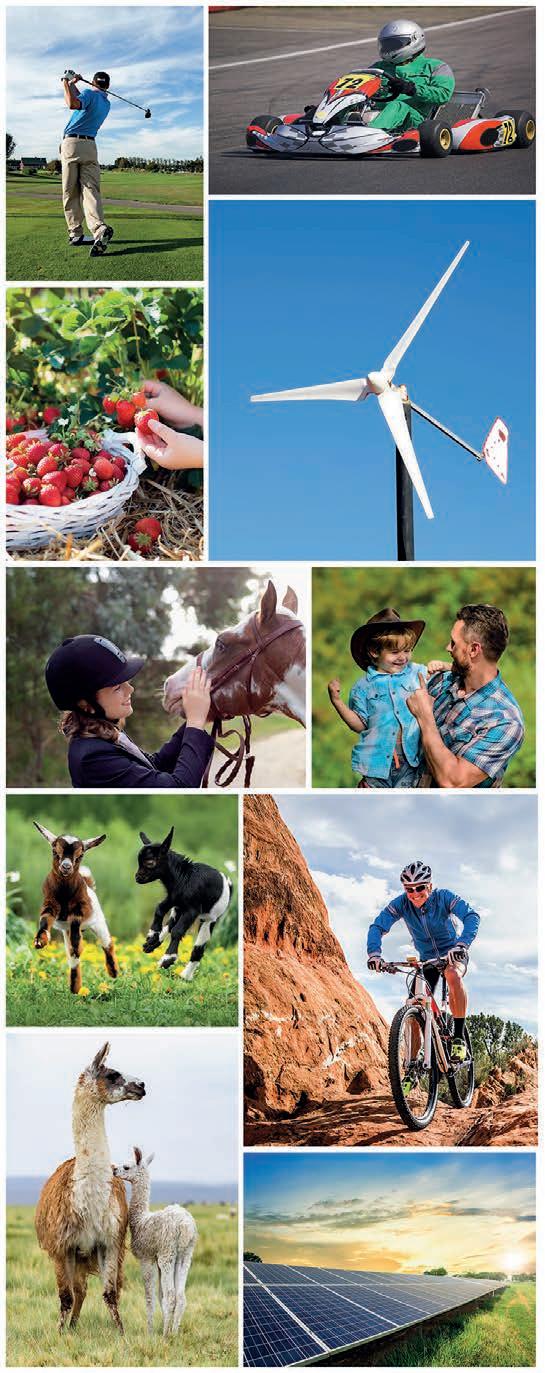


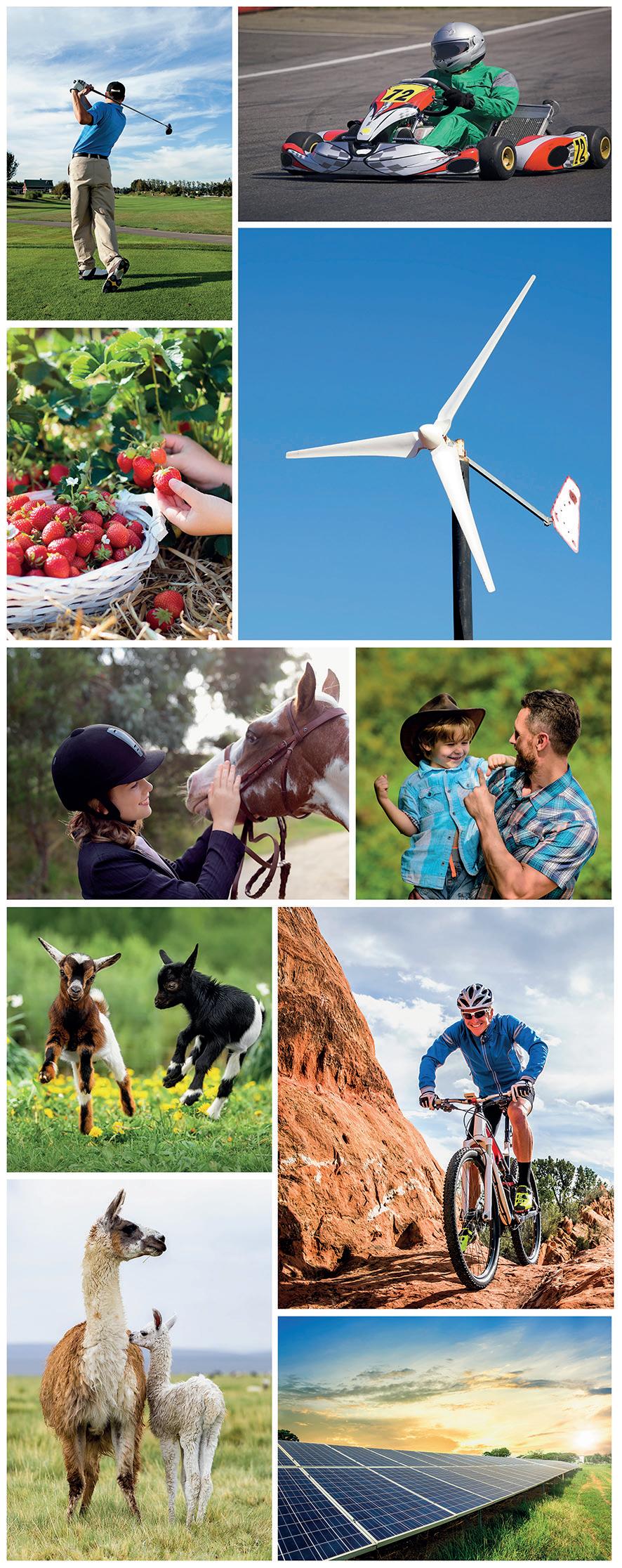















exhibitors would
recommend the show to others
visit: farmbusinessshow.co.uk or Contact us to book your stand today THE UKS PREMIER EVENT FOR FARMERS AND LANDOWNERS BUSINESS 15-16 NOV 2023 NEC BIRMINGHAM THIS EVENT RUNS ALONGSIDE:
of
highly
62 %
GREAT TASTE OF THE COUNTRY
FIGURES FROM 2022 SHOW
Come day or night, rain or shine, the well-being of your herd is what drives you, and you put everything into keeping them healthy and productive. METACAM® is proud to partner with cattle farmers to provide proven and trusted anti-inflammatory pain relief for mastitis management,* respiratory infections,* diarrhoea in young calves† and pain relief following dehorning and disbudding. You’re all in, and we are too.

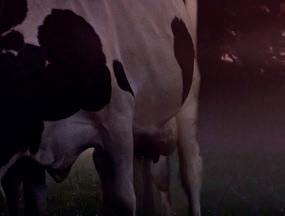


To learn more about METACAM®, speak to your veterinarian.
AND YOU’RE ALL IN Supporting cattle well-being














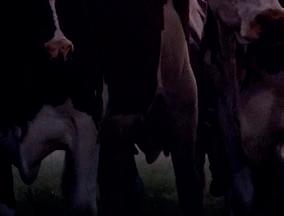













04:53 AM *With appropriate antibiotic therapy. † In calves over one week of age in combination with oral rehydration therapy. Metacam® 20 mg/ml solution for injection for cattle, pigs and horses and Metacam® 40 mg/ml solution for injection for cattle and horses contain meloxicam. UK: POM-V . Advice should be sought from the prescriber. Further information available in the SPCs or from Boehringer Ingelheim Animal Health UK Ltd., RG12 8YS, UK. UK Tel: 01344 746957. Email:vetenquiries@boehringer-ingelheim. com. Metacam® is a registered trademark of Boehringer Ingelheim Vetmedica GmbH, used under licence. ©2021 Boehringer Ingelheim Animal Health UK Ltd. All rights reserved. Date of preparation: Dec 2021. BOV-0201-2021 Use Medicines Responsibly 384200















































































































































































































































































































































































































































































































































































 PAUL REDMORE
PAUL REDMORE






























































































































































